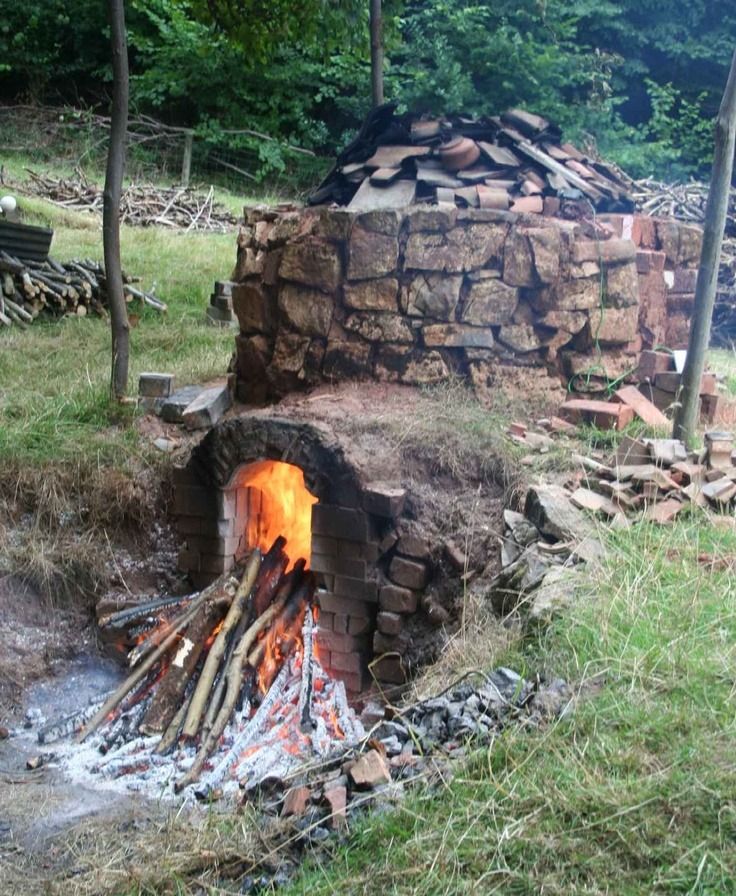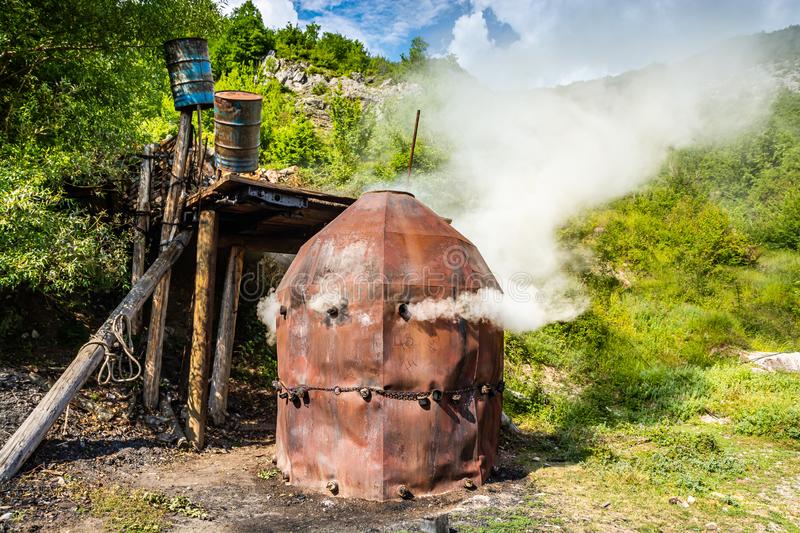CLOUDS OF REASON
THIS IS A THOUGHT CHART; IN THE CONTEXT OF A RESEARCH PROJECT AT THE ROYAL ACADAMY OF ANTWERP. THE FOCUS IS ON GENERATIVE WAYS OF PHOTOGRAPHIC MATERIALISATION WITH (A)BIOTIC MATTERS, MOVING AWAY FROM A PHOTOGRAPHIC GAZE AND PHOTOGRAPHICALY LEARNING FROM WORLD(S) WITHIN.
If you want to get in touch about some content you think my eyes, fingers, ears, mouth and mind would like to digest, please do.
Youth of delight, come hither
And see the opening morn,
Image of thruth new born
Doubt is fled & clouds of reason,
Dark disputes & artful teazing.
Folly is an endless maze,
Tangled roots perplex her ways.
How many have fallen there!
And feel they know what but care;
And wish to lead others when they shoud be led.
- William Blake
If you want to get in touch about some content you think my eyes, fingers, ears, mouth and mind would like to digest, please do.
The Voice of the Ancient Bard
Youth of delight, come hither
And see the opening morn,
Image of thruth new born
Doubt is fled & clouds of reason,
Dark disputes & artful teazing.
Folly is an endless maze,
Tangled roots perplex her ways.
How many have fallen there!
And feel they know what but care;
And wish to lead others when they shoud be led.
- William Blake
ARTISTIC PRACTICE COLLECTION
![]()
![]()
Hippolyte Bayard, Album d'essais, 1839. Collection Société française de photographie (SFP)
Hippolyte Bayard (1801 - 1887) is a pioneer of photography. A founding member of the French Society of Photography, he became its general secretary. Inventor of the direct positive process on paper, he also devoted himself to daguerreotype and then practiced the negative on paper. Its collection is kept at the SFP in Paris.
IT

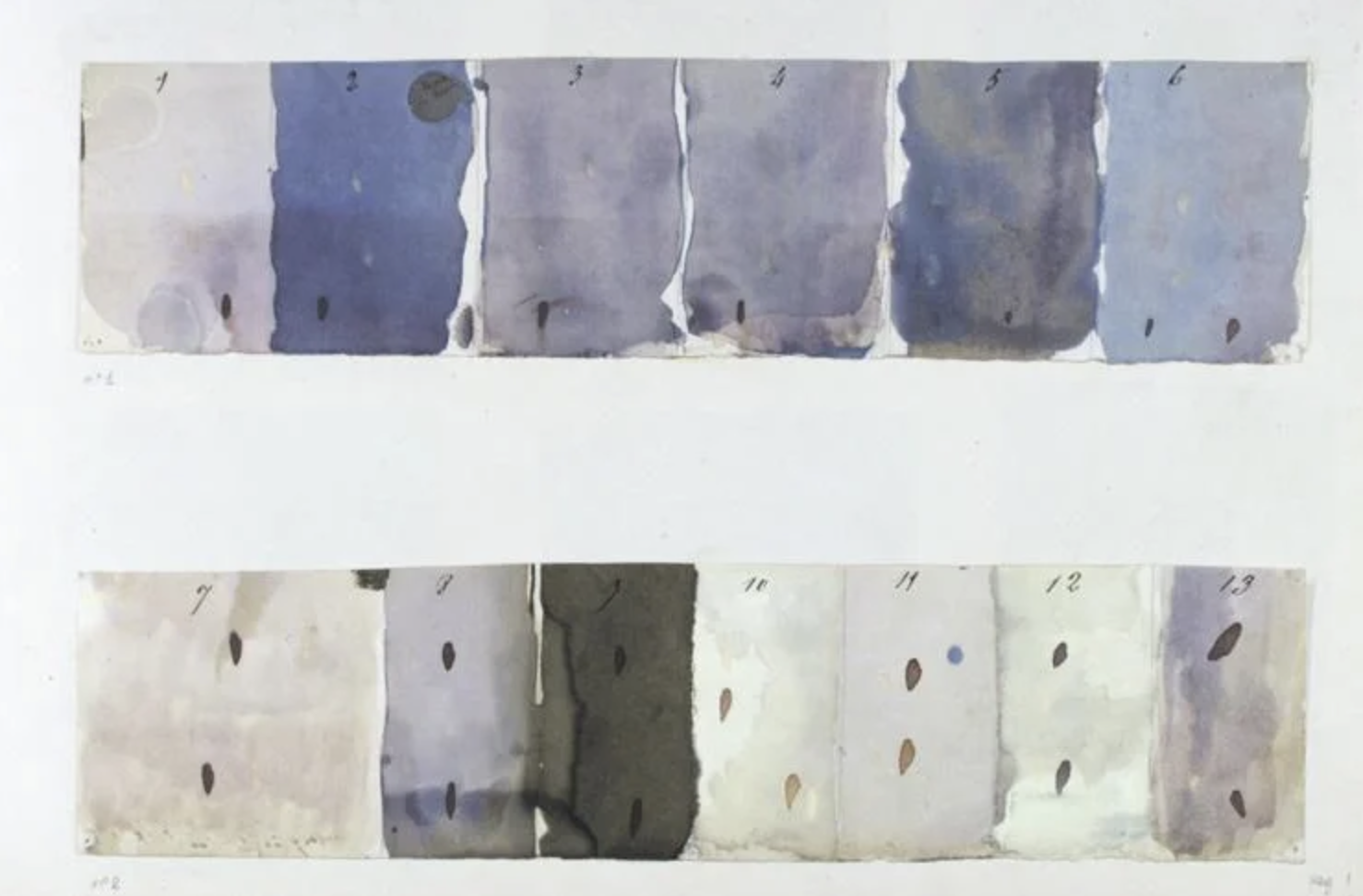
Hippolyte Bayard, Album d'essais, 1839. Collection Société française de photographie (SFP)
Hippolyte Bayard (1801 - 1887) is a pioneer of photography. A founding member of the French Society of Photography, he became its general secretary. Inventor of the direct positive process on paper, he also devoted himself to daguerreotype and then practiced the negative on paper. Its collection is kept at the SFP in Paris.
IT
MATTERS
HOW
MATTER
COMES
TO
MATTER
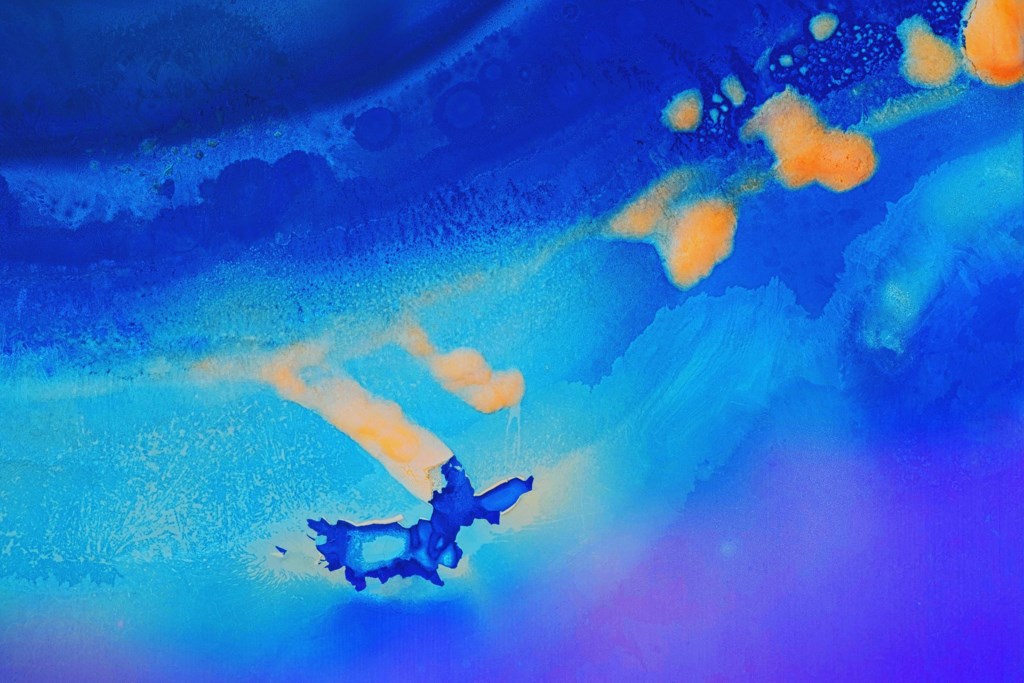

Jos Coenen, Fumarol reactions on copper plates, (no size indication)
Fumaroles, openings from which hot sulfur vapors, among other things, escaped, formed on the surface of the red terril. Coenen laid copper plates on or under the fumaroles. After a few weeks, the salt and sulfur deposits that found their way out from the hot and smoking belly of the slag heap formed surprising images on the metal support. No more carbon black and ash gray, but a radiant color palette.
Karel Doing, The Mulch Spider's Dream, 16m, 14 minutes, colour, 2018 |
By using plants, mud and salt in conjunction with alternative photochemistry, images are 'grown' on motion picture film. What at first glance is perceived as abstract turns out to be a concrete precipitation from phenomena that surround us in everyday life. The 'aliveness' of the images is underlined by Andrea Szigetvári's evocative sound-design.
Stan Brakhage, Mothlight, 1963
 Various and Casual Occursions, Anna Ridler and Sofia Crespo, 2023, phytogram
Various and Casual Occursions, Anna Ridler and Sofia Crespo, 2023, phytogramA large part of this project was exploring different forms of digital and analogue experimental photography – not just neural nets, but also one of the earliest forms of cameraless photography, photograms. Using a technique pioneered by Karel Doing, we used the chlorophyll in the plants, taken from each of their gardens in Lisbon and London, to develop the images, so that no chemicals were used. The resulting photofloral tracings, impressions of the interactions of flora, chemistries, and light were then digitised and used as input data for neural networks, adding a hybrid dimension to the resulting works.
 Arja Hop & Peter Svenson, Florachromes, 2015, analogue C-print
Arja Hop & Peter Svenson, Florachromes, 2015, analogue C-printWithin a certain geographical area, Hop & Svenson take samples of the plants growing there. They then extract juices from these using traditional methods. The duo developed their own method to convert the plant residues directly into analogue photographic prints. Each residue results in a unique layered colour tone. By presenting these photographic colour patches in a tight matrix, Hop and Svenson generate, as it were, a sample map of a specific environment with various gradations of tones from the colour spectrum. Each photo tells the bio-chromatic story of a specific plant and place; it seems that the intensity of the plant colour is strongly influenced by the living conditions of the plant.
 Daisuke Yokota, Untitled, 2015, 90×72 cm, Archival Pigment Print
Daisuke Yokota, Untitled, 2015, 90×72 cm, Archival Pigment Print“A photograph without the intervention of human perception is just a material, but when a human being sees it and thinks about it at a certain time and place, the photograph becomes an interesting phenomenon. To think about photography is to think about the human being theirself.”
- Daisuke Yokota

Dries Segers, Kirlian Leaf, 2022, unfinshed project
Kirlian photography is a way to create images of coronal discharges around an object. A coronal discharge is an electrical discharge caused by the ionization of gas or fluid surrounding an object. This technique is also used in paranoramal science.
 Marjolijn Dijkman, Earthing Discharge #8, 2021 (coal), Fujiflex print, 110 x 100 cm
Marjolijn Dijkman, Earthing Discharge #8, 2021 (coal), Fujiflex print, 110 x 100 cm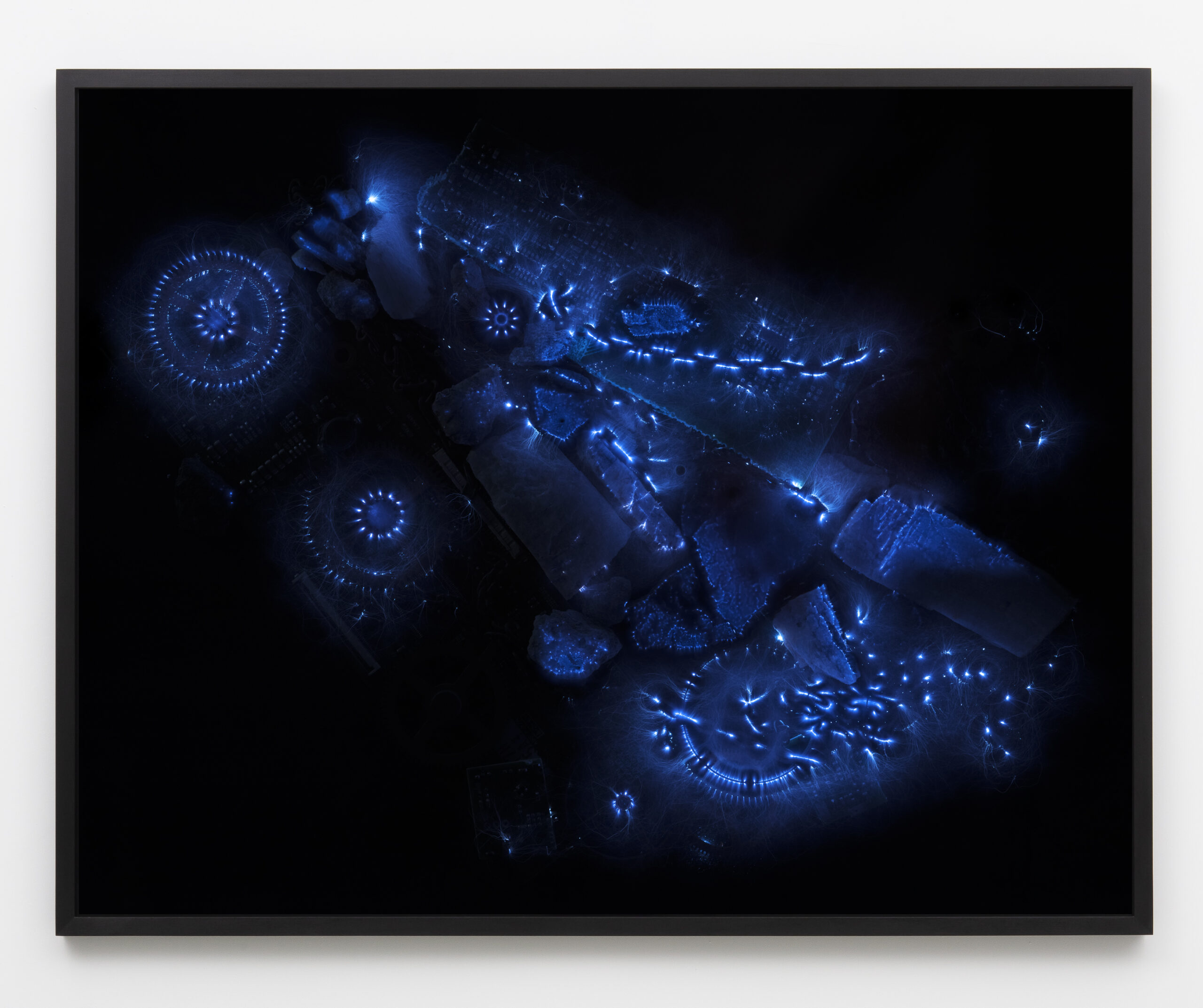
Marjolijn Dijkman, Earthing Discharge #7, 2021 (e-waste, coal, spodumene with lithium), Fujiflex print, 110 x 140 cm
Depth of Discharge is depicting items associated with technology and energy use —minerals, circuit boards, and personal devices. Dijkman’s labor-intensive process involves activating the conductive matter using high voltage electricity and photographing them through conductive glass used in touchscreen technologies.

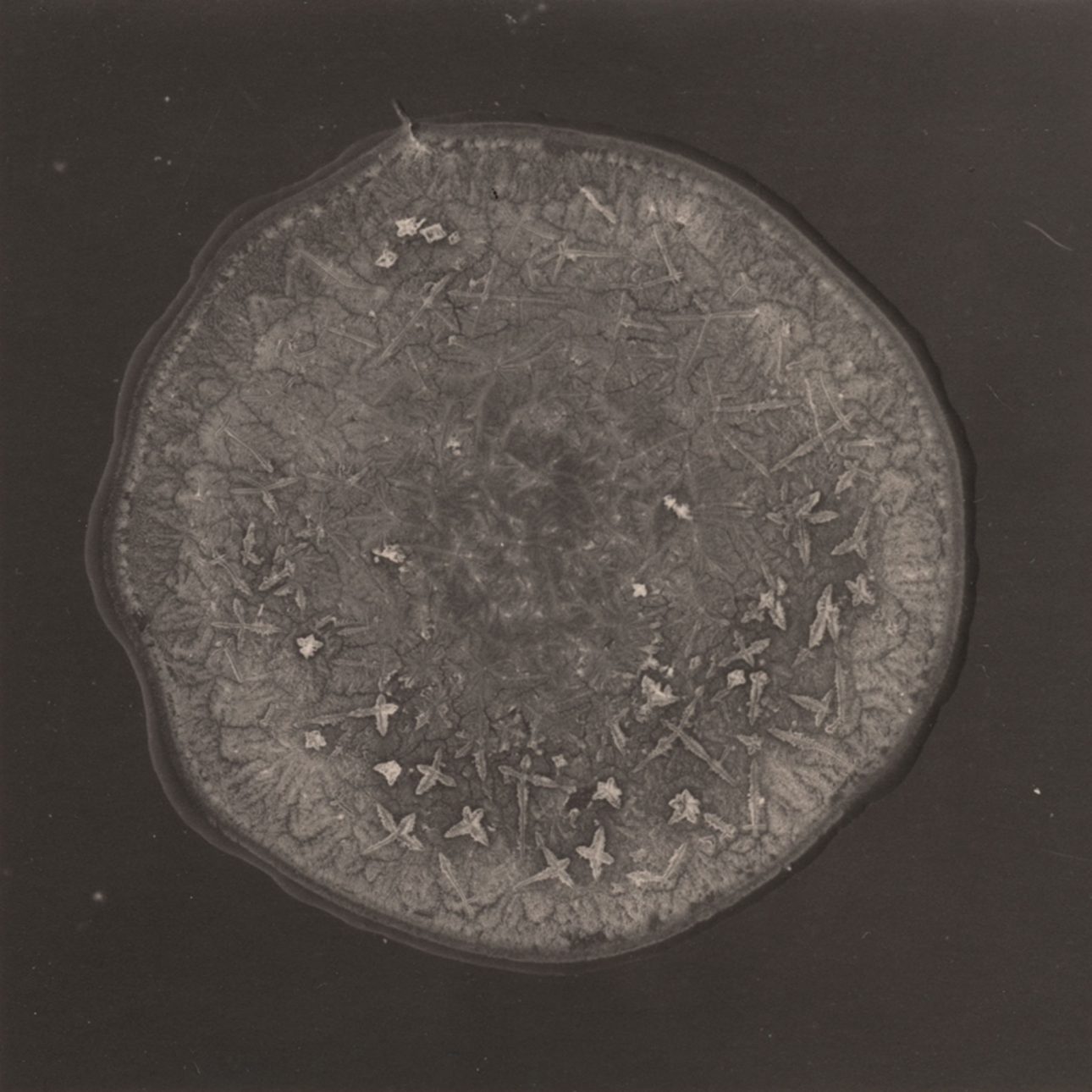
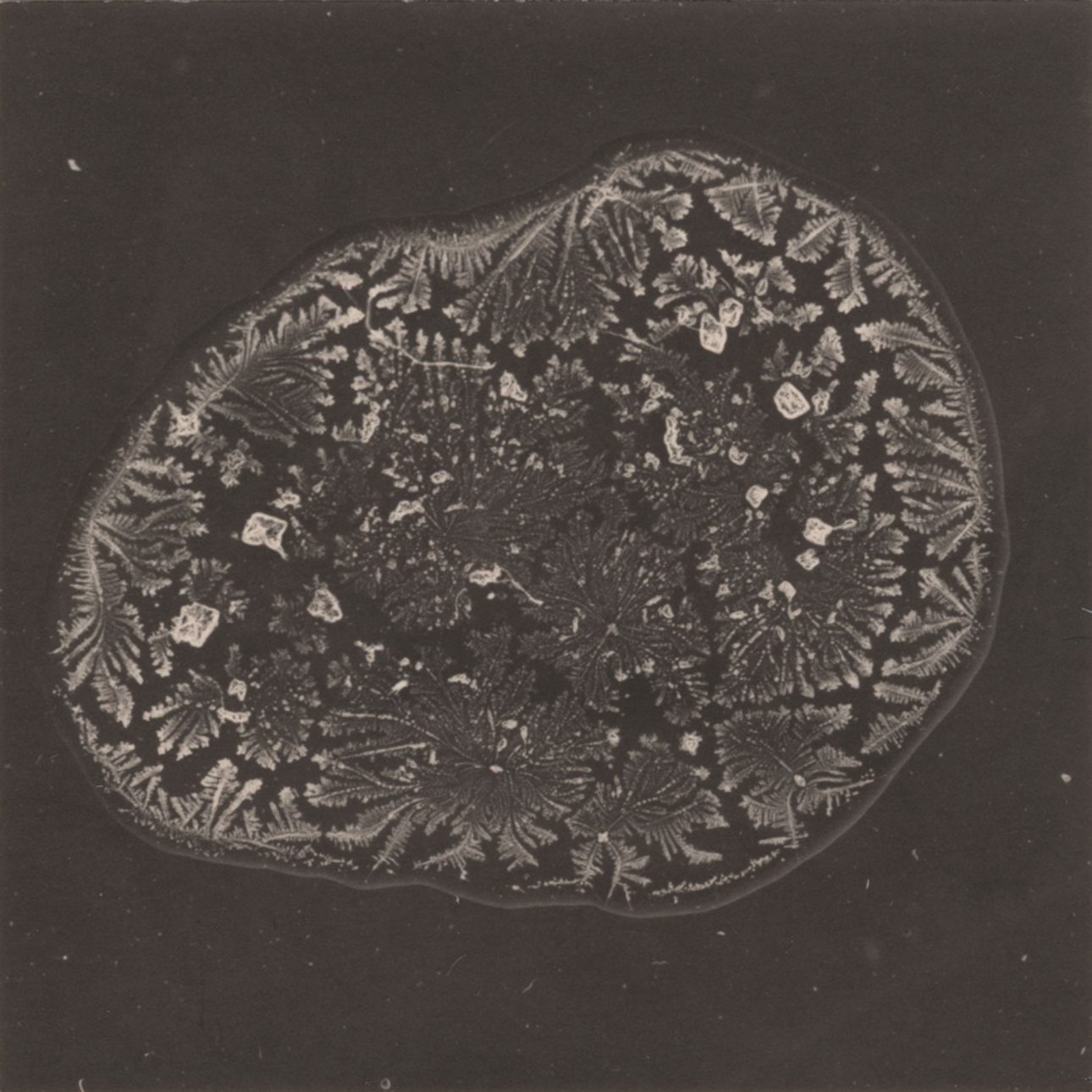
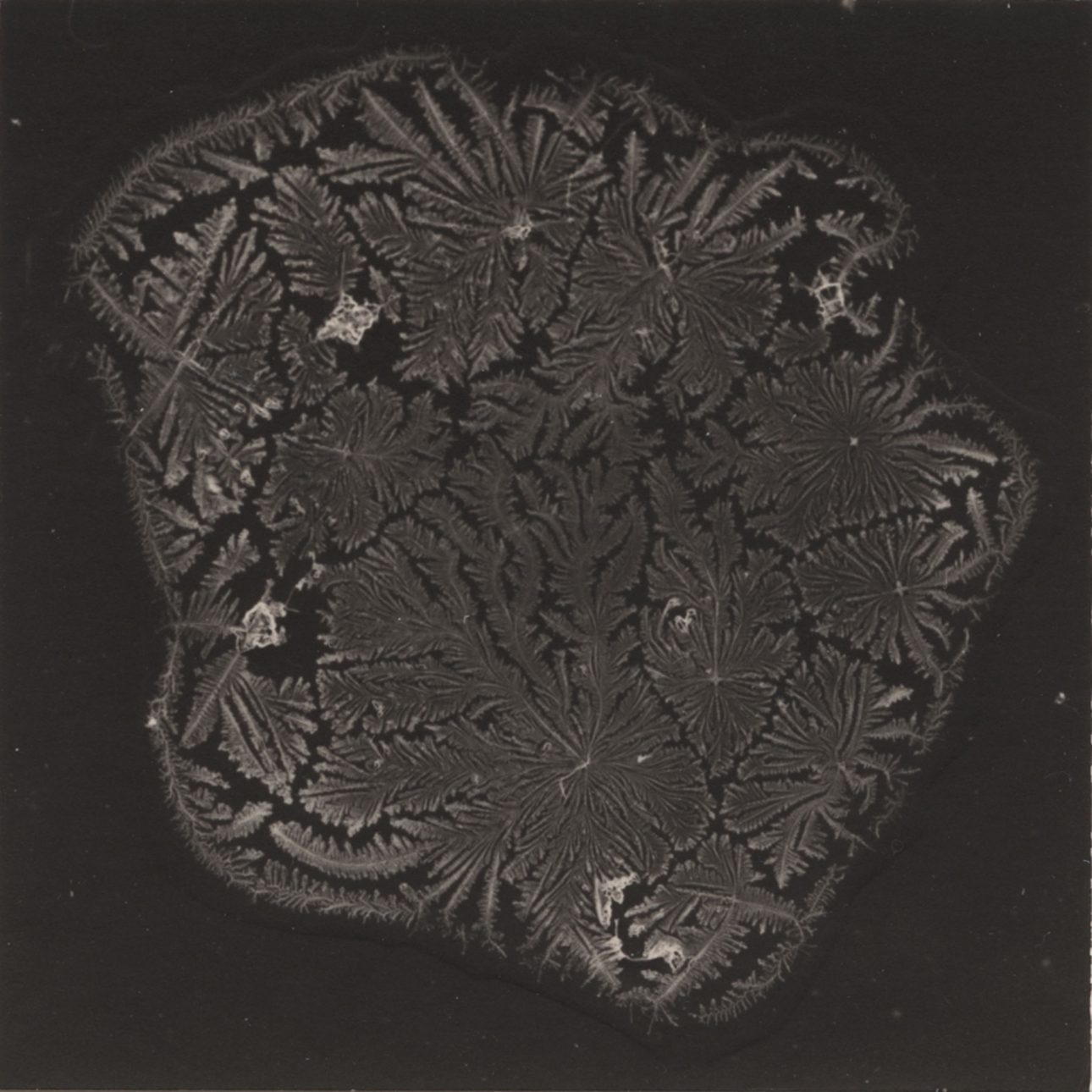
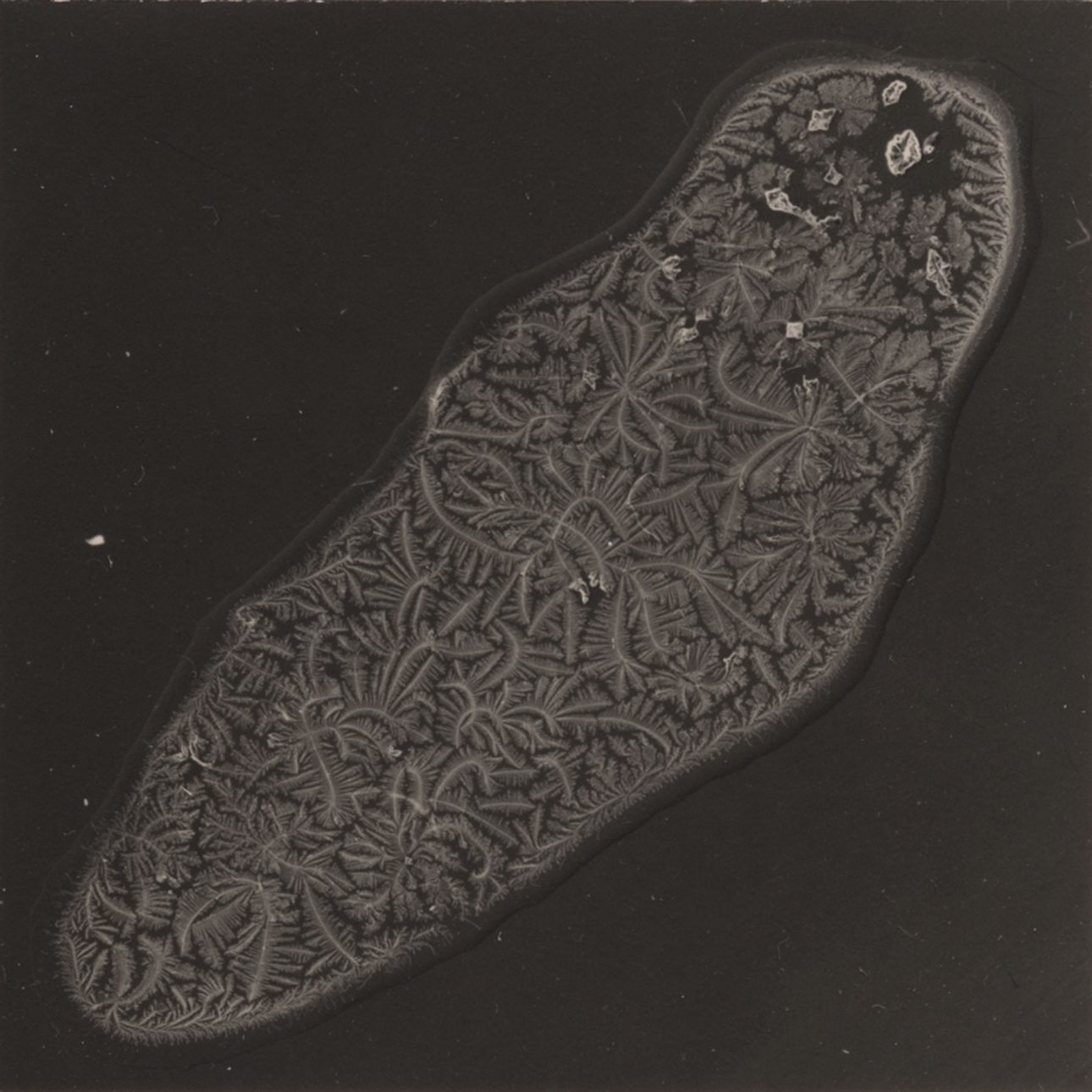
Babs Decruyenaere, Random connection #6: Emotional remnant, 2017, 50x65 cm, gelatin silver print
Decruyenaere saved tears and dried them for eternity on a glass slide, later she made some contactprints. out of it. “It was trial and error: sometimes the tear crystallised really beautifully and sometimes not at all. It wasn’t clear to me which factors were responsible for the way the tear would crystallise, but that didn’t concern me. Because of the quick drying and eventual evaporation of the tear, the trick was to develop the image quickly during the brief moment that the crystallisation was at its most beautiful.”
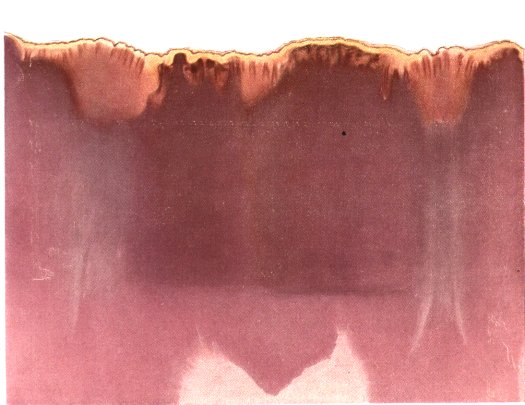
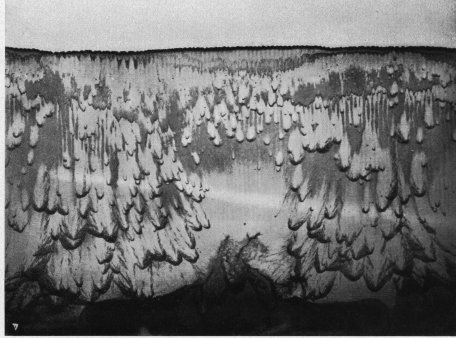
Lili Kolisko, Filter paper experiments with silver nitrate, 1936
One of the tests Lili Kolisko ran involved the simultaneous use of Gold Chloride and Silver Nitrate as a test solution, Gold reflecting the Sun forces and Silver the Moon. She used filter lab paper to allowed any solution to rise up the paper until it is all absorbed. The paper subdivides the substance inside of its material.
 Steffie de Gaetano, Permeance, 2022, distorted soil chromatography
Steffie de Gaetano, Permeance, 2022, distorted soil chromatography
Alice Miceli, fragment of a field III – 9.120 µSv (07.05.09 – 21.07.09), backlight and radiographic negative
Projeto Chernobyl has made the destructive energy visible through a series of radiographic negatives, which were exposed in the Chernobyl Exclusion Zone for months at a time. The project captures a hunting archive of the environmental threat that remains, thirty years after the cathastrophe.

Risk Hazekamp, Experiment, analogue film is fed to cyanobacteria, installation STROOM Den Haag

Risk Hazekamp, unlearing photography, 2021-22
Photograph created by Cyanobacteria interacting with analogue photographic material, such as film negatives, photographic papers or glass film carriers.





This light meter generates and transforms over time by the usage.
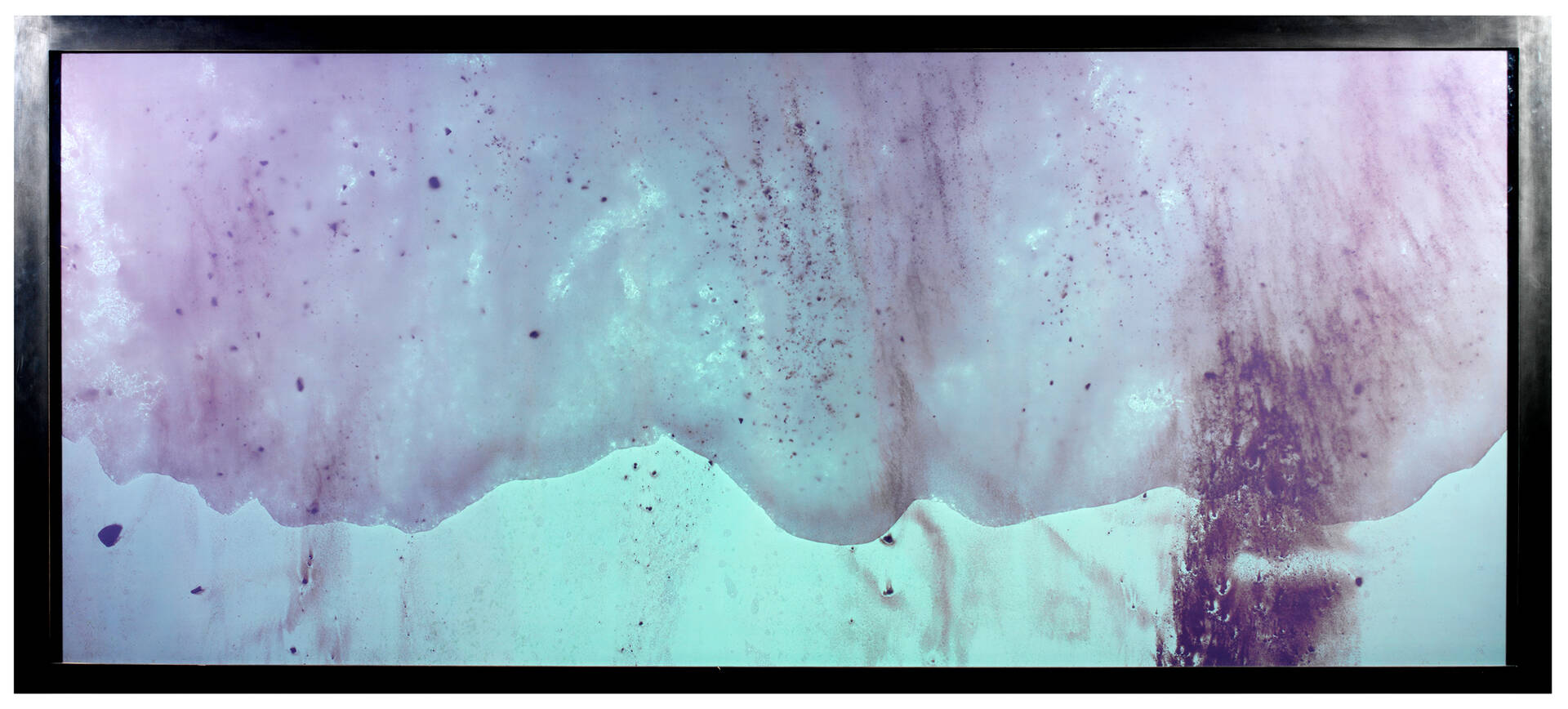
During the 1990s, Susan Derges (born 1955) became well known for her photograms of water. To make these works, she used the landscape at night as her darkroom, submerging large sheets of photographic paper in rivers and using the moon and flashlight to create the exposure.
ARTISTIC PRACTICE COLLECTION
![]()
Full-length photograph of the Shroud of Turin which is said to have been the cloth placed on Jesus at the time of his burial.
Paul Vignon developed a “vaporographic” theory in 1902 of the image’s production of the Shroud of Turin: urea (NH₂)₂CO in the sweat from Christ’s body changed into ammonia, releases ammoniac vapor, which mixes with the vapors produced by the aloe and spices used by Joseph of Arimathea and Nicodemus to embalm the corpse, and these vapors, trapped between the body and the linen cloth, create the image.

Full-length photograph of the Shroud of Turin which is said to have been the cloth placed on Jesus at the time of his burial.
Paul Vignon developed a “vaporographic” theory in 1902 of the image’s production of the Shroud of Turin: urea (NH₂)₂CO in the sweat from Christ’s body changed into ammonia, releases ammoniac vapor, which mixes with the vapors produced by the aloe and spices used by Joseph of Arimathea and Nicodemus to embalm the corpse, and these vapors, trapped between the body and the linen cloth, create the image.
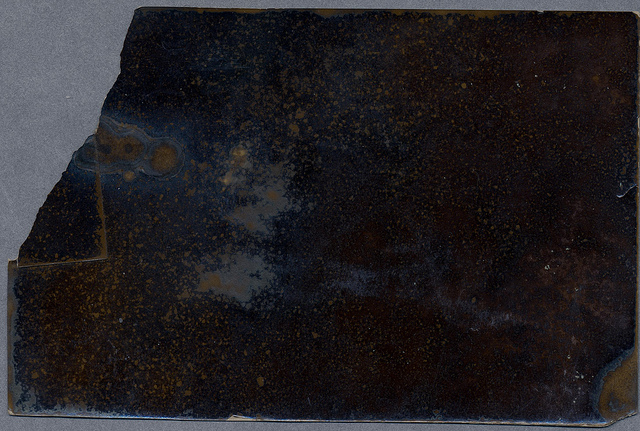
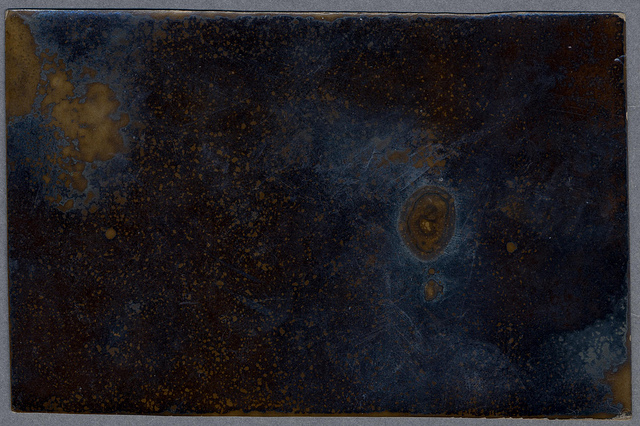


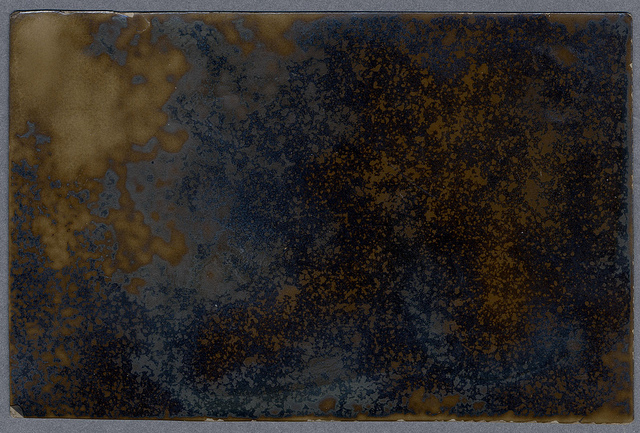
 August Strindberg, Celestograph, 1893-94, courtesy National Library of Sweden
August Strindberg, Celestograph, 1893-94, courtesy National Library of SwedenIn the village of Dornach in Austria, during the winter of 1893-4, the Swedish playwright August Strindberg laid out a series of photographic plates on the ground. Removing the “middle-man” of a camera (and even lens), using the light-sensitive plates directly, he was attempting to capture images of the night sky above.
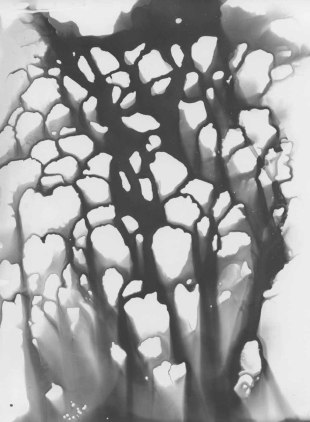
James Welling, Chemical, 2015, Black and white chemigram on Kodak Metallic Endura paper, 50.8 x 40.6 cm

Sanne Vaassen, Fractals, leaves, metal frames, diaprojectores, variable dimensions, 2018
Every day one autumn, Vaassen picked up the leaves of a single tree. This archive of leaves shows a record of time and of the natural process to which the tree is subject. Vaassen's intervention also shows the tree's natural cycle by revealing its transience in a variety of shapes, textures and colours.
 Blue Waters, Dries Segers, 2018, 248x150cm, Cyanotype on cotton.
Blue Waters, Dries Segers, 2018, 248x150cm, Cyanotype on cotton.
 Stenciled handprints and wall paintings dating back 10,000 years, some of the earliest forms of cave art.
Stenciled handprints and wall paintings dating back 10,000 years, some of the earliest forms of cave art.Cueva de las Manos is named for the hundreds of paintings of hands stenciled, in multiple collages, on the rock walls. The art was created in several waves between 7,300 BC and 700 AD, during the Archaic period of pre-Columbian South America. The age of the paintings was calculated from the remains of bone pipes used for spraying the paint on the wall of the cave to create the artwork, radiocarbon dating of the artwork, and stratigraphic dating.

Yto Barrada, Velvet collage #4, 2019, fabric mounted on board, 91.4 cm × 67.3 cm
These samplers describe the botanical, insect, or mineral sources of various colors with a special interest in the history of this lost science and art. Barrada is currently building a botanic forest garden and color research center in Tangier that connects her research into natural dyes to her practice of interventions in the city.

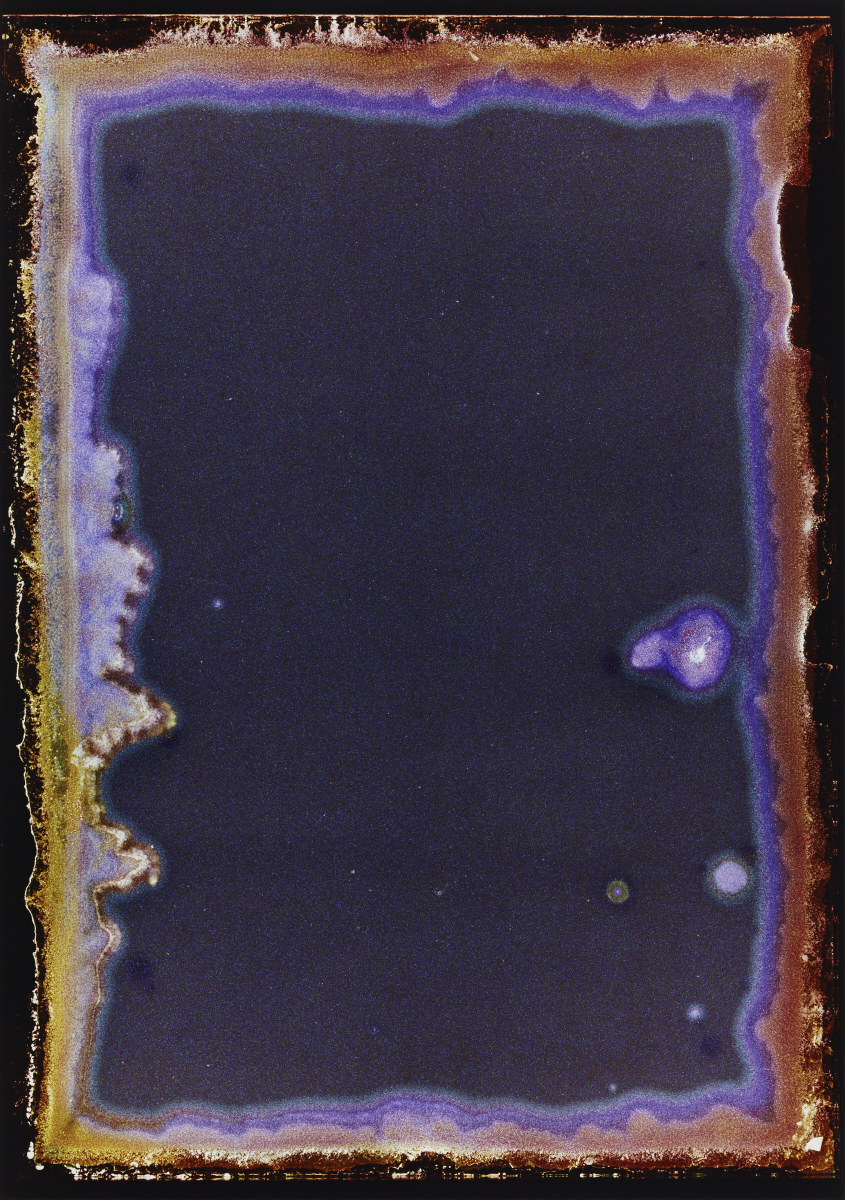


Hanako Murakami, ANTICAMERA (OF THE EYE) #P1, 2016, silver print by enlarger, 175 x 123 cm
The autochrome was a color photography technique invented by the Lumière brothers in the early days of the medium, used potato starch colored in red, blue, and green. Murakami processed and printed autochrome plates that had been unused for over a century.

Peter Miller, Firefly light, direct exposure on color paper, 2006
When color photo paper is left out in the darkroom and fireflies prance about its surface, the bioluminescent traces they leave turn up in negative.

Jochen Lempert, Glühwürmchen (Bewegung auf 35 mm Film), 2010, 4 black and white photographs, 39,5 x 241 cm
Glowworm was made in a darkened bathroom. He placed a strip of unexposed film on the counter and set the glowworm on it; the insect’s own bioluminescence exposed the film. The line you see, which appears to be an entirely abstract composition, is a direct trace of the worm’s path across four frames of film. Lempert co authored this work with his insect companion.

Scott McMahon & Ahmed Salvador, Walking firefly light, direct exposure on e6 sheet film, no lens, in a box with some grass
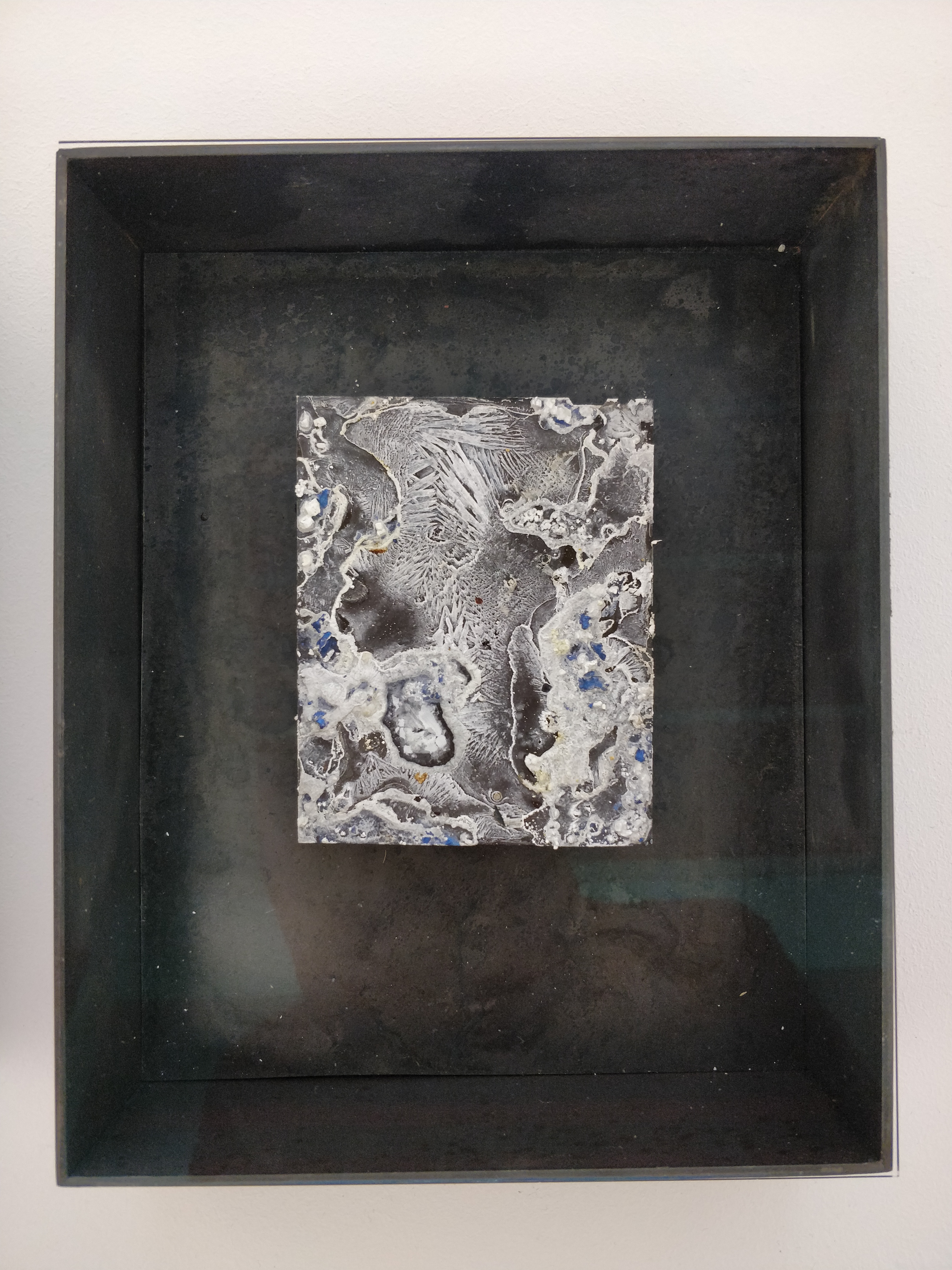

Laure Winants, Crystalized arctic seawater on negative, framed in metal box, 2023
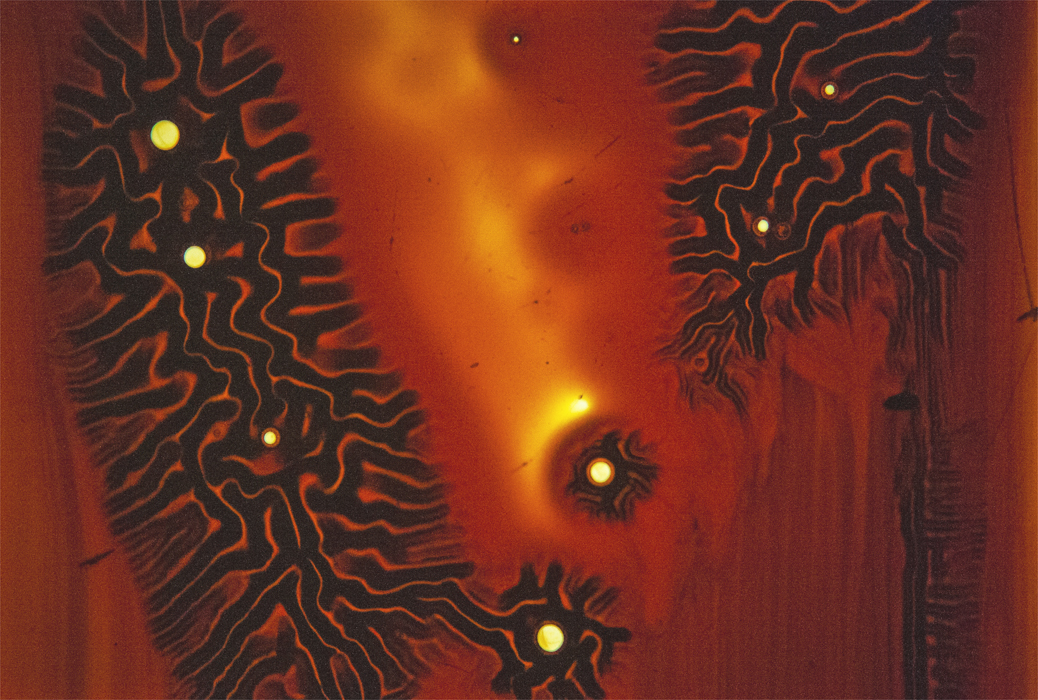
Mathias Prenen, #YU#Urushiprojection, 2014, 84 Urushi (japanese lackquer) slides, carousel projector, furniture
A series of membranes were made out of urushi lacquer without acarrier to express and exploit the transparent quality described by the character “幽”. Translating the material to another media anabled visualizing a material quality detached from its object hood. Transposing the otherwise object-tied urushi to different media shows a deeper, diverse relation with the material.

Studioview taken while conducting soil chromatography, Dries Segers, February 2022
Chromatography is a widely-used scientific technique used to separate complex compounds into their components. Ehrenfried Pfeiffer, a respected chemist and pioneer of biodynamics, developed a specific chromatographical method which produces a picture (a 'chromatogram') which shows the quality of a substance or organism. The technique can be usefully applied to research in areas such as agriculture, nutrition, soils and composts.
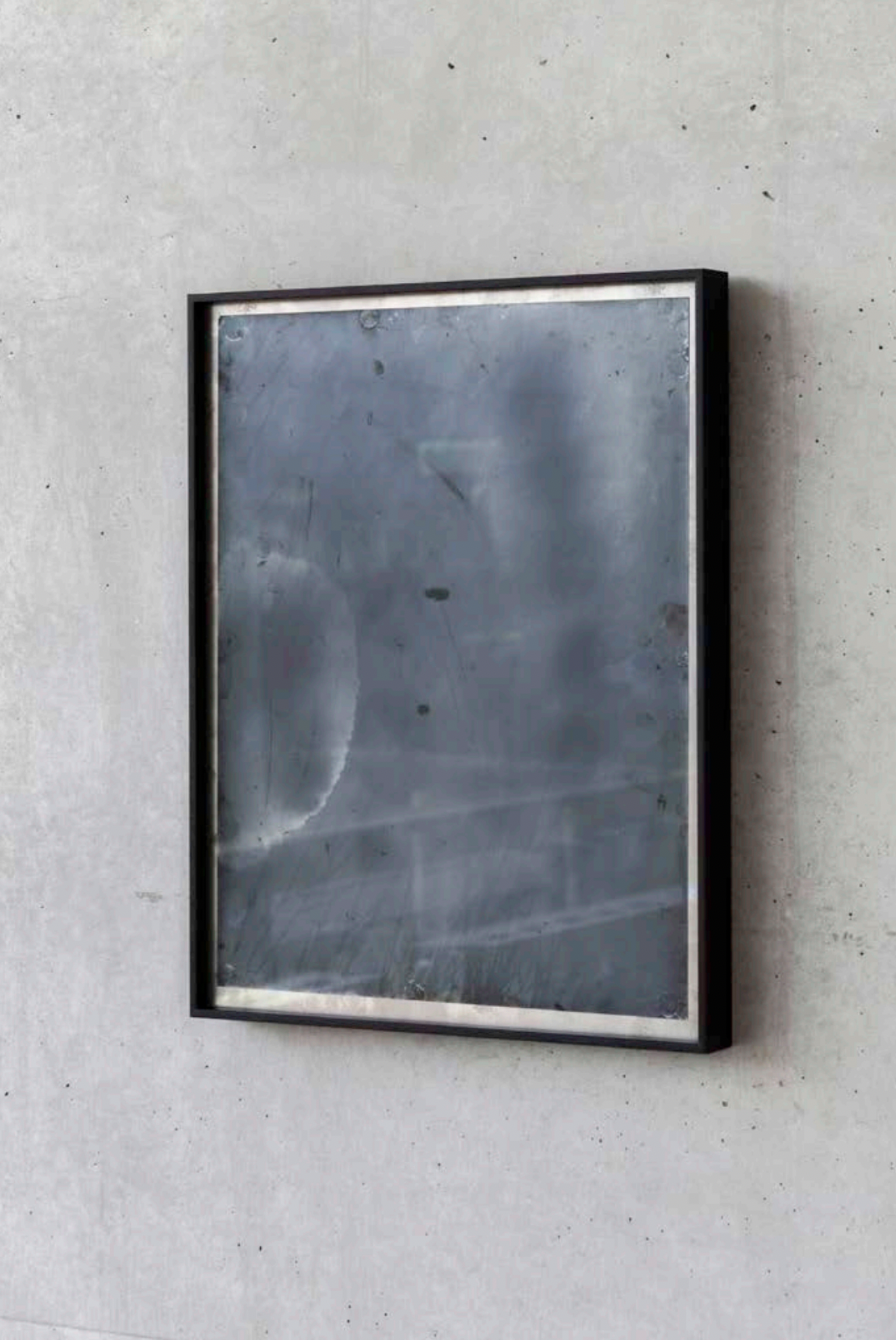
Celestography #3, Lucas Lefler, 2019, silver gelatine photo paper leaked by moon-light, oxydized by sulfure components
 Lucy Raven, Untitled, 2021, Shadowgram; Silver gelatin contact print
Lucy Raven, Untitled, 2021, Shadowgram; Silver gelatin contact printThey document the shockwaves of exploded raw materials on large format photosensitive paper and negative film. To achieve this, Raven built a room-sized black box that acted as a camera inside the ballistic sciences lab of the New Mexico Tech University. In it she fashioned a lighting mechanism that triggers a stroboscopic flash timed to the exact moment of detonation, precisely capturing the exploded materials as they travel at mach speed (a unit indicating the speed of sound, named after the Austrian physicist Ernst Mach (1838-1916)). The resulting images bear a faint resemblance to the first visualisation of the shockwaves of a bullet, recorded in 1887 by Mach. But rather than pointing to the trajectory of a single bullet, Raven unleashes an array of different materials, each generating a series of interacting shocks and turbulent wakes.
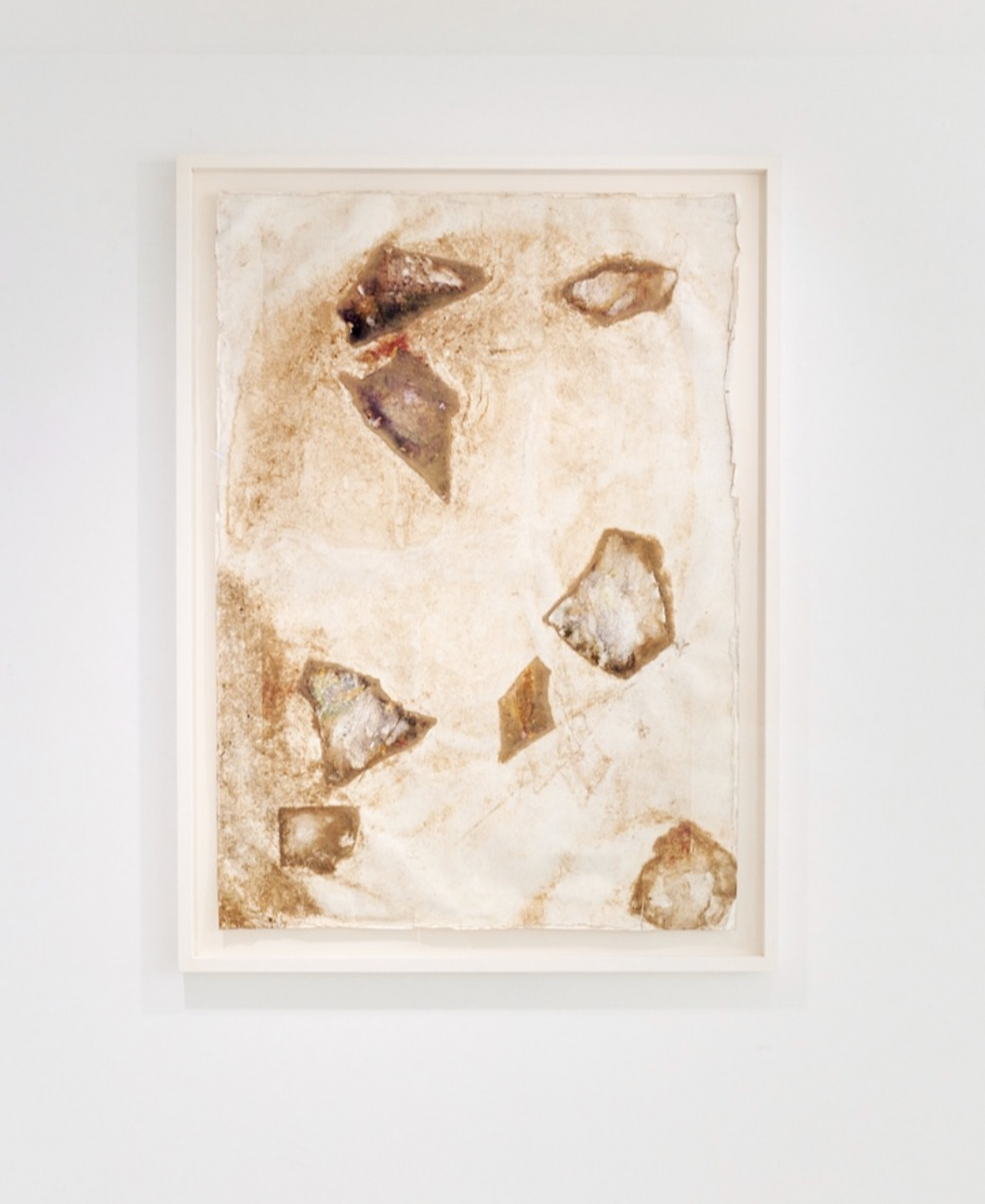 Douglas Mandry, Blind Thrust Faults, 2024 - '06-11072023-22072024', Sun-bleached chromogenic prints, dust, micro-organism, 90 x 120 cm, unique
Douglas Mandry, Blind Thrust Faults, 2024 - '06-11072023-22072024', Sun-bleached chromogenic prints, dust, micro-organism, 90 x 120 cm, unique Eileen Quilan, Top Down, 2013
Eileen Quilan, Top Down, 2013Gelatin silver photogaphic film left in acid baths to rot, then developed and printed.
ARTISTIC PRACTICE COLLECTION
![]()
In 1855 German chemist Friedlieb Ferdinand Runge self-published Der Bildungstrieb der Stoffe, veranschaulicht in selbstständig gewachsenen Bilder, illustrating images produced when placed drops of reactant solutions on blotting paper and then added a drop of a second reactant solution on top of the first drop. The solutions would react as they spread through the blotting paper, often producing colored patterns. The work included 60 chromatograms mounted on 31 leaves, along with separately printed caption paragraphs which were also pasted onto the leaves of the album.
![]()
Pierre Cordier, Chimigramme 1971, Chemigram on photographic paper, 59,5 x 49,3 cm
On November 10, 1956, Pierre Cordier invented the chemigram technique that combines the physics of painting (varnish, wax, oil) and the chemistry of photography (photosensitive emulsion, developer, fixer) while manipulating them in full light.

In 1855 German chemist Friedlieb Ferdinand Runge self-published Der Bildungstrieb der Stoffe, veranschaulicht in selbstständig gewachsenen Bilder, illustrating images produced when placed drops of reactant solutions on blotting paper and then added a drop of a second reactant solution on top of the first drop. The solutions would react as they spread through the blotting paper, often producing colored patterns. The work included 60 chromatograms mounted on 31 leaves, along with separately printed caption paragraphs which were also pasted onto the leaves of the album.

Pierre Cordier, Chimigramme 1971, Chemigram on photographic paper, 59,5 x 49,3 cm
On November 10, 1956, Pierre Cordier invented the chemigram technique that combines the physics of painting (varnish, wax, oil) and the chemistry of photography (photosensitive emulsion, developer, fixer) while manipulating them in full light.
Ask your hands to know the things they hold
- Kae Tempest

Etienne Trouvelot, Trouvelot figure, albumen print, 1880
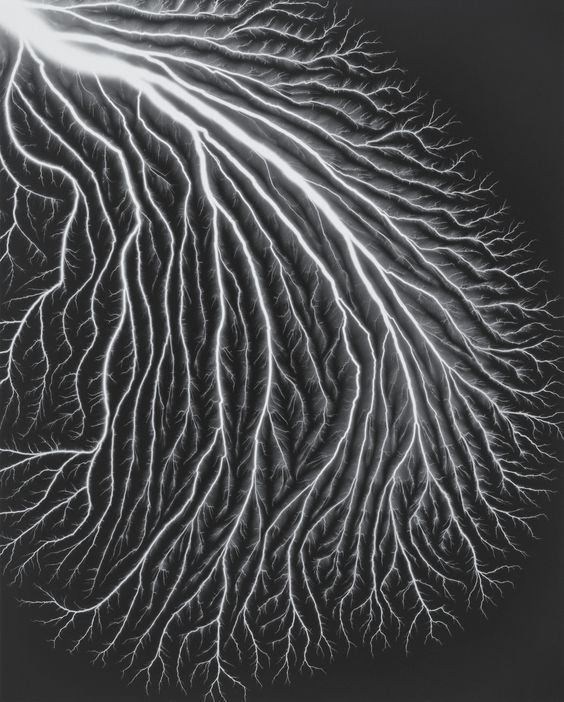

Hiroshi Sugimoto, Lightning Field series, 2009 - ...
In 2008, acclaimed japanese photographer Hiroshi Sugimoto bypassed the use of his camera and exposed his Lightning Field series directly onto film. In order to witness what early scientists like Benjamin Franklin saw upon the discovery of electricity, Sugimoto used a Van de Graaf generator to send up to 400,000 volts through film to a metal table.
‘The resulting fractal branching, subtle feathering, and furry whorls call to mind vascular systems, geologic features, and trees. “I see the spark of life itself, the lightning that struck the primordial ooze,” Sugimoto says. Although some of the effects happen by chance, the artist does try to exercise control. “I have a kitchen’s worth of utensils that produce sparks with different characteristics,” he says. “But there are many variables — weather, humidity, perhaps even what I had for breakfast — I’m never sure what influences the results.” - Jon J. Eilenberg
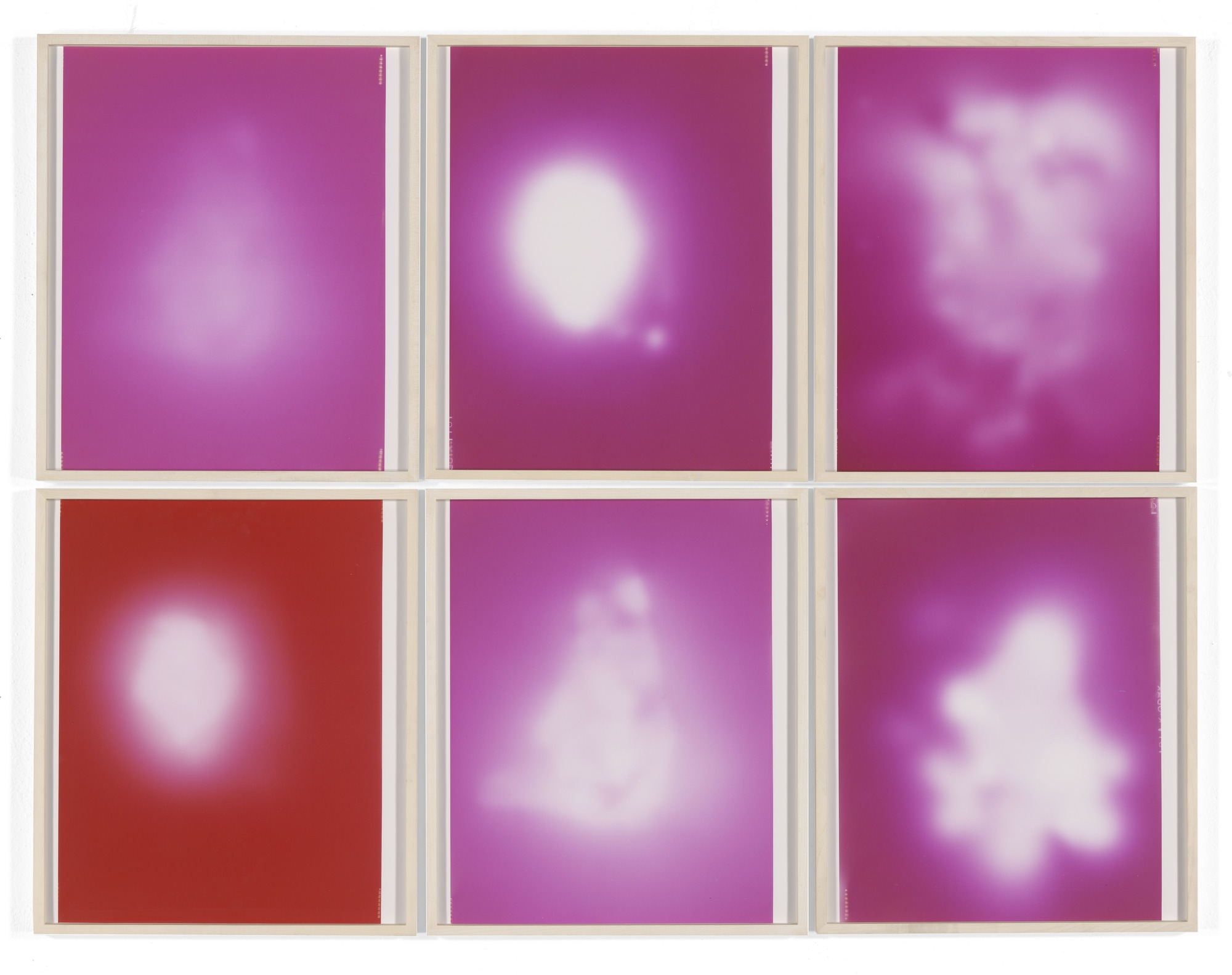
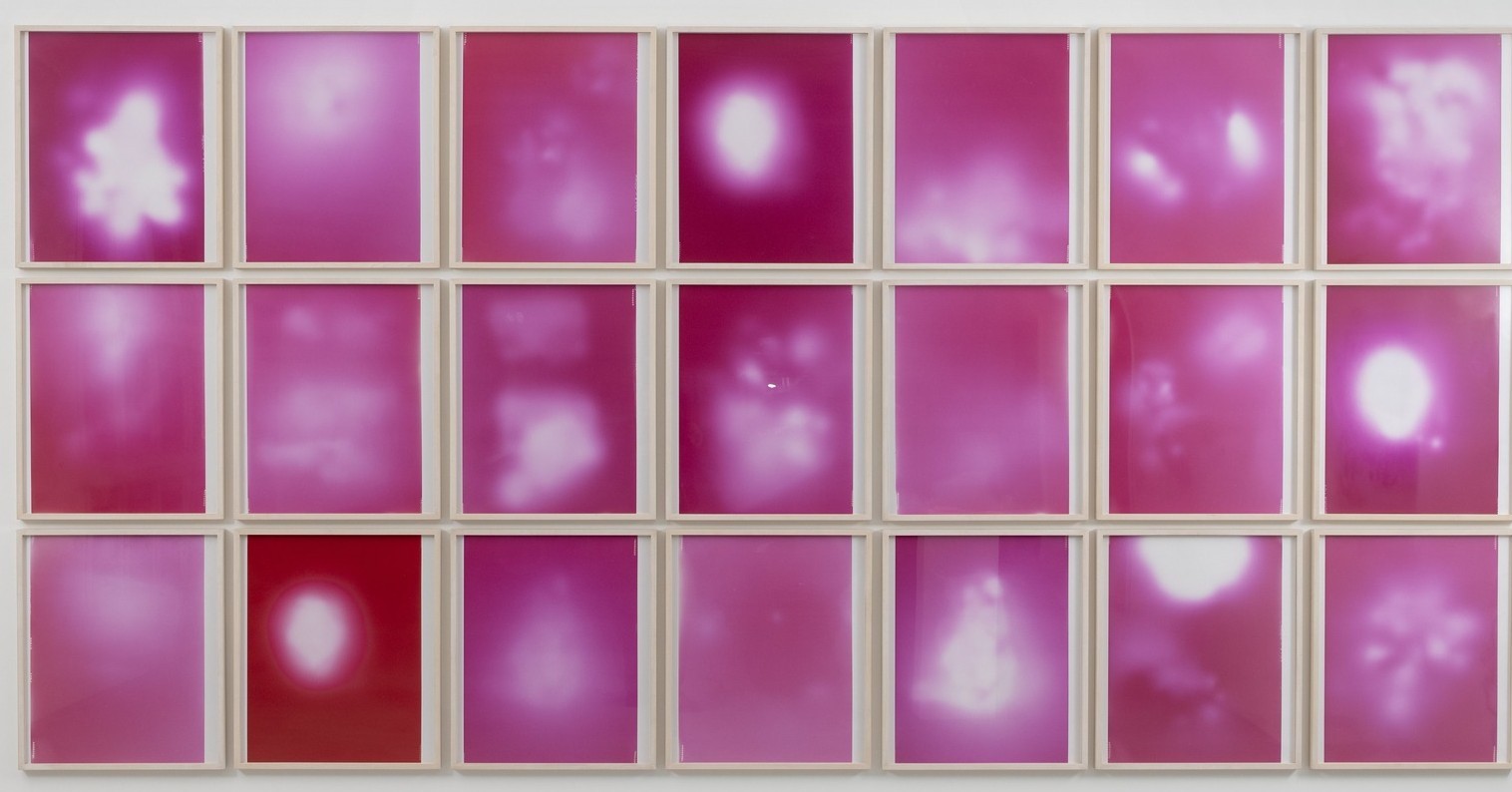
Sigmar Polke, Urangestein (rosa) (Uranium [Pink]), 1992, twenty-one chromogenic color prints, each 59.2 × 44.9 cm, Hesta Collection, Switzerland © The Estate of Sigmar Polke, Cologne / VG Bild-Kunst, Bonn 2021
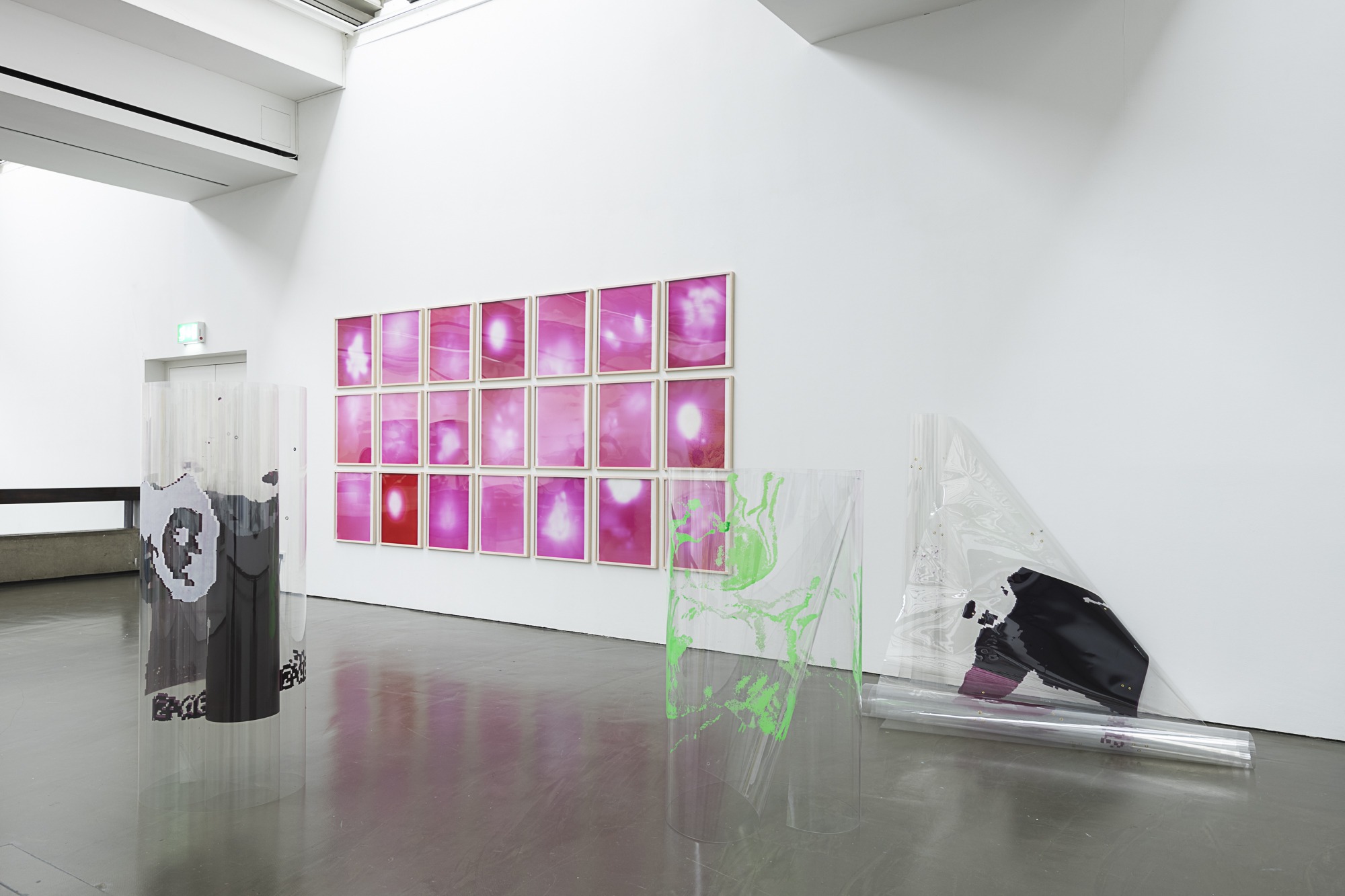
VG Bild-Kunst, Bonn 2021, installation view Kunsthalle Düsseldorf, 2021, Photo: Katja Illner

Charles Darwin, Fig 45. The Power of movement in Plants, 1880

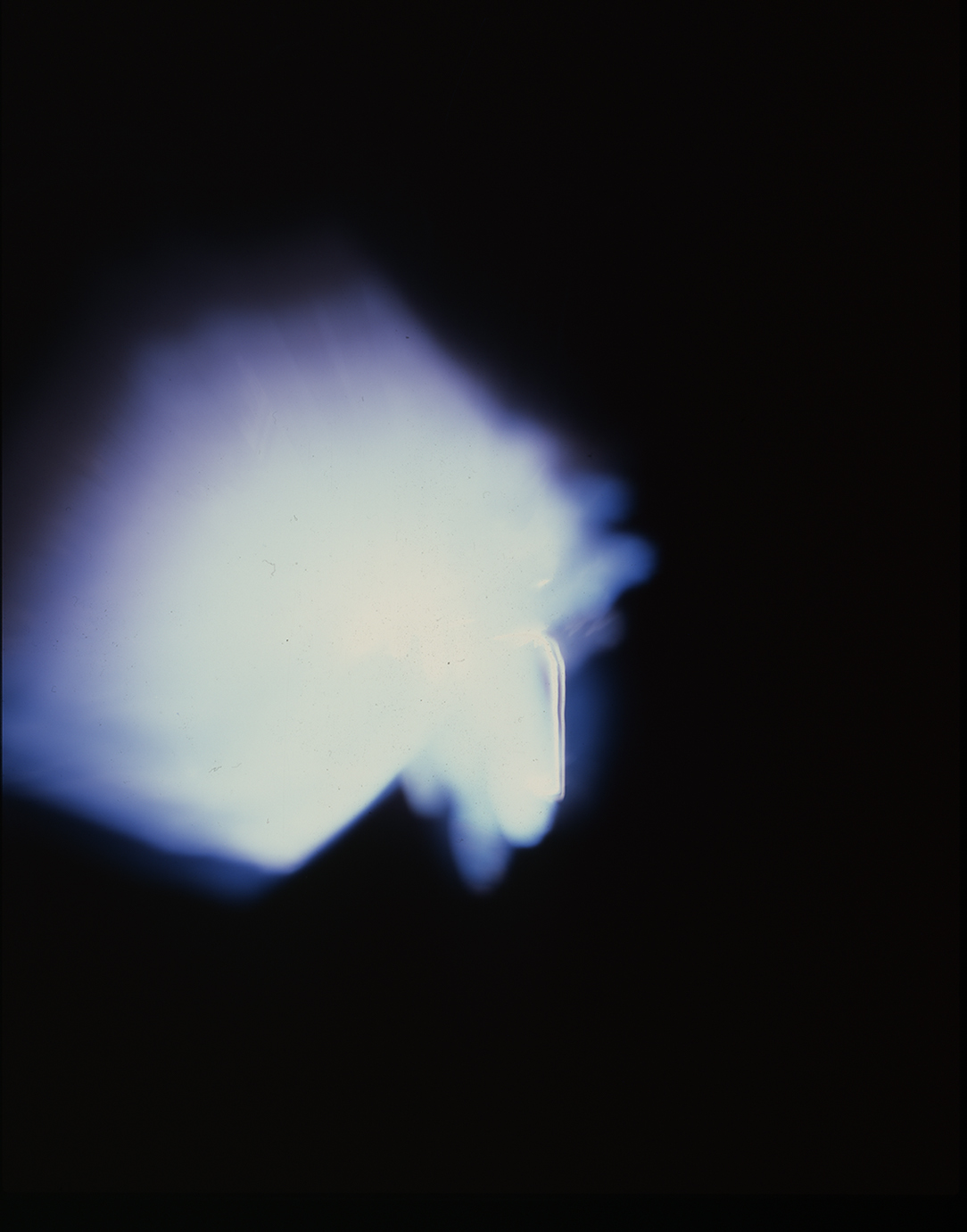

Liesbet Grupping, Drawings of the wind, 2015
This photographic image is generated through a black bag featuring a hole as well as a 4 x 5 inch slide – as a mobile camera obscura if it were. This black bag is lifted up by the wind which triggers the making of the image.
The drawings are made by inversing the conventional way of drawing: instead of pressing the pencil on the paper, the wind lets the paper move underneath the pencil point.
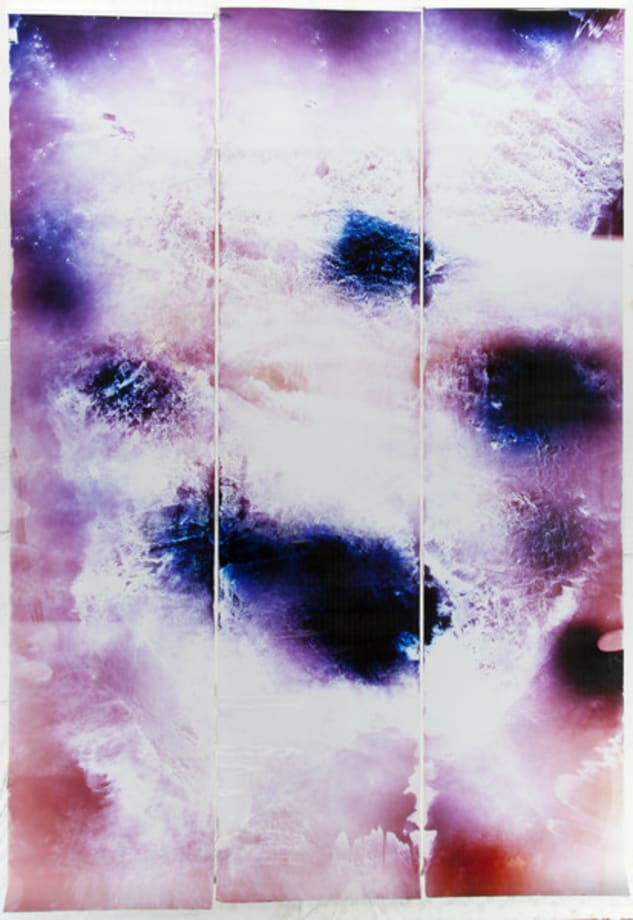
Raphael Hefti, Lycopodium, 2014, 700 x 390 cm, Photogram on color photopaper using the gently burning spores of Lycopodium moss.
Lycopodium, known as witch powder in the Middle Ages due to its combination of explosive and healing properties, was used in early photography, explosives and homeopathy. It burns slowly and above the surface of the paper, so that light exposes the photopaper without it burning the surface.



Helena Petersen, Pyrographie Colour X, Analog Chromogenic Photogram, 102 x 182,6 cm, 2012, Unique
The Pyrographs are explosion of gunpowder captured on light sensitive silver paper. The bright muzzle flash illuminates the paper. After the development, not the ammunition becomes visible, not the bullet aimed at a target, but the pure driving force.
 Dominique Somers, Bouquet (Green), 2015, 40x50cm
Dominique Somers, Bouquet (Green), 2015, 40x50cm This image represents the residu and burn marks of magnesium flash explosions on canvas.

Dries Segers, work in progress, 2023, salt crystillized on photographic emulsion, enlargment, size undertermined.

August Strindberg (c.1892-1896), Impression of Crystallisation, 12 x 9 cm, Courtesy of the Royal Library of Stockholm

Liesbet Grupping, Evaporating Picture, Kodak Carousel Slide projector, diaframe filled with salt seawater
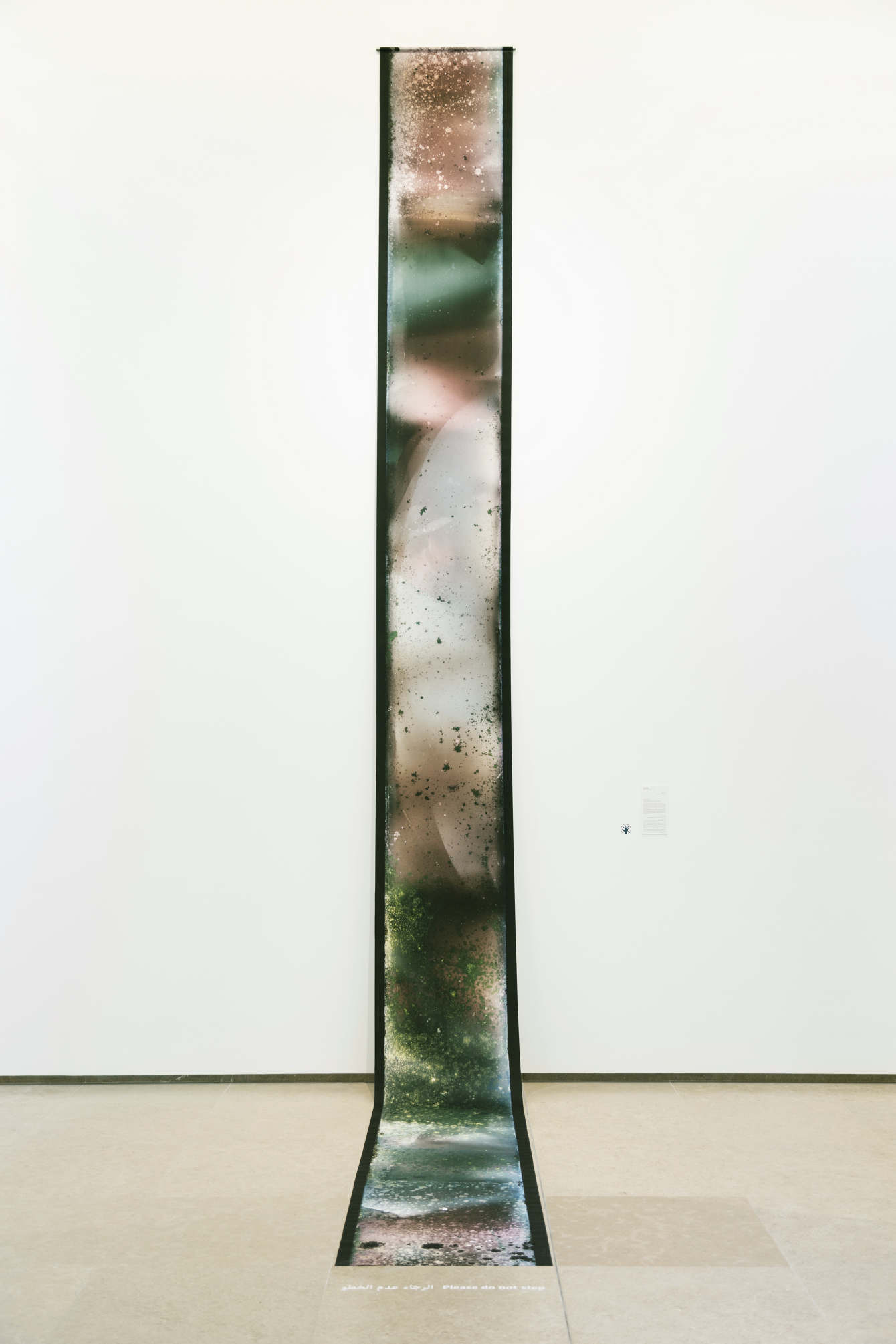
Lara Tabet, The River, 2018
Bacteria on celluloid, 60cmx747cm
A strip of 120 mm color film is used as a bacteria incubator where microorganisms collected from the river bed can grow and alter the chemistry of the filmroll.
Tabet collected samples from multiple locations along the Beirut river, isolated them on agar plates, and then re-incubated them onto the celluloid strip that acts as a mirror to the river’s microcosm.

Lara Tabet, Bacteria on celluloid, scanned and UV printed on Aludibond, ed of 5, 2020



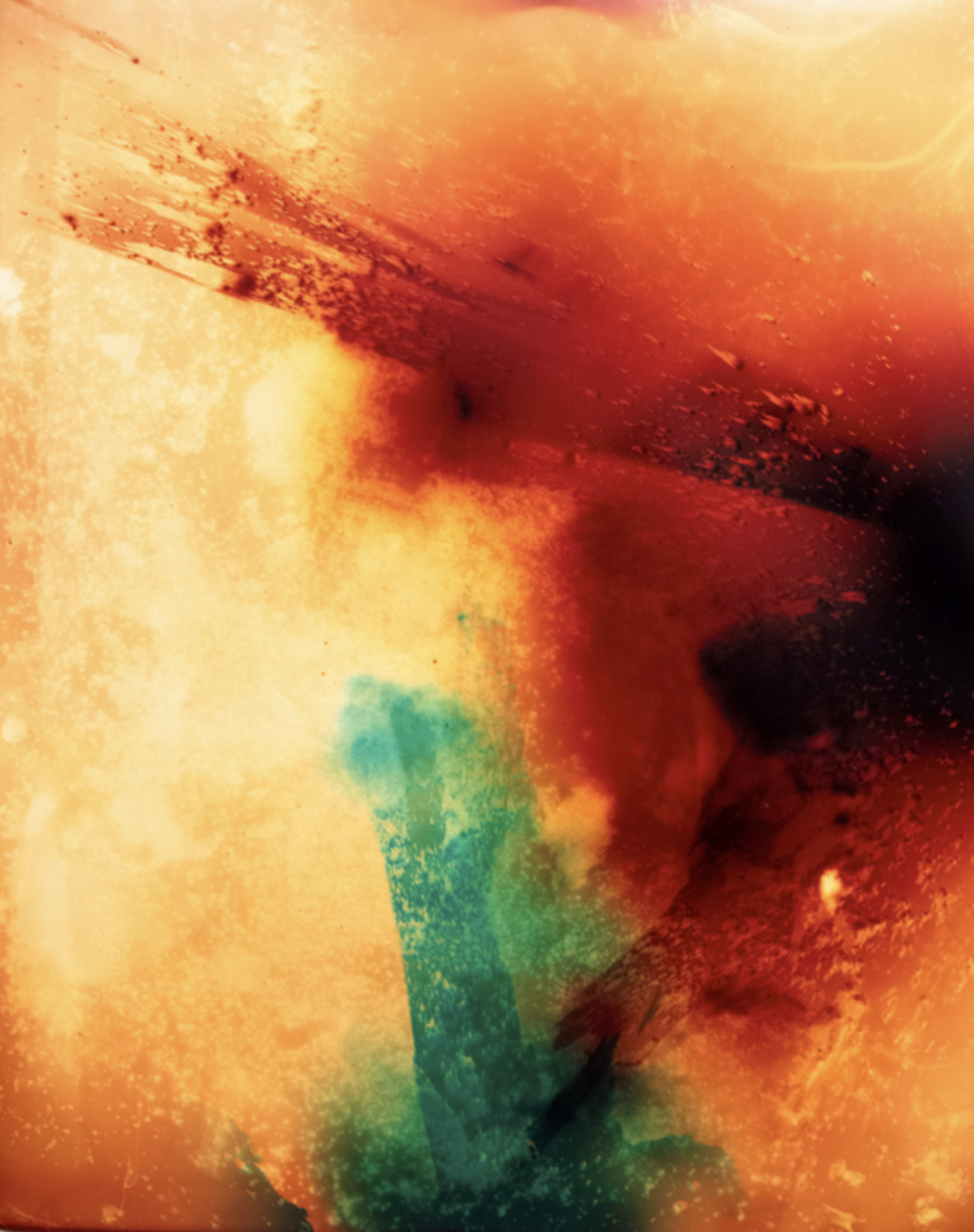
Monuments, Douglas Mardy, 2022, photogram of melting glacier ice on Kodak paper, 40,6 x 50,7 cm, Unique

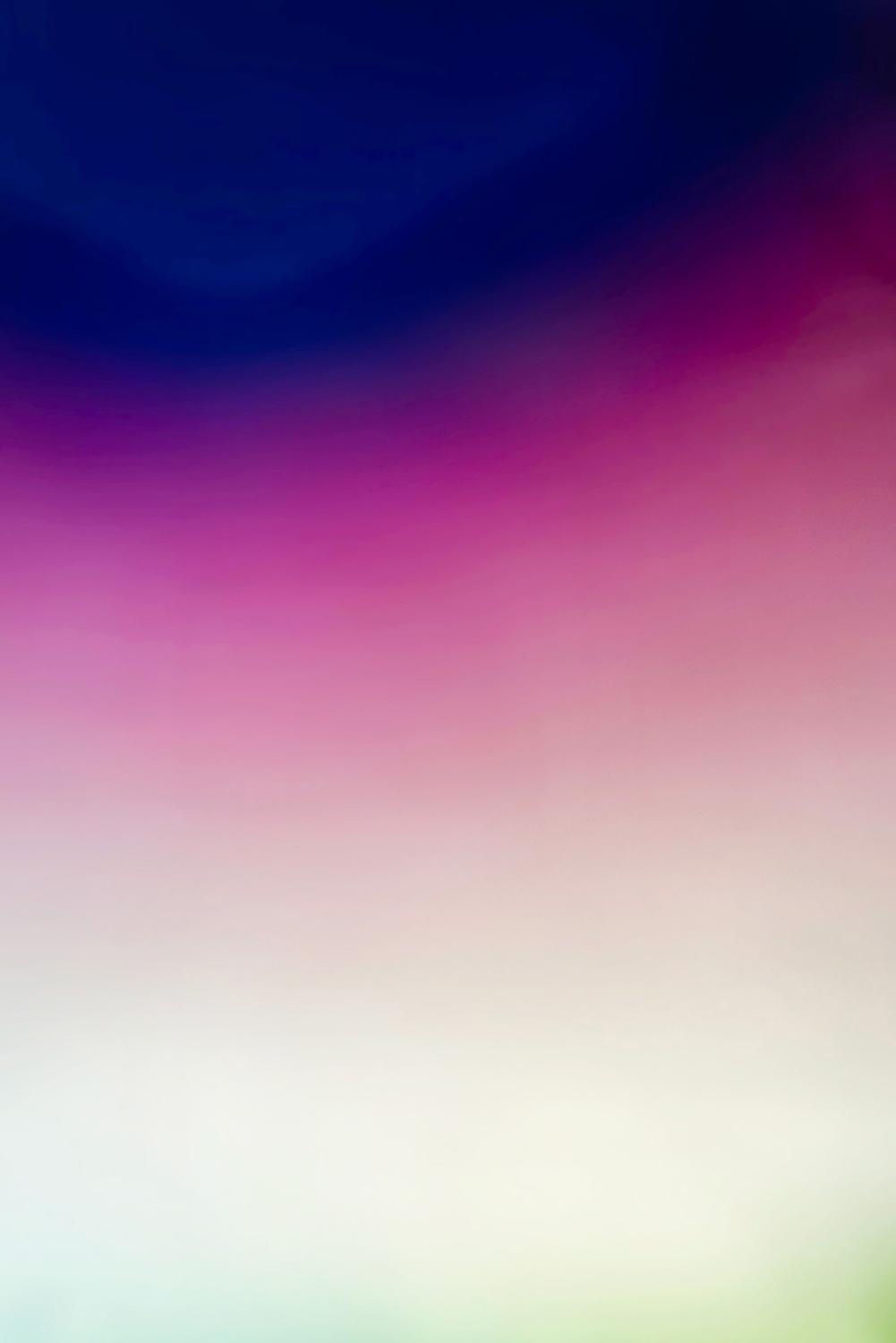

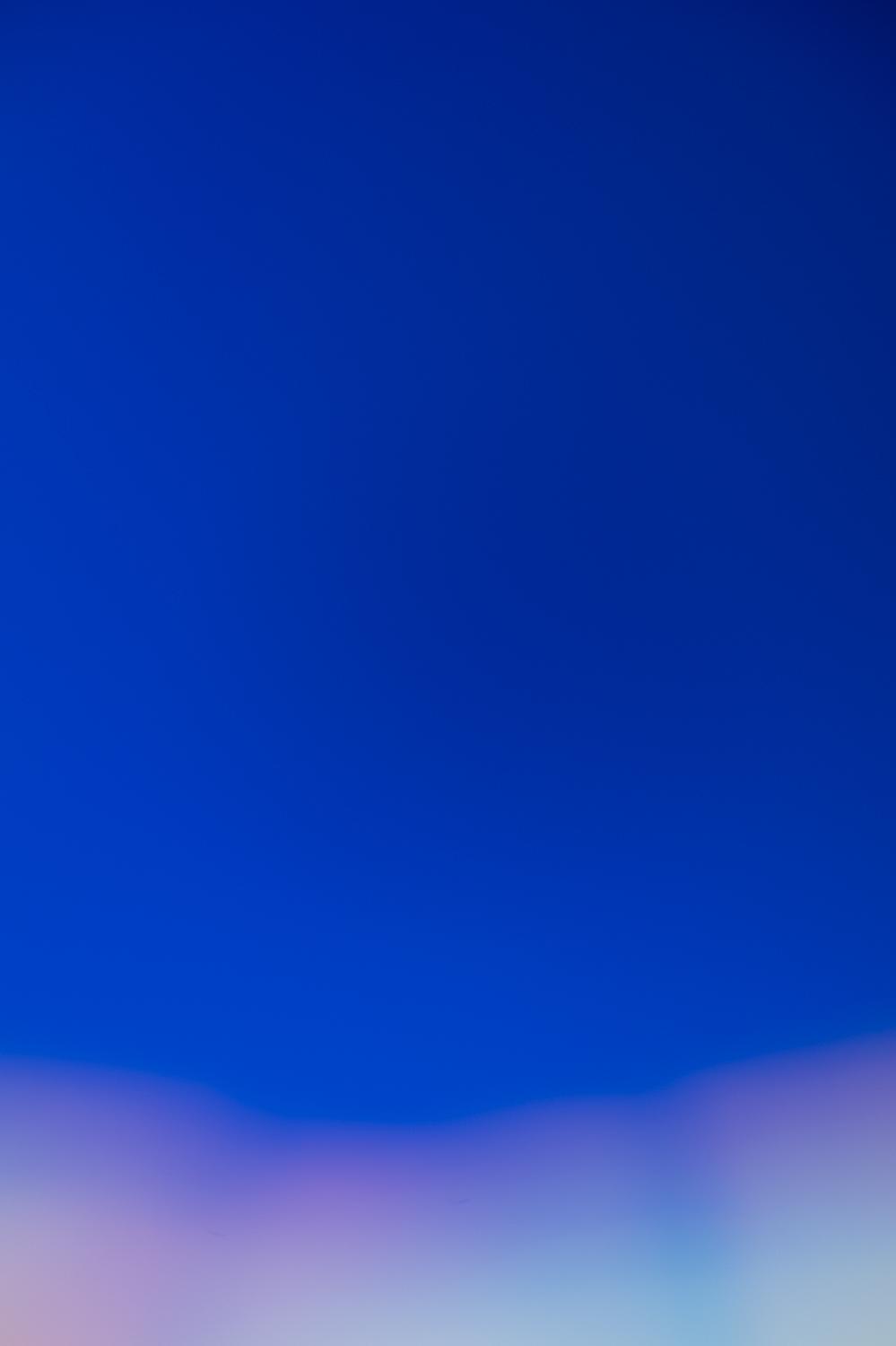
Laure Winants, Words From a Tongue We Are Losing, 2023
Several boreholes have been drilled to take samples of permafrost, glaciers and sea ice. It provides a lens in which it visualises information dating back to 300-million-year-old ago, captured and held in the arctic ice.
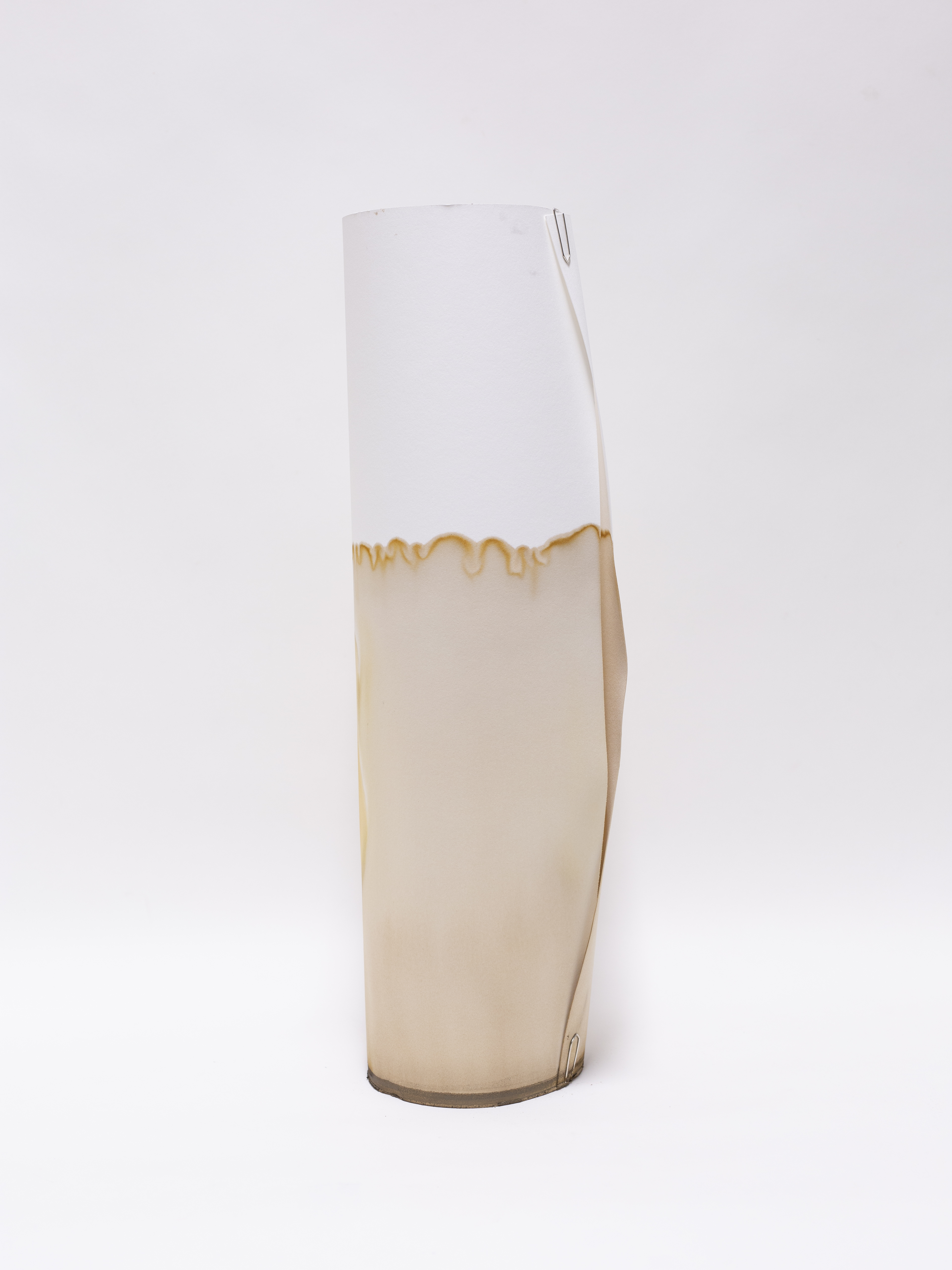
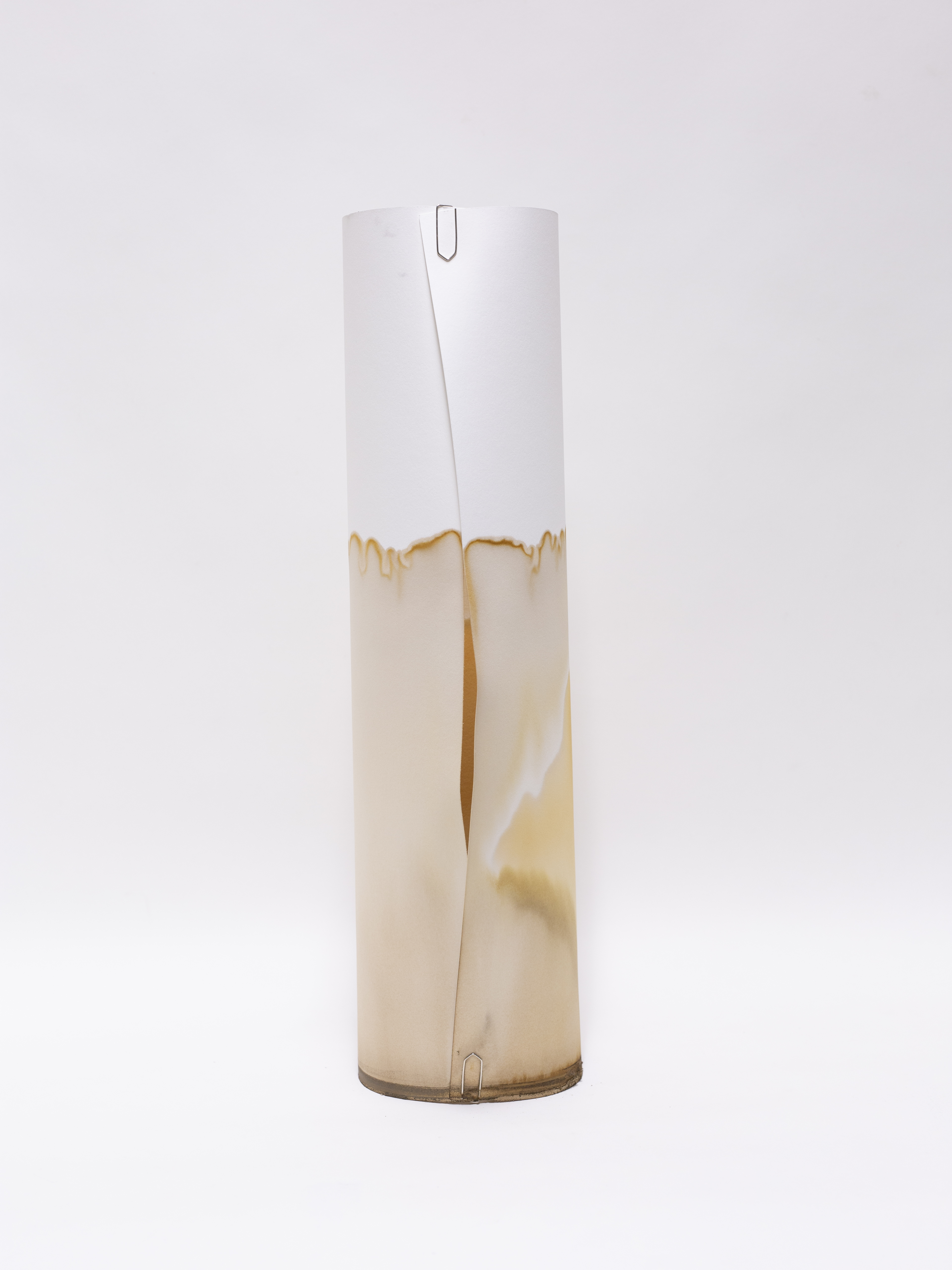
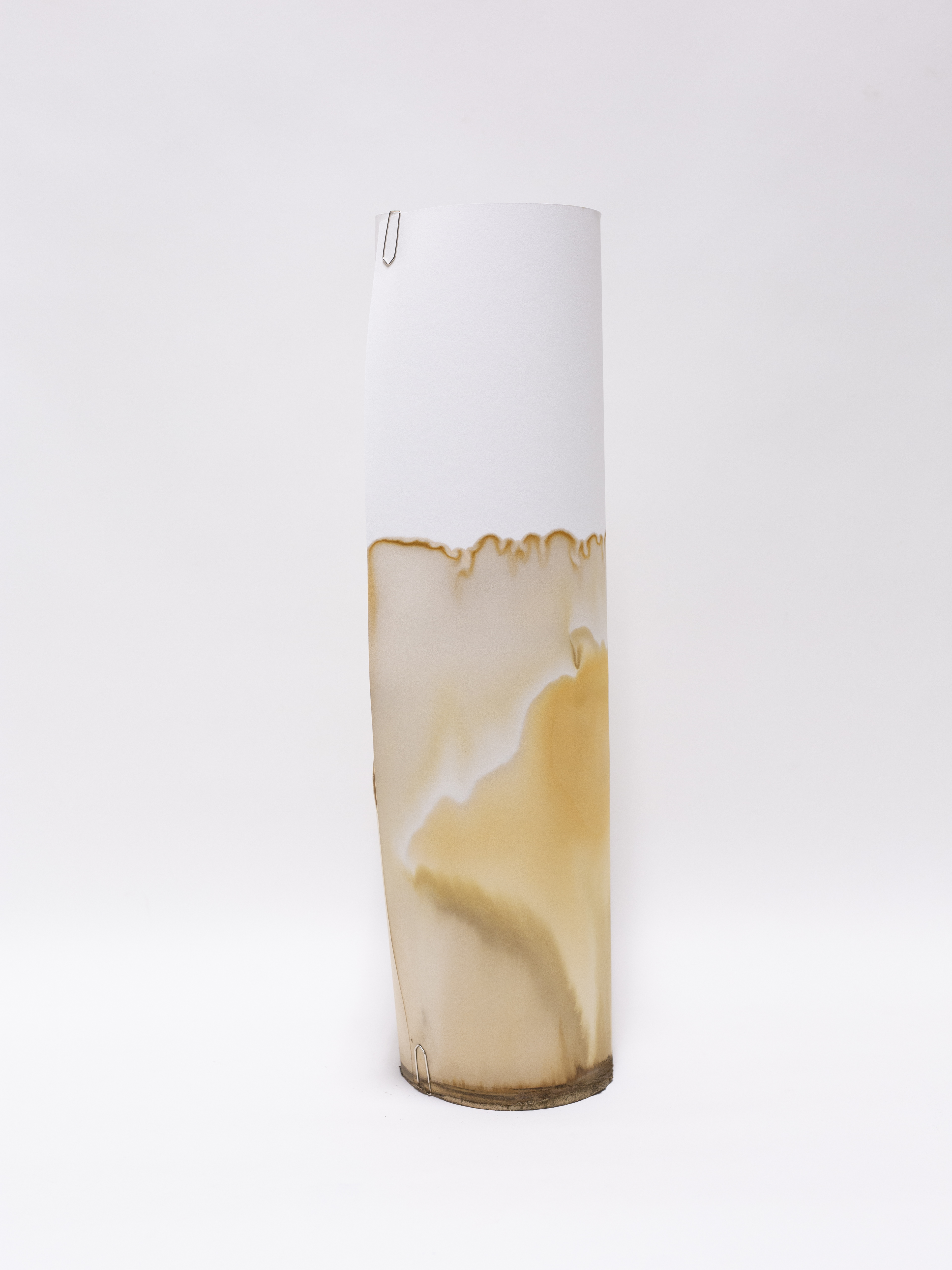
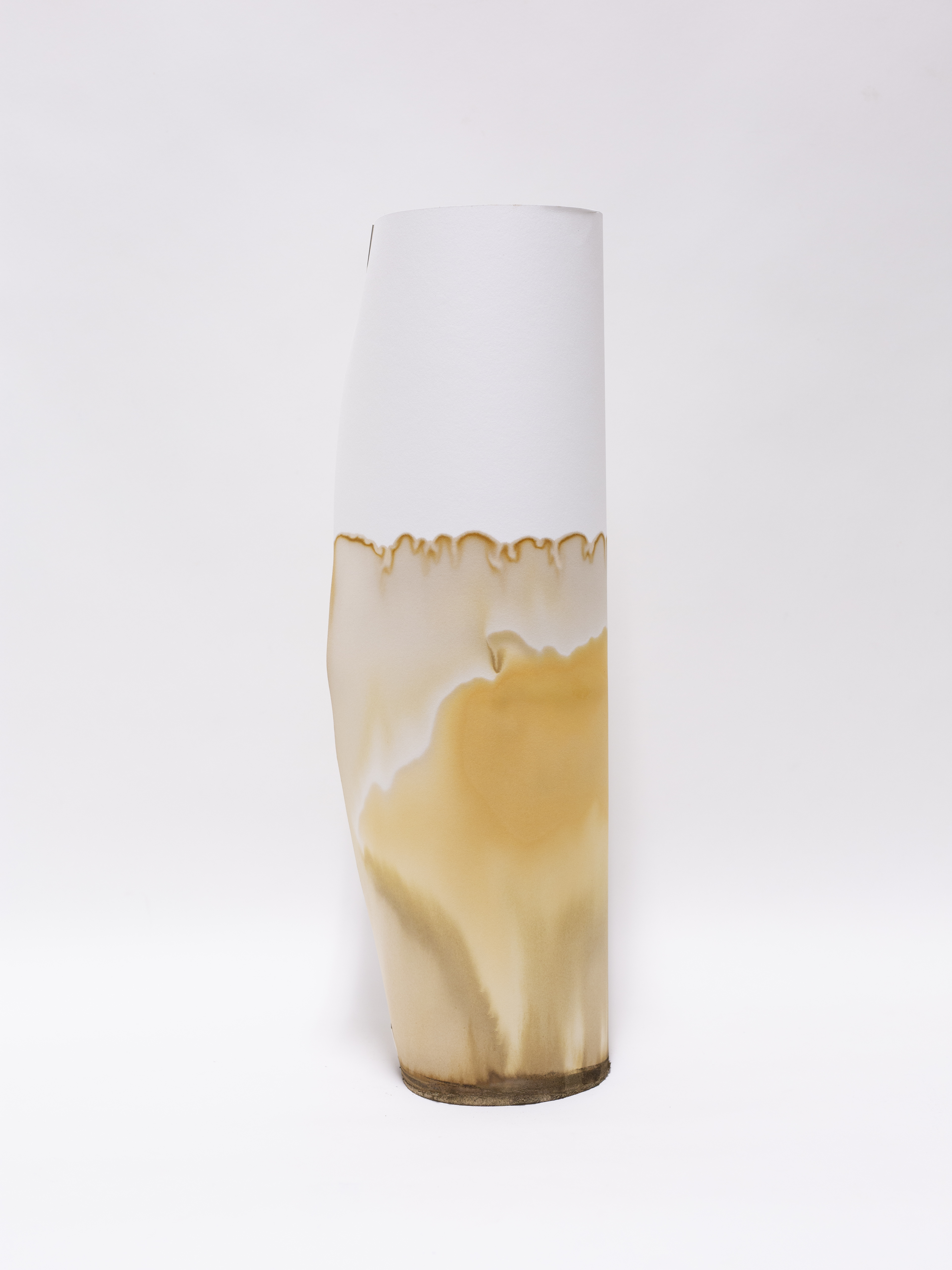
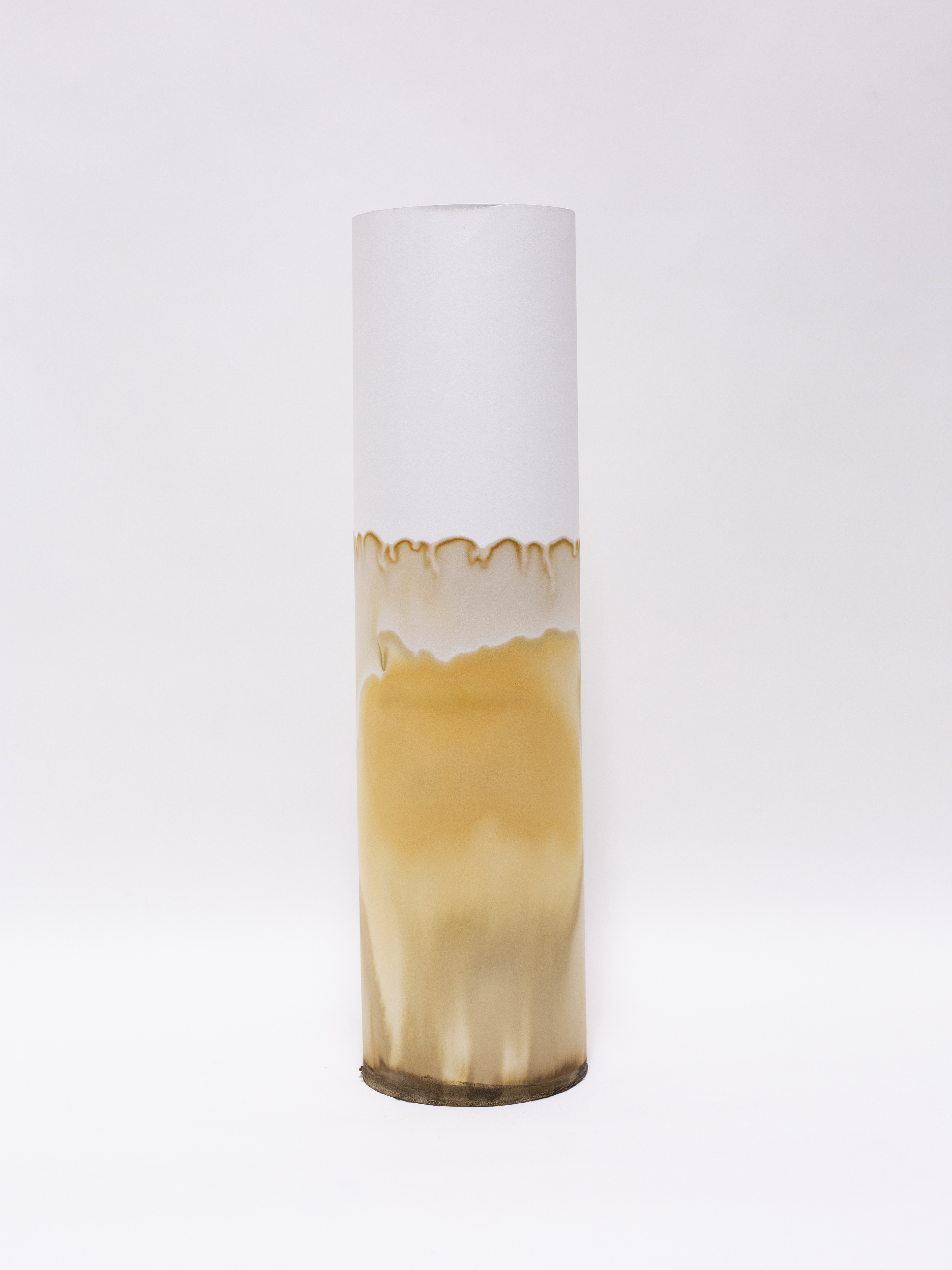
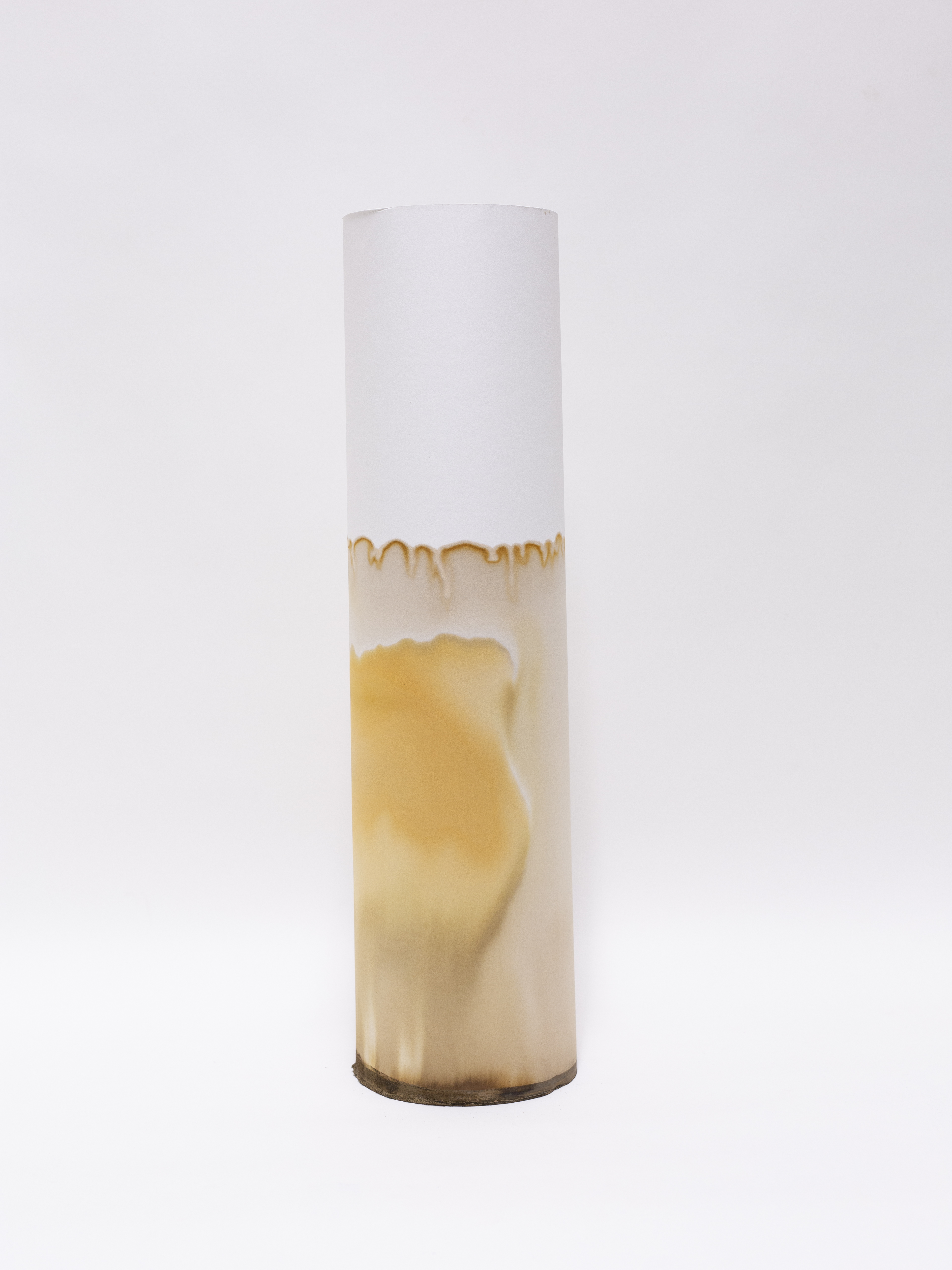
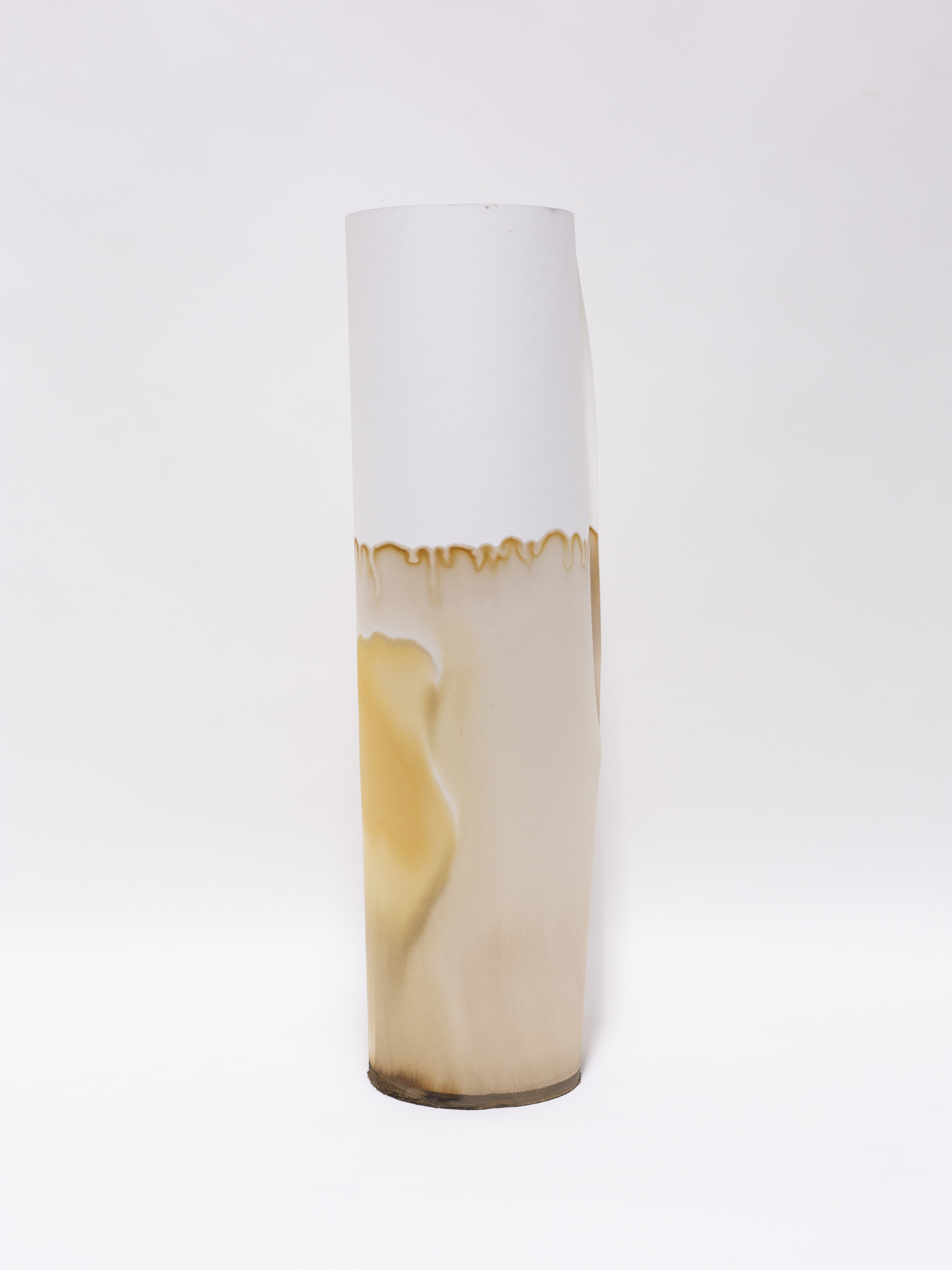
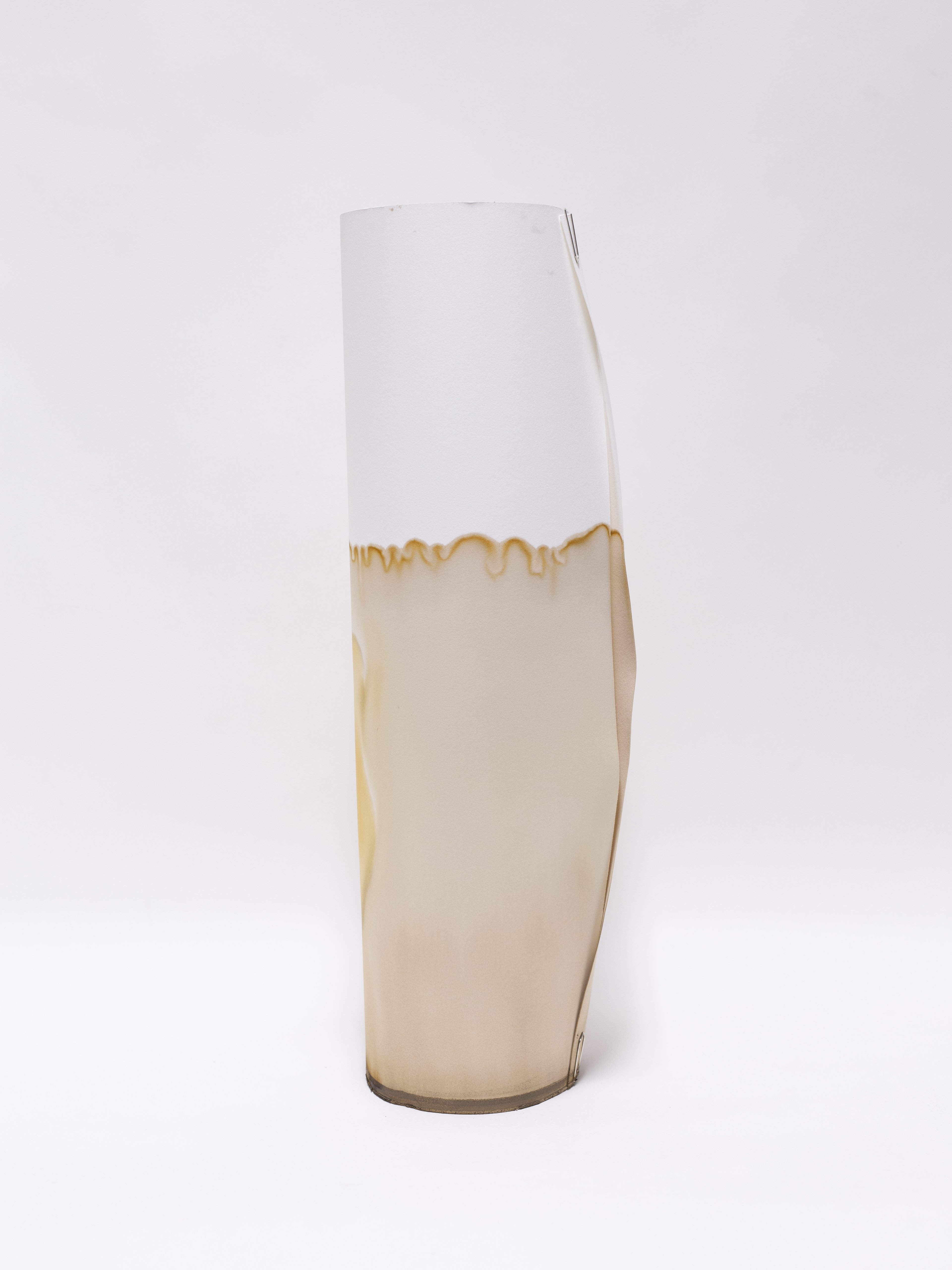
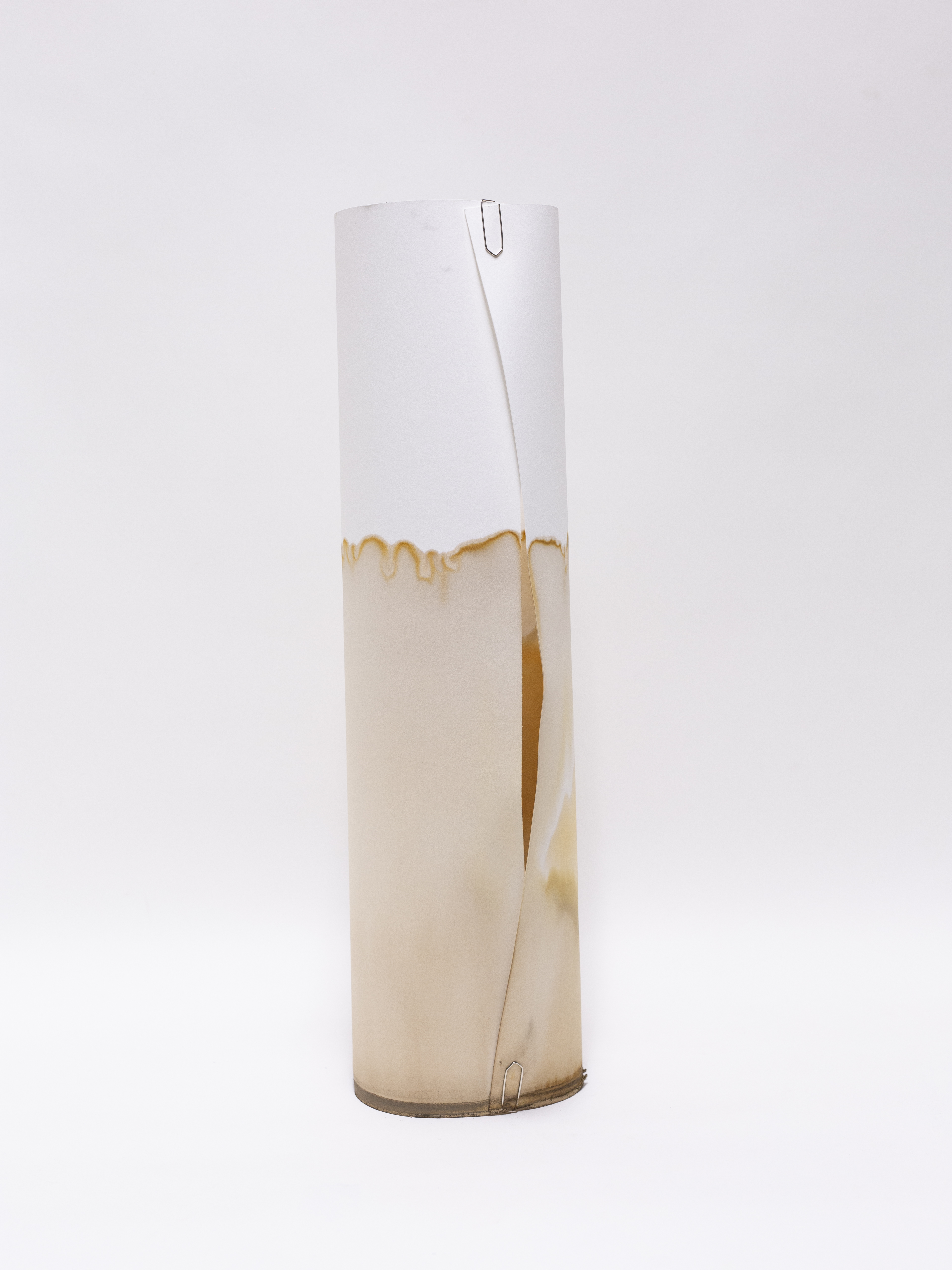
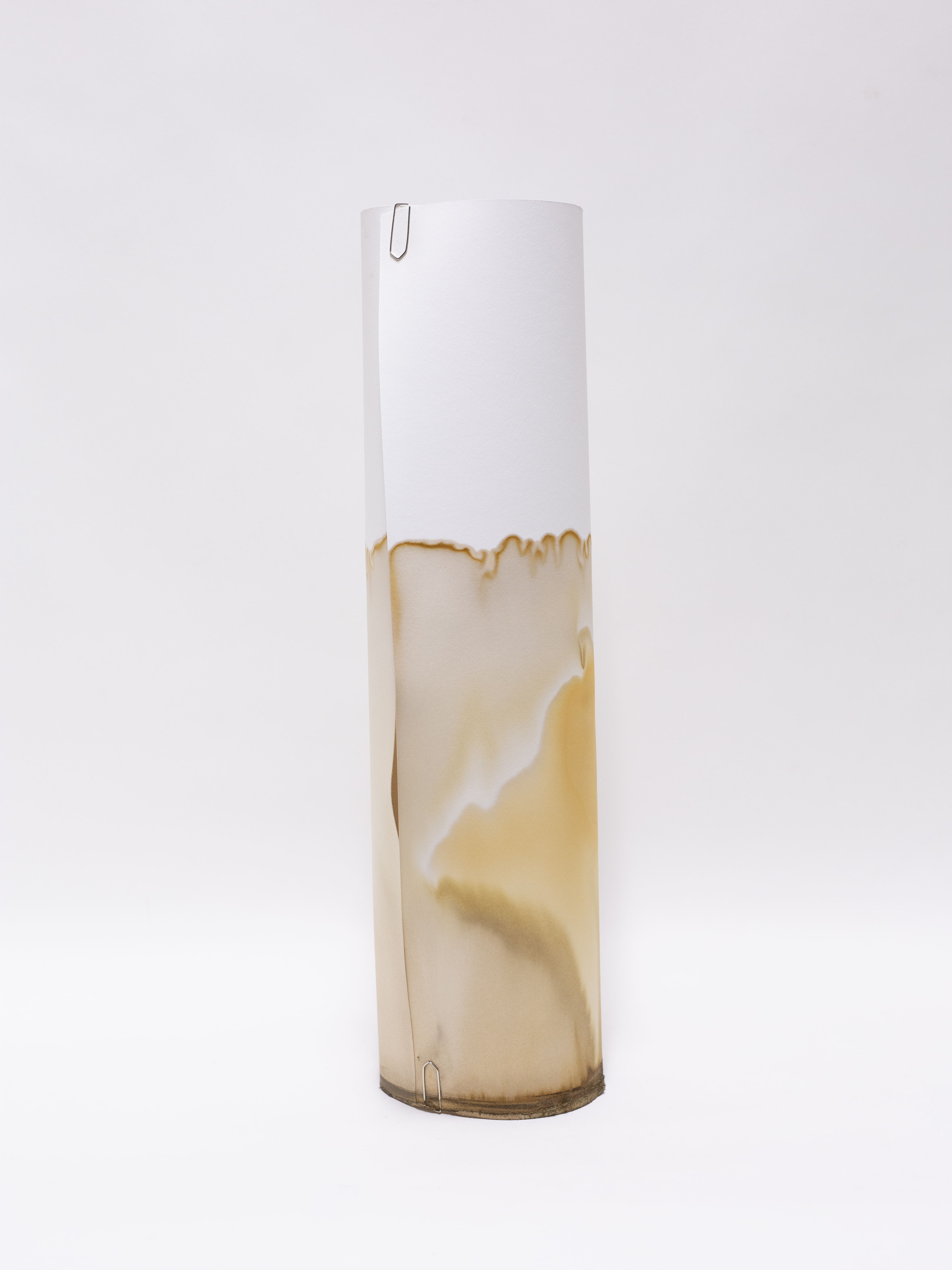
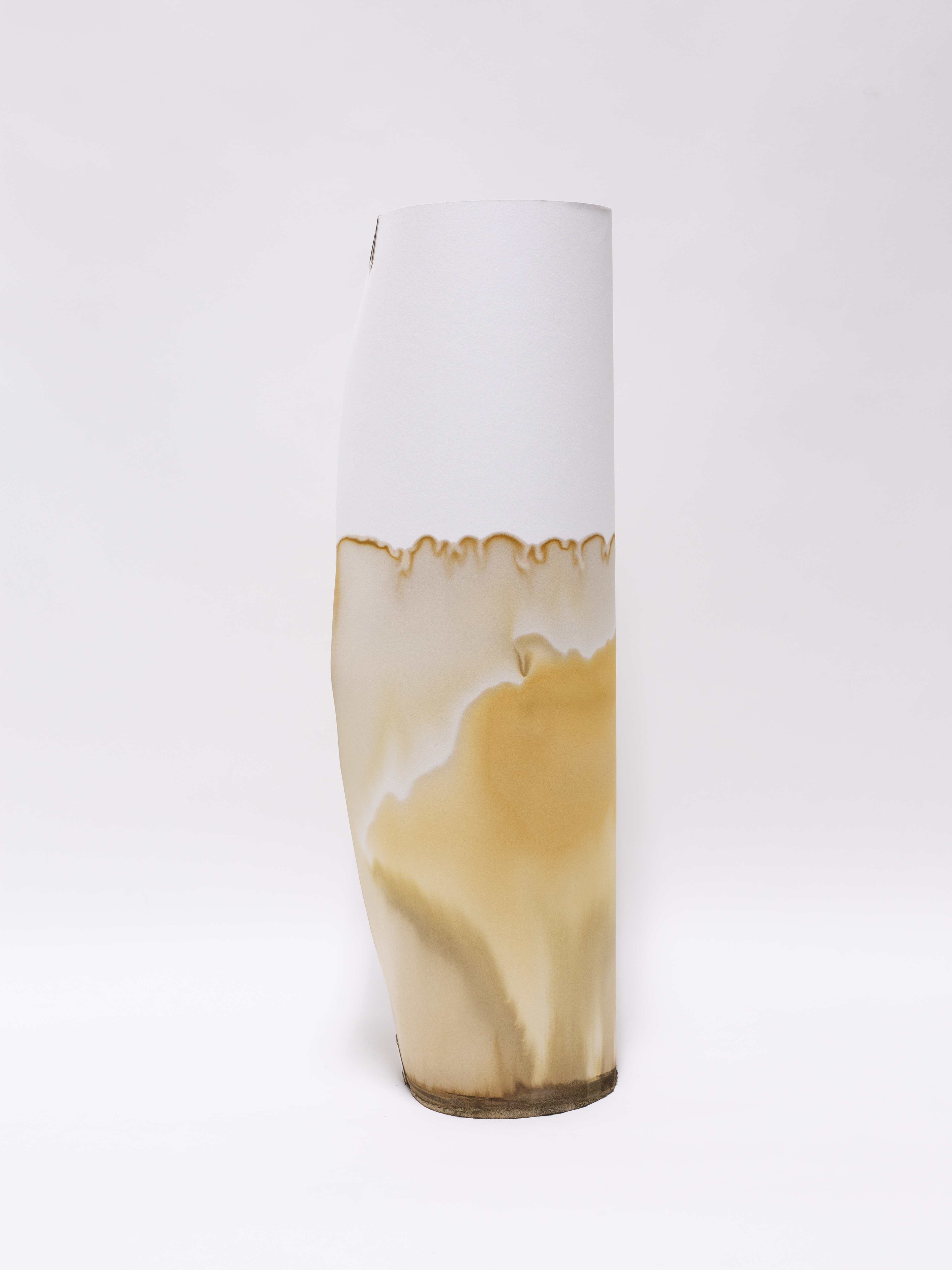
SEEDS
Category:Chemistries
- The Material Ethereal Photography and the Alchemical Ancestor, Laurie Dahlberg, published in Art & Alchemy, ed. Jacob Wamberg (Copenhagen: Museum Tusculanum Press, University of Copenhagen, 2006), p 83–100
- Der Bildungstrieb der Stoffe, 114 Seiten, Friedlieb,Ferdinand Rung, Judith Schalansky (Hg.), 2014, Matthes & Seitz Verlag
- Inadvertent Images : A History of Photographic Apparitions, Peter Geimer, 2018, University of Chicago Press
- Materiality, Petra Lange-Berndt, 2015, The MIT press
- Mining Photography; The Ecological Footprint of Image Production, (ed.) Boaz Levin, Esther Ruelfs, Tulga Beyerle, 2022, Spector Books
- Revelations, Experiments in Photography, Ben Burbridge, 2015, MACK & Media Space
- Re:Source, Hannah Fletcher (ed.), 2022, The Sustainable Darkroom/London Alternative Photography Collective
- The Edge of Vision, Lyle Rexer, 2009, Aperture Foundation
- Synthetic Worlds: Nature, Art and the Chemical Industry, Esther Leslie, 2017, 2005, Reaktion Books LTD
Category:Learning while listening
Note: I have some pdf’s of the essays and books listed, get in contact if you want them. (They are marked with two stars**)
SEEDS
Category:Entaglements
- Arts of Living on a Damaged Planet: Ghosts and Monsters of the Anthropocene, Anna Tsing, Heather Swanson, Elaine Gan & Nils Bubandt (ed.), 2017, University of Minnesota Press
- Symbiotic Planet A New Look At Evolution, Lynn Margulis, 1999, Basic Books*
- The Perception of The Environment, Tim Ingold, 2000, Routledge* **
Category:Humus
- Realism Materialsm Art, eds. C. Cox, J. Jaskey, S. Malik, 2015, Sternberg Press, ISBN 978-3-95679-126-0**
- A World Without Soil: The Past, Present, and Precarious Future of the Earth Beneath Our Feet, Jo Handelsman, 2021, Yale University Press
- Sensing Earth, Cultural Quests Across a Heated Globe, Philipp Dietachmair, Pascal Gielen, Georgia Nicolau (ed.), 2023, Valiz Antennae-Arts in Society Series
- The Mushroom at the End of the World; On the Possibility of Life in Capitalist Ruins, Anna Lowenhaupt Tsing, 2015, Princeton University Press
- Down to Earth; Politics in the New Climatic Regime, Bruno Latour 2018, Polity Press
- Staying with the Trouble: Making Kin in the Chthulucene, Donna Harraway, 2016, Duke University Press
- Critical Zones: The Science and Politics of Landing on Earth, Bruno Latour and Peter Weibel (eds.), 2020, ZKM
- Art and Climate Change, Maja and Reuben Fowkes, 2022, Thames & Hudson
- Post Human Glossary, Rosi Braidotti & Maria Hlavajova (ed.), 2018, Bloomsbury
SEEDS
Category:Being Biotic- Ways of Being; Beyond Human Intelligence, James Bridle, Penguin Books, 2022
- Cambio, FORMAFANTASMA, 2020, Serpentine Galleries and Koënig Books
- The Botanical Mind: Art, Mysticism and The Cosmic Tree, Gina Buenfeld & Martin Clark, 2021 Camden Art Center
Category:Becoming Image
- Transbordeur, Les histoires écologiques de la photographie (magazine), 2024
- Camera Geologica: An Elemental History of Photography, Siobhan Angus, 2024, Duke University Press
- Capturing Nature, Matthew Zucker, Pia Östlund, 2023, Princeton Architectural Press
- Optiks: A treatise of the Reflections, Refractions, Inflexions and Colours of Light. Also Two treatises of the Species and Magnitude of Curvilinear Figures., Isaac Newton, 1704, London
- Photography 1839-1937, Beaumont Newhall, 1937, MoMa New York, 131 p., 93 p. of plates : ill. ; 26 cm.
- Meeting the Universe Halfway, Karen Barad, 2007, Duke University Press* **
- On Poetic Imagination and Reverie, Gaston Bachelard,
(Selected, introduced, and annotated by Collete Gaudin), 1971, The Bobbs-Merill Company, New York**
- Water and Dreams; An Essay on the Imagination of Matter, Gaston Bachelard, 1942, The Pegasus Foundation, Dallas**
SEEDS
Catagory:Attitudes
- Investigative Aesthetics: Conflicts and Commons in the Politics of Truth, Matthew Fuller and Eyal Weizman, 2021, Verso Books
- The work art does is as important as it is elusive, Rebecca Solnit, in Dear Earth: Art and Hope in a Time of Crisis, 2023, Hayward Publishing
- The World for World is Forest, Ursula K. Le Guin, 1976, Berkley Books
- Matters of Care: Speculative Ethics in More than Human Worlds, María Puig de la Bellacasa, 2017, University of Minnesota Press**
- Anthropos and the Material, (ed.) Penny Harvey, Christian Krohn-Hansen, Knut G. Nustad, 2019, Duke University Press*
- making matters, A Vocabulary for Collective Arts, Janneke Wesseling, Florian Cramer (ed.), 2022, Valiz
- Emergence Magazine; volume 2, Emmanuel Vaughan-Lee, Seanna Quinn, Bethany Ritz (ed.), 2021, 394 pages
- Braiding Sweetgrass, Robin Wall Kimmerer, 2012, Penguin Books
- Non-Representational Methodologies: Re-Envisioning Research, Vannini, Phillip (ed.), New York/Londen, 2015, Routledge**
- Making. Anthropology, Archaeology, Art and Architecture, Tim Ingold, 2013, Routledge*
- More-than-human, Andrés Jaque, Marina Otero Verzier, Lucia Pietroiusti (eds.), 2020, Het Nieuwe Instituut
- What Would Animals Say If We Asked the Right Questions?, Vinciane Despret, 2016, University of Minnesota Press
WORLDS WORLD WORLDS
ALMANAC
![]()
https://foreverpollution.eu/map/
![]() Fossiled raindrops found in South Africa, by Astrobiologist Dr Sanjoy Som, of NASA's Ames Research Center
Fossiled raindrops found in South Africa, by Astrobiologist Dr Sanjoy Som, of NASA's Ames Research Center
ALMANAC
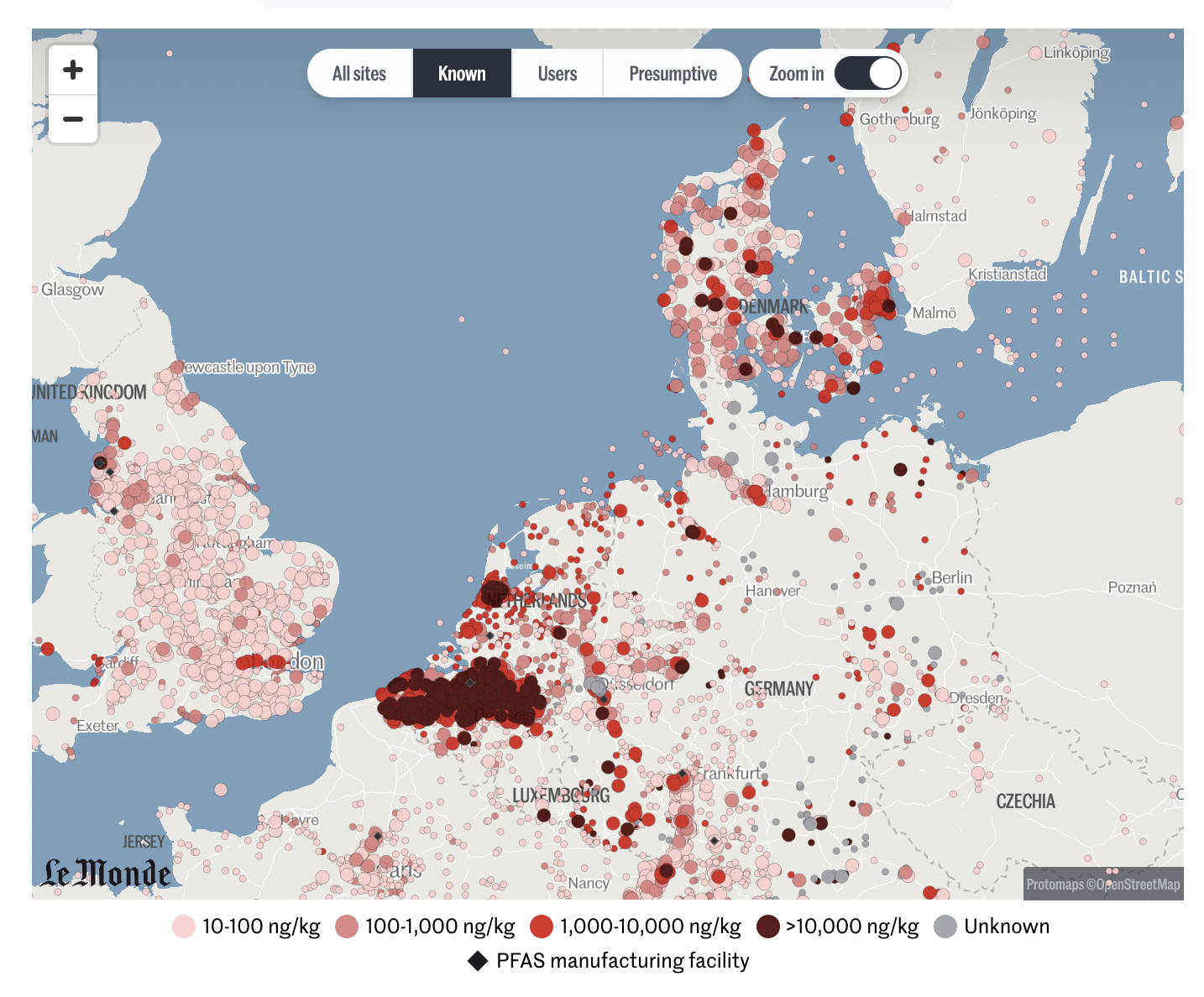
https://foreverpollution.eu/map/
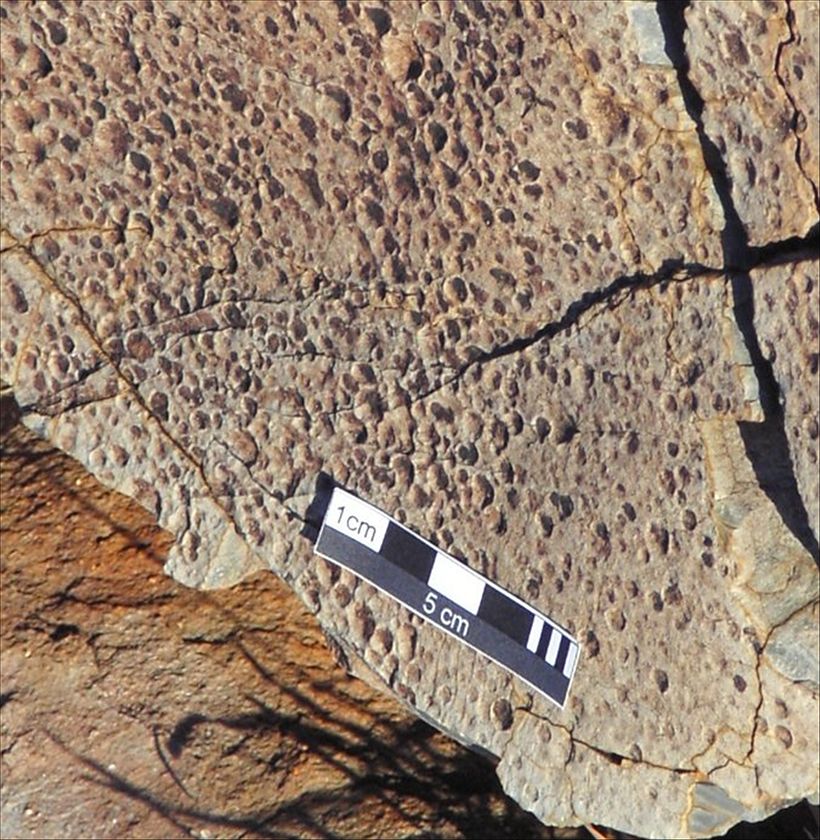 Fossiled raindrops found in South Africa, by Astrobiologist Dr Sanjoy Som, of NASA's Ames Research Center
Fossiled raindrops found in South Africa, by Astrobiologist Dr Sanjoy Som, of NASA's Ames Research CenterRaindrop impressions are a geological feature characterized by small crater-like pits with slightly raised edges that are the result of the impact of raindrop impacts on soft sediment surfaces. They can help scientists determine historical atmospheric pressure.

A gas leak from Nord stream 2 is seen in the Swedish economic zone in the Baltic Sea in this picture taken from the Swedish Coast Guard aircraft on September 28, 2022. Swedish Coast Guard/Handout via TT News Agency/via REUTERS
Intra-action
Intra-action is a Baradian term used to replace ‘interaction,’ which necessitates pre-established bodies that then participate in action with each other. Intra-action understands agency as not an inherent property of an individual or human to be exercised, but as a dynamism of forces (Barad, 2007, p. 141) in which all designated ‘things’ are constantly exchanging and diffracting, influencing and working inseparably. Intra-action also acknowledges the impossibility of an absolute separation or classically understood objectivity, in which an apparatus (a technology or medium used to measure a property) or a person using an apparatus are not considered to be part of the process that allows for specifically located ‘outcomes’ or measurement.
SYNONYM:
agency, animacy, connectivity
ANTONYM:
disconnection, inanimacy, objectivity, singularity, vitalism
HYPERNYM:
phenomenology, connectivity, acknowledgement, respect
HYPONYM:
interaction, exchange, movement
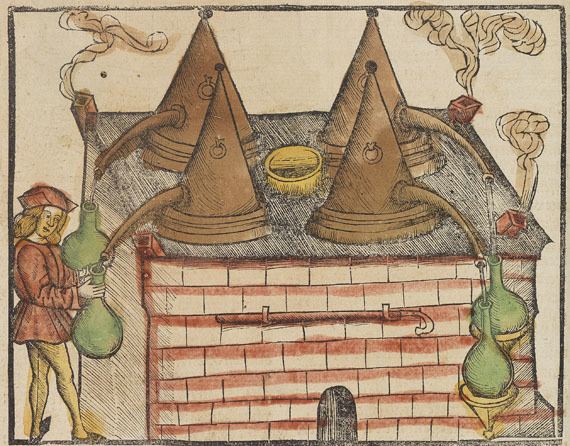
A Little Girl Lost
Children of the future age,
Reading this indignant page,
Know that in a former time
Love, sweet love, was thought a crime.
In the age of gold,
Free from winter's cold,
Youth and maiden bright,
To the holy light,
Naked in the sunny beams delight.
Once a youthful pair,
Filled with softest care,
Met in garden bright
Where the holy light
Had just removed the curtains of the night.
Then, in rising day,
On the grass they play;
Parents were afar,
Strangers came not near,
And the maiden soon forgot her fear.
Tired with kisses sweet,
They agree to meet
When the silent sleep
Waves o'er heaven's deep,
And the weary tired wanderers weep.
To her father white
Came the maiden bright;
But his loving look,
Like the holy book
All her tender limbs with terror shook.
'Ona, pale and weak,
To thy father speak!
Oh the trembling fear!
Oh the dismal care
That shakes the blossoms of my hoary hair!'
- William Blake
New materialist scholars use ‘matter’ as their focal point and searchlight. Zooming in on the matter of ecology, economy, politics, technology and art, these scholars move away from a framework of representation.
IT
MATTERS
WHAT
WORLDS
WORLD
WORLDS
- Donna Harraway
Language has been granted too much power. The linguistic turn, the semiotic turn, the interpretative turn, the cultural turn: it seems that at every turn lately every “thing”—even materiality—is turned into a matter of language or some other form of cultural representation.
- Karen Barad, Posthumanist Performativity: Toward an Understanding of
How Matter Comes to Matter
- Karen Barad, Posthumanist Performativity: Toward an Understanding of
How Matter Comes to Matter

The 14th sign of the Apocalypse: earth and sky are consumed by fire. From Livre de la vigne nostre seigneur, 1450-1470
Derived from mater, the Latin word for mother, matter refers to the substance from which all things are made. In English, the word matter can also indicate importance or significance – something to be concerned about.
(from Greek βίος bios, "life" and κέντρον kentron, "center"), in a political and ecological sense, as well as literally, is an ethical point of view that extends inherent value to all living things. It is an understanding of how the earth works, particularly as it relates to its biosphere or biodiversity. Biocentric thought is nature-based, not human-based.
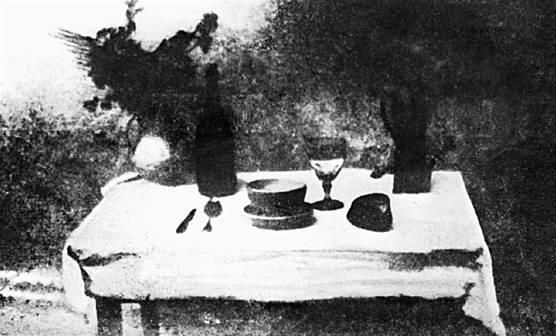
The physautotype was a photographic process, invented in the course of his investigation of heliography, by Joseph Nicéphore Niépce and Louis Jacques Mandé Daguerre in 1832, in which images were produced by the use of lavender oil residue dissolved in alcohol as the photographic agent. The solution was coated onto a silver or glass plate and allowed to dry, after which it had a powdery white appearance. The plate was then exposed in a camera obscura for about 8 hours and developed with petroleum-based spirit vapors, which caused the least strongly exposed areas to become proportionally more transparent, creating a photographic image that was positive when viewed against a darker background.
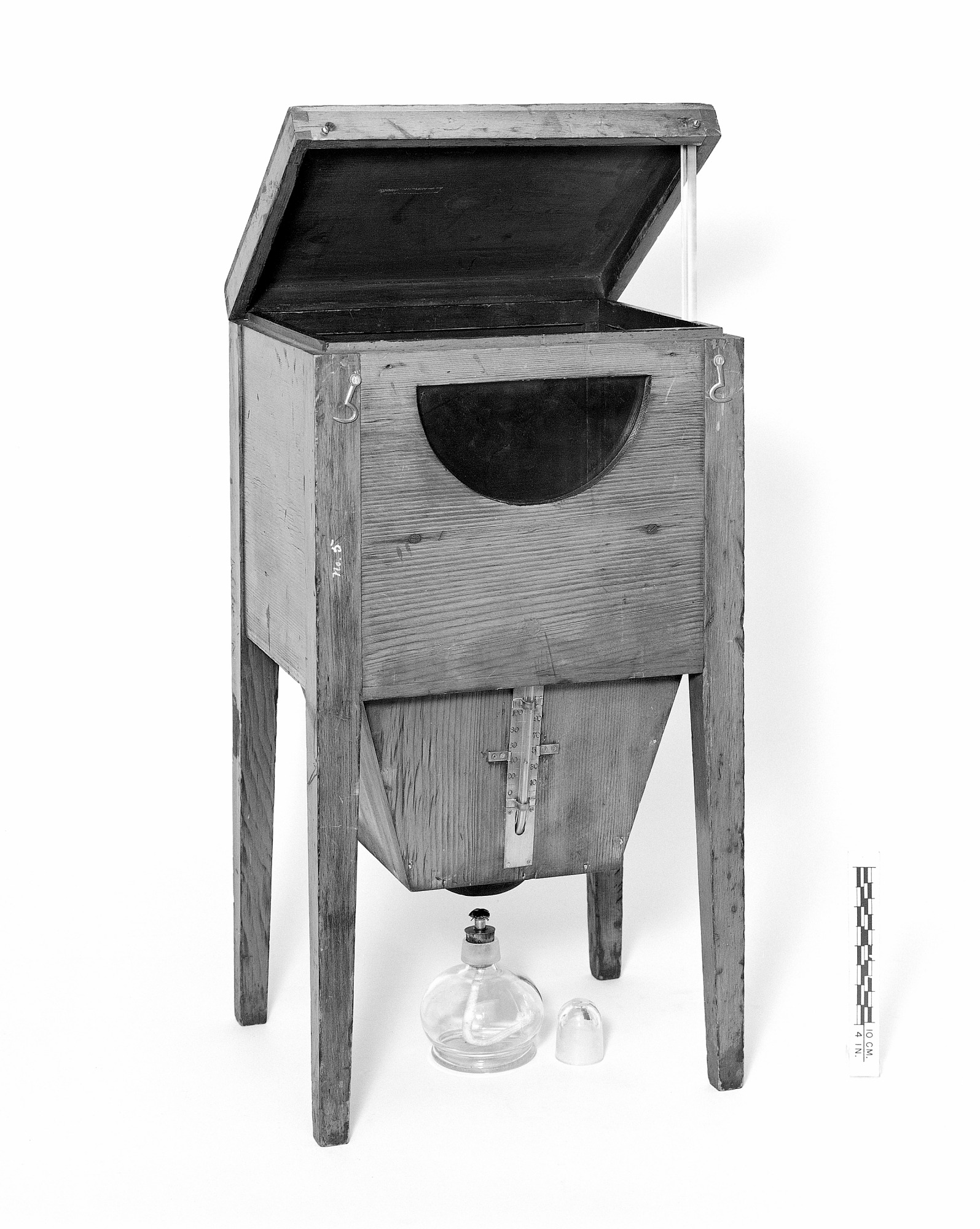
Murcury fuming box to develop daguerrotypes, © Collection National Museum of American History, used by Samuel F. B. Morse
Daguerre's process arrived at its homologous result when mercury and silver were transformed, through the agents of light and fire, into a product that transcended its ordinary physical ingredients: an image so powerfully real that nineteenth-century observers often grappled with the idea of the daguerrotype image as a somehow alive in a state of suspended animation.
Daguerre's process arrived at its homologous result when mercury and silver were transformed, through the agents of light and fire, into a product that transcended its ordinary physical ingredients: an image so powerfully real that nineteenth-century observers often grappled with the idea of the daguerrotype image as a somehow alive in a state of suspended animation.
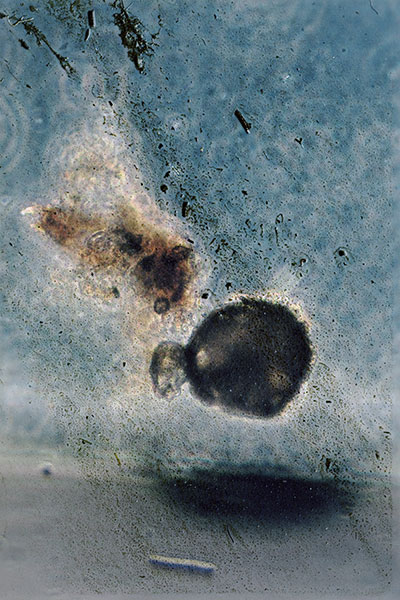
Coëxitence, Stephen Gill, 2012, Aperture
Stephen Gill was commissioned to make a photographic response to the postindustrial town of Dudelange, Luxembourg, once a center of European steel manufacturing. For this project he focused on a heavily polluted pond that had been used to cool the steel mill's furnaces, drawing visual parallels between the microscopic life in the water and the human life in the nearby town. Gill visited the University of Luxembourg, where he made use of a medical microscope to examine single drops of water to better understand the existence teeming below the pond’s murky surface. His images reveal a minuscule ecosystem —diatoms and other creatures—a sign that the abused pond may be coming back to life.
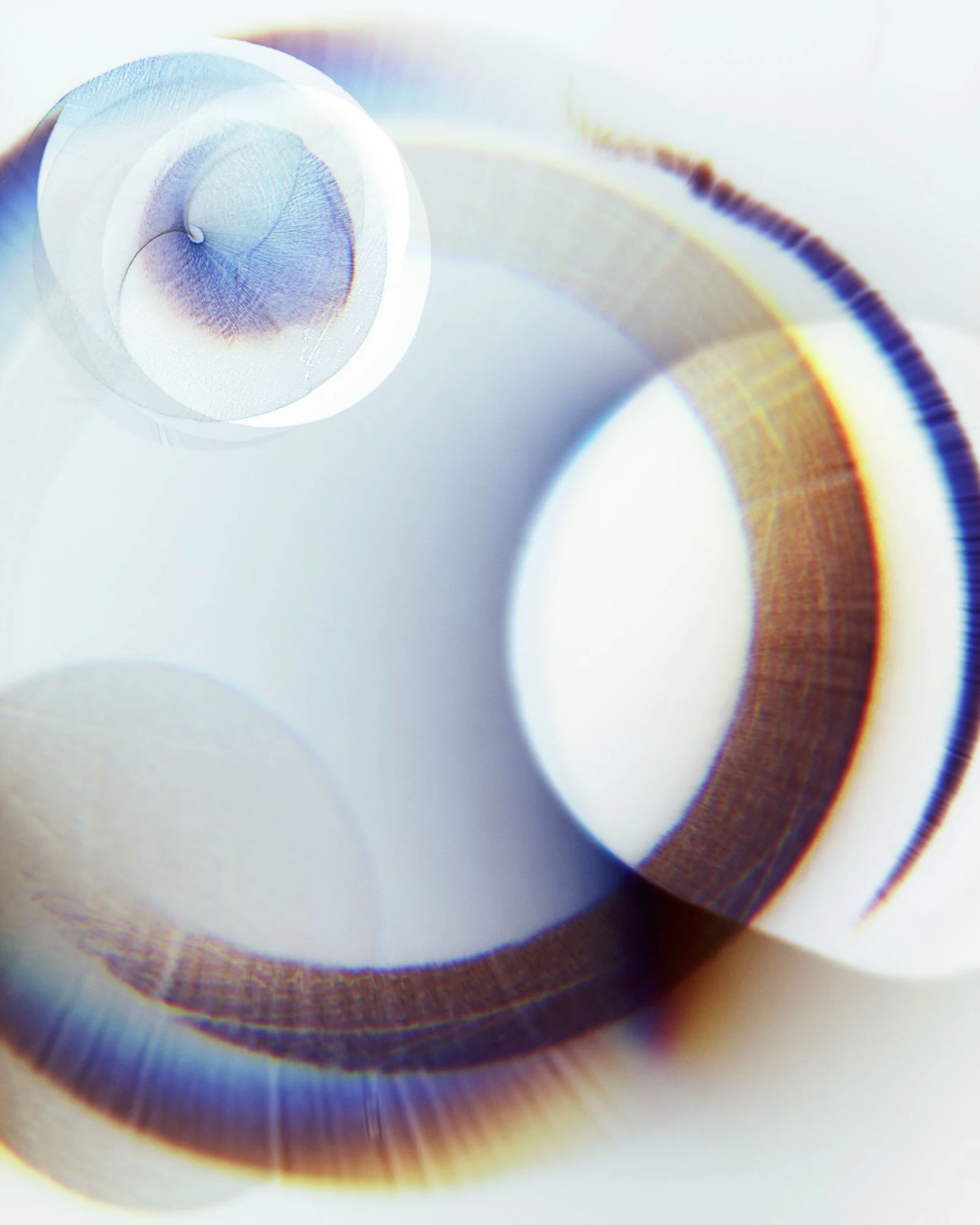 Sjoerd Knibbeler, Exploded View # 75/171, 2017
Sjoerd Knibbeler, Exploded View # 75/171, 2017Inspired by Isaac Newton’s first experiments on the nature of light, the Exploded views are created using a camera obscura. A beam of sunlight is directed into the device and passes through a constellation of prisms, producing colour and contrast. The shape and position of these handmade prisms determines the way white light is dispersed into spectral colours. Compositions come into being by altering their positions, relative to one another.
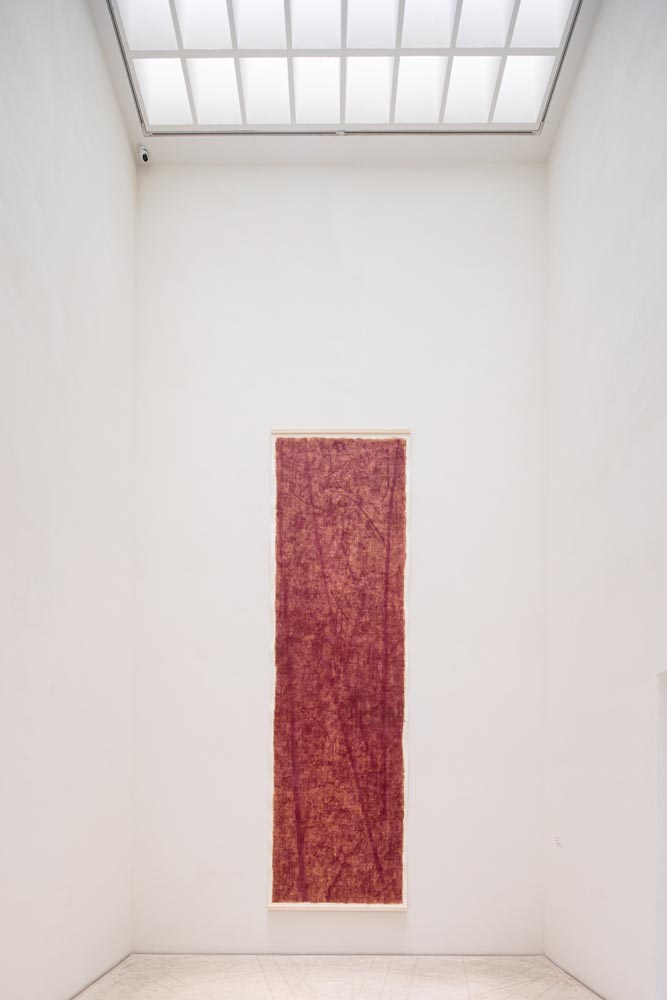
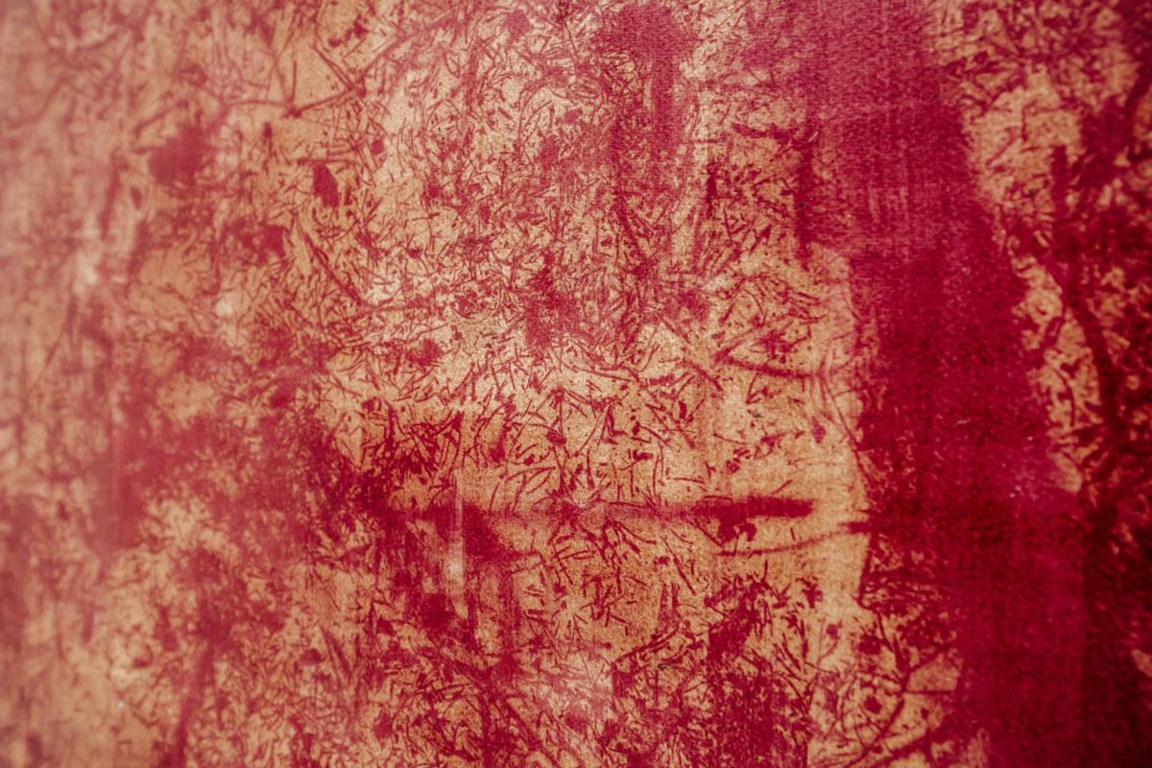
Kristof Vrancken, Hunger of the Pine I, Anthotype on paperroll, 2021
 Matthew Brandt, Nymph Lake, WY 4A, 2013, chromogenic print soaked in Nymph Lake water, 72 x 105 inches
Matthew Brandt, Nymph Lake, WY 4A, 2013, chromogenic print soaked in Nymph Lake water, 72 x 105 inches“The c-print of that lake on the photograph is submerged into a tray with the lake’s water. From this point Brandt waits for the water to break down its own photographic image. Depending on the image density and water, this breakdown time can take days or weeks.”
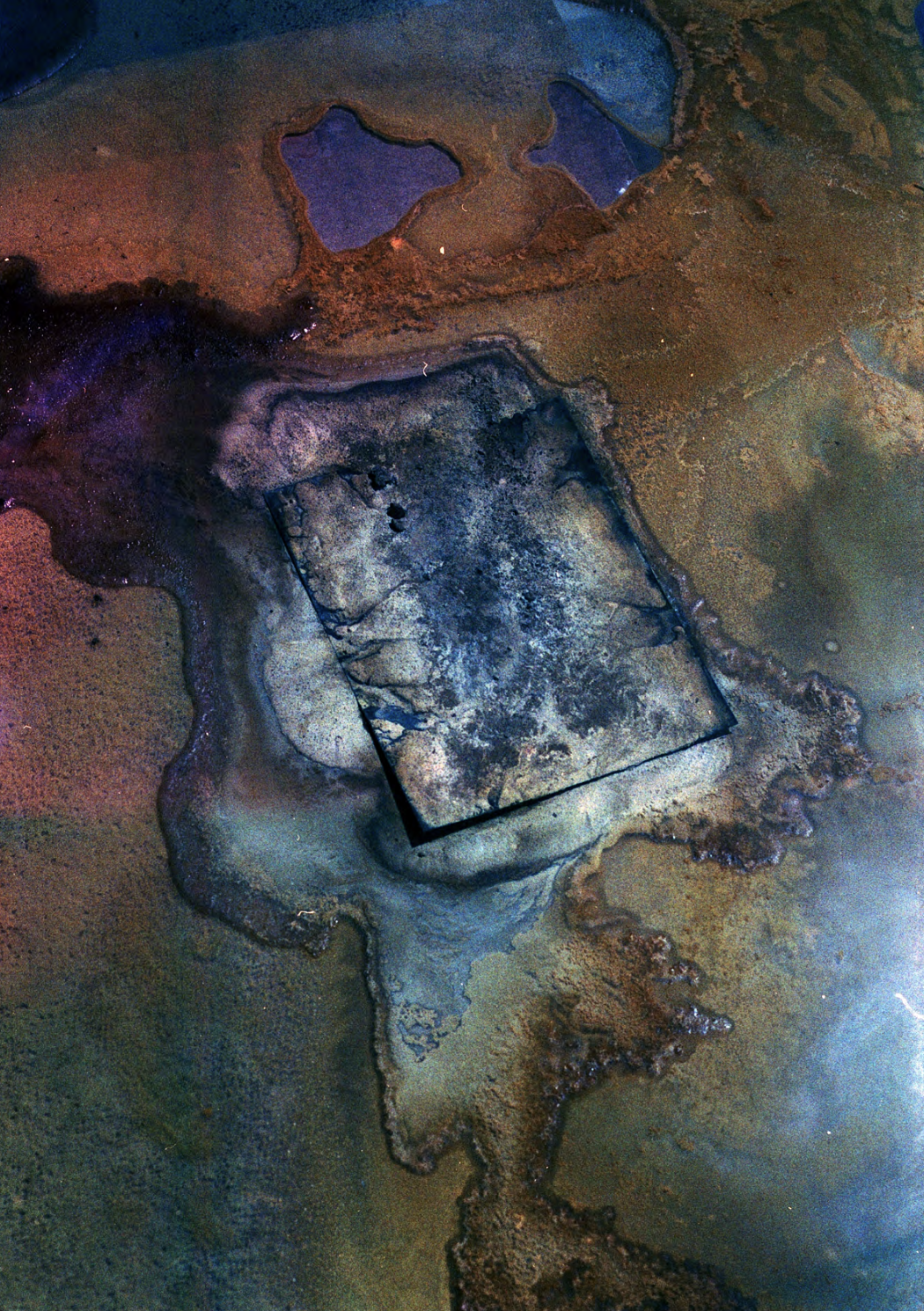
Why did the atomic bomb dropped on Hiroshima leave peoples shadows etched on sidewalks?

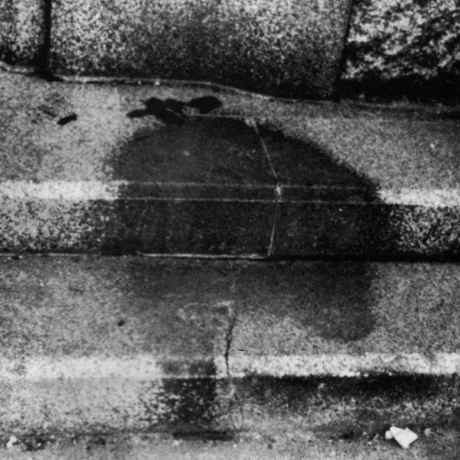
Hito Kage No Ishii, Nuclear shadow prints after the Hiroshima bombings. Photo: Universal History Archive / Getty Images
6 August 1945 is the day when an American B-29 bomber dropped the world's first atom bomb over the city of Hiroshima, Japan, during the ongoing World War II. The fireball (with a surface temperature of 5,000 degrees Celsius) ignited every flammable material for over 3.5 kilometers, creating a firestorm that lasted for six hours. To put things in perspective: of the 90,000 buildings in Hiroshima, only 28,000 remained; of the city's 200 doctors, only 20 were left alive or capable of working.

Electron microscopy (EM) is currently the method of choice for examining subcellular structures. It is used as a medical imaging method.
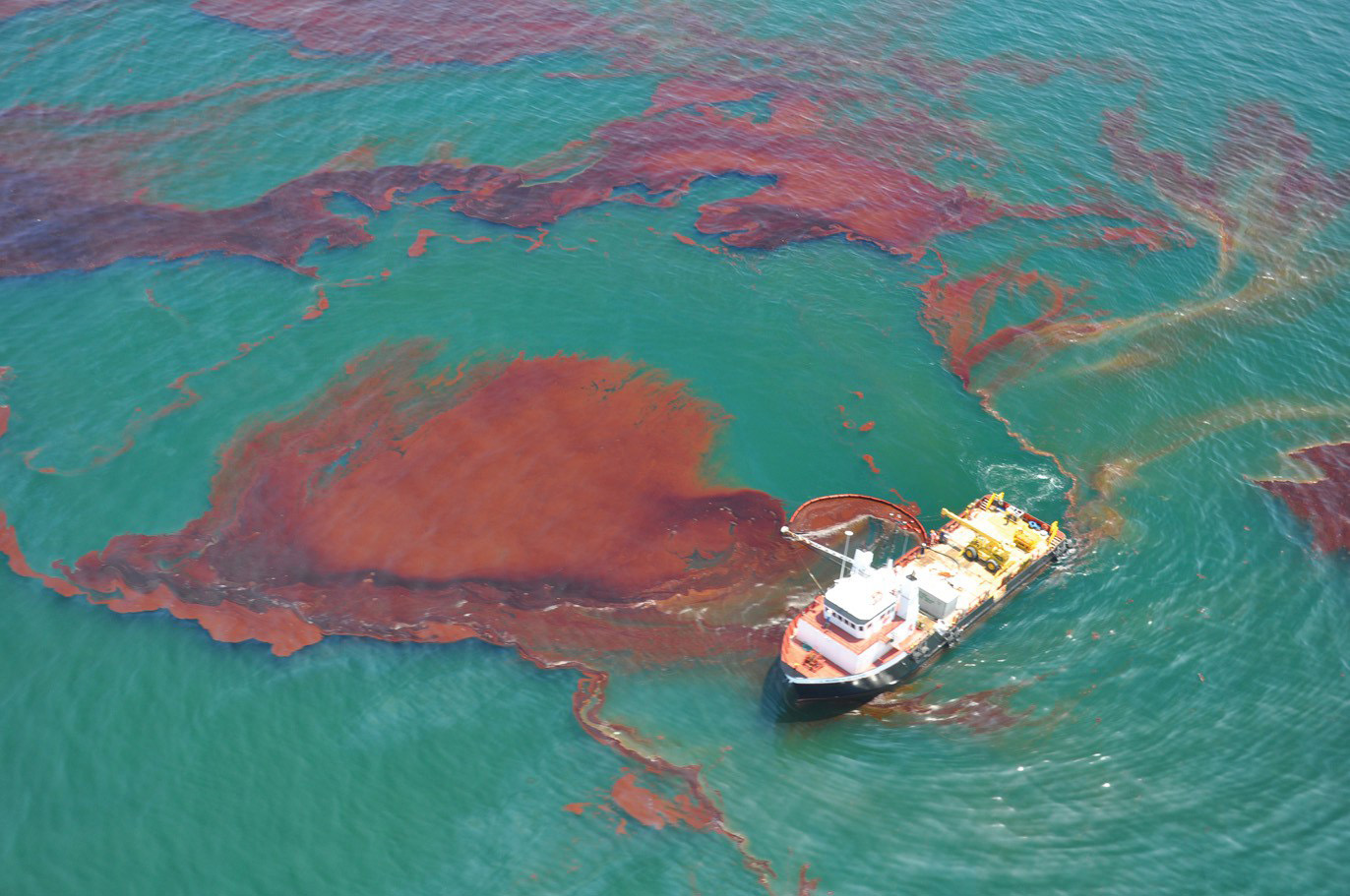


FIRE
WEATHER
INDEX
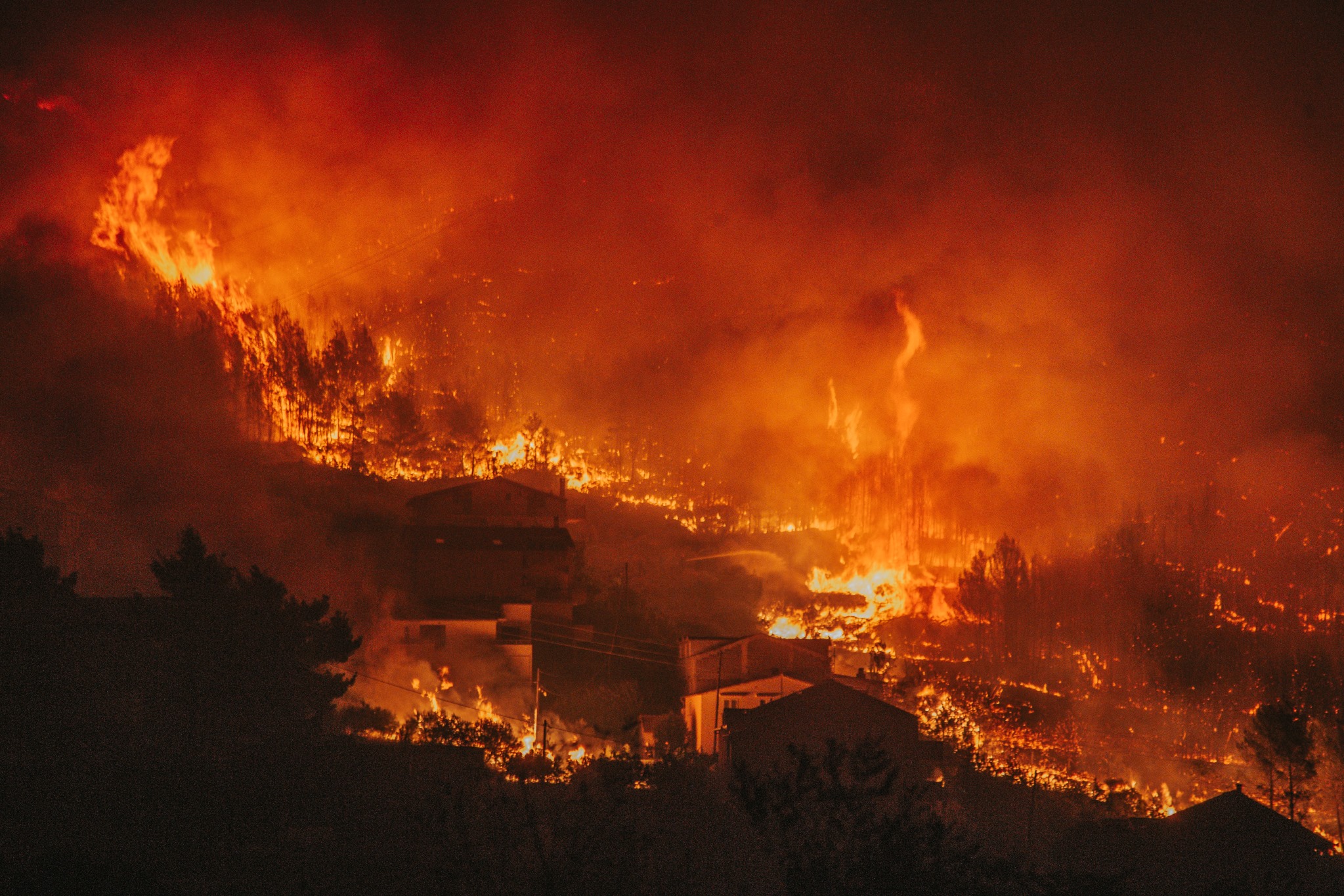
Extreme heat wave sparks wildfires in parts of Europe, july 2022, © Damira Kalajzic
BIOTIC
+
ABIOTIC
abiotic/ˌeɪbʌɪˈɒtɪk/adjective
relating to things in the environment that are not living
physical rather than biological; not derived from living organisms."abiotic chemical reactions"
devoid of life; sterile.
#temperature #lightintensity #humidity #wind #sunlight #water #minerals #light #air #soil #climate #atmosphere #pH #salinity
biotic/bʌɪˈɒtɪk/adjective
- involving, caused by, or relating to living things in the environment:
- relating to or resulting from living organisms."biotic interactions"
- living things
#bacteria #virus #animals #plats #fungus #animals #humans #archaea #protists

Gaston Bachelard uses water (as he does elsewhere with the other elements) as an endlessly generative image, as a way of gathering language around an image, and re-imagining the world. And, as in all his work, the tension between reverie and rationalism keeps the discourse alive. “Here…materialism, imagined through the material imagination, takes on a sensitivity so sharp, so painful, that it can understand all the woes of an idealistic poet.”
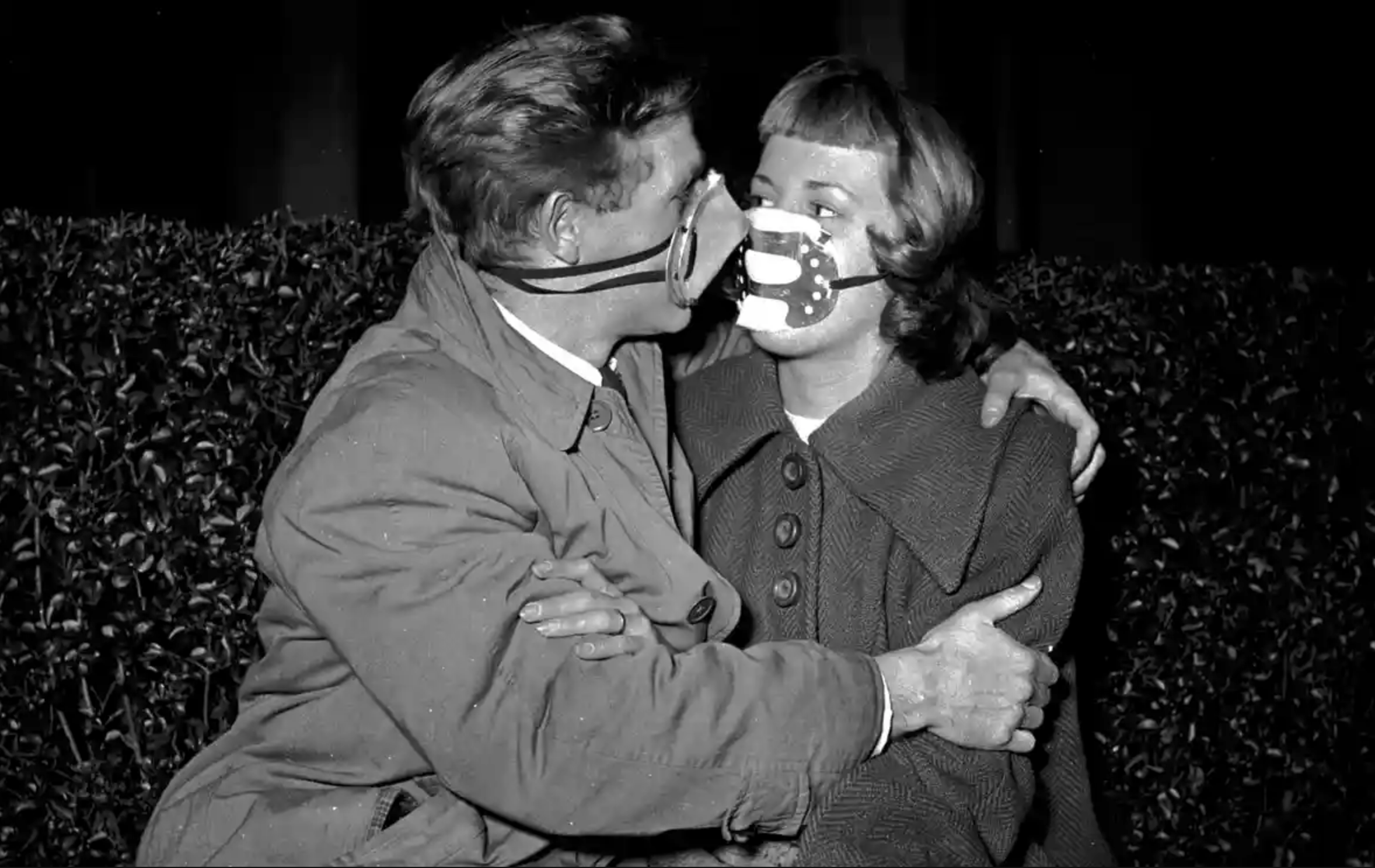 A couple in London, in 1952, wearing masks because of air pollution. Photograph: Juliette Lasserre/Getty
A couple in London, in 1952, wearing masks because of air pollution. Photograph: Juliette Lasserre/Getty Police using flames at Marble Arch to direct the traffic in the 1952 London smog. Photograph: Trinity Mirror/Alamy
Police using flames at Marble Arch to direct the traffic in the 1952 London smog. Photograph: Trinity Mirror/Alamy
What artists do is open different portals. Art shows us the ways in which material can be modelled, shifted, transformed.
- Otobong Nkanga
"How do we actively engage with the lived experiences of forms of nonhuman bios whose existences are today increasingly incorporated in the cultural world of human techne? How do we acknowledge “their” agency, and our involvement with it, without denying the asymmetrical power historically developed by human agencies in bios? How do we engage with accountable forms of ethico-political caring that respond to alterity without nurturing purist separations between humans and nonhumans? How do we engage with the care of Earth and its beings without idealizing nature nor diminishing human response-ability by seeing it as either inevitably destructive or mere paternalistic stewardship?"
Matters of Care: Speculative Ethics in More than Human Worlds, María Puig de la Bellacasa, 2017, University of Minnesota Press, p.144
![]()
A giant image of a flea projected using an eighteenth-century solar microscope.
“Life is not only about matter and how it immediately interacts with itself but also how matter interacts in interconnected systems that include organisms in their separately perceiving worlds – worlds that are necessarily incomplete, even for scientists and philosophers who, like there objects of study, form only a tiny part of the giant perhaps infinite universe they observe”
(Dorian Sagan, A Foray into the Worlds of Animals and Humans, with a Theory of Meaning, 1934)
Concerning metrics: I think you should resist being obsessed with metrics. There are a lot of people for whom metrics is a form of practice, and others who have to measure things because they are forced to. However there is a middle ground between the two, which is to believe in the power of cultural transformation. What I appreciate about Atelier Luma is that philosophers and artists are considered as important as scientists and systemic experts. This is the most crucial point in my opinion. You don’t need to measure impact if you can tell a persuasive story about your activity in the world.
ALGAE REVIEW #8, John Thackara
Phytoremediation
F.ex. the mustard plant is used in phytoremediation to remove heavy metals, such as lead, from the soil in hazardous waste sites because it has a higher tolerance for these substances and stores the heavy metals in its cells. In particular,
Brassica juncea was particularly effective at removing cadmium (Cd) from soil. The process of removing heavy metals ends when the plant is harvested and properly discarded. Phytoremediation has been shown to be cheaper and easier than traditional methods for heavy metal reduction in soils. In addition, it has the effect of reducing soil erosion, reducing cross-site contamination.
![]()
Berenice Abbott, Magnetic Field, Gelatin silver print, 1958
![]() Berenice Abbott, Penicillin mold, from the series Photo-illustrations from the Physical Science Study Committee of the Massachusetts Institute of Technology and other scientific studies, Gelatin silver print, 1946
Berenice Abbott, Penicillin mold, from the series Photo-illustrations from the Physical Science Study Committee of the Massachusetts Institute of Technology and other scientific studies, Gelatin silver print, 1946
![]()
Oliver Raymond-Barker, Anatomy of Stone, 30x40cm, chemigram, 2019
![]()
Andreas Ritter von Ettingshausen, Section of clematis, 1840, Daguerrotype
The earliest surviving example of successful achievement is Ettingshausen's daguerreotype of a cross section of a Clematis plant, made by "hydrogen cold light", in five minutes of exposure, in Vienna, on March 4, 1840.
![]()
Ragna Robertsdottir, Saltscape 23rd April 2020, 2020, 30x30cm, Sea salt and hot spring mud
These works are made of either sea salt or black lava salt mixed with water and poured on panes of glass; as the water evaporates, the salt adheres to the glass in a process that is part meticulous plan and part chance.
![]()
![]()
![]()
![]()
![]()
![]()
![]() HerHere
HerHere
Charlotte Greenwood, Warming, 2020
A series of ice photograms that offer viewers a closer look at a geographically distant effect of climate change: the melting polar ice caps.
![]()
S&D#025: Dries Segers, Mudgram (51.343429, 3.807765), 2025, 795x566cm.
Here shown near Vaartkom, Leuven, which contains the highest PFAS levels in the city of Leuven.
- Otobong Nkanga
"How do we actively engage with the lived experiences of forms of nonhuman bios whose existences are today increasingly incorporated in the cultural world of human techne? How do we acknowledge “their” agency, and our involvement with it, without denying the asymmetrical power historically developed by human agencies in bios? How do we engage with accountable forms of ethico-political caring that respond to alterity without nurturing purist separations between humans and nonhumans? How do we engage with the care of Earth and its beings without idealizing nature nor diminishing human response-ability by seeing it as either inevitably destructive or mere paternalistic stewardship?"
Matters of Care: Speculative Ethics in More than Human Worlds, María Puig de la Bellacasa, 2017, University of Minnesota Press, p.144

A giant image of a flea projected using an eighteenth-century solar microscope.
“Life is not only about matter and how it immediately interacts with itself but also how matter interacts in interconnected systems that include organisms in their separately perceiving worlds – worlds that are necessarily incomplete, even for scientists and philosophers who, like there objects of study, form only a tiny part of the giant perhaps infinite universe they observe”
(Dorian Sagan, A Foray into the Worlds of Animals and Humans, with a Theory of Meaning, 1934)
Concerning metrics: I think you should resist being obsessed with metrics. There are a lot of people for whom metrics is a form of practice, and others who have to measure things because they are forced to. However there is a middle ground between the two, which is to believe in the power of cultural transformation. What I appreciate about Atelier Luma is that philosophers and artists are considered as important as scientists and systemic experts. This is the most crucial point in my opinion. You don’t need to measure impact if you can tell a persuasive story about your activity in the world.
ALGAE REVIEW #8, John Thackara
THE MUSHROOM SPEAKS (2021), a film by Marion Neumann
Phytoremediation
F.ex. the mustard plant is used in phytoremediation to remove heavy metals, such as lead, from the soil in hazardous waste sites because it has a higher tolerance for these substances and stores the heavy metals in its cells. In particular,
Brassica juncea was particularly effective at removing cadmium (Cd) from soil. The process of removing heavy metals ends when the plant is harvested and properly discarded. Phytoremediation has been shown to be cheaper and easier than traditional methods for heavy metal reduction in soils. In addition, it has the effect of reducing soil erosion, reducing cross-site contamination.

Berenice Abbott, Magnetic Field, Gelatin silver print, 1958
 Berenice Abbott, Penicillin mold, from the series Photo-illustrations from the Physical Science Study Committee of the Massachusetts Institute of Technology and other scientific studies, Gelatin silver print, 1946
Berenice Abbott, Penicillin mold, from the series Photo-illustrations from the Physical Science Study Committee of the Massachusetts Institute of Technology and other scientific studies, Gelatin silver print, 1946
Oliver Raymond-Barker, Anatomy of Stone, 30x40cm, chemigram, 2019
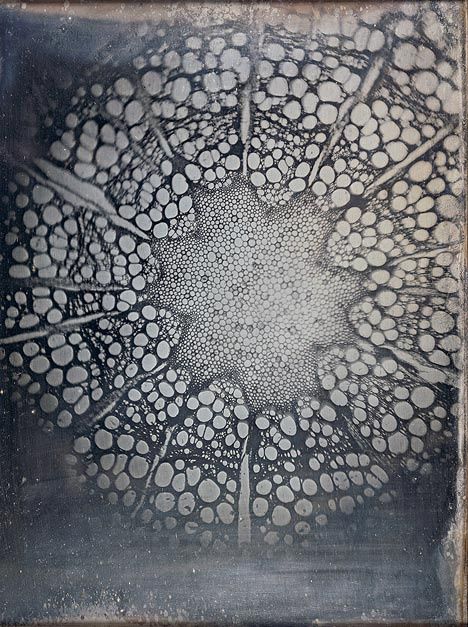
Andreas Ritter von Ettingshausen, Section of clematis, 1840, Daguerrotype
The earliest surviving example of successful achievement is Ettingshausen's daguerreotype of a cross section of a Clematis plant, made by "hydrogen cold light", in five minutes of exposure, in Vienna, on March 4, 1840.
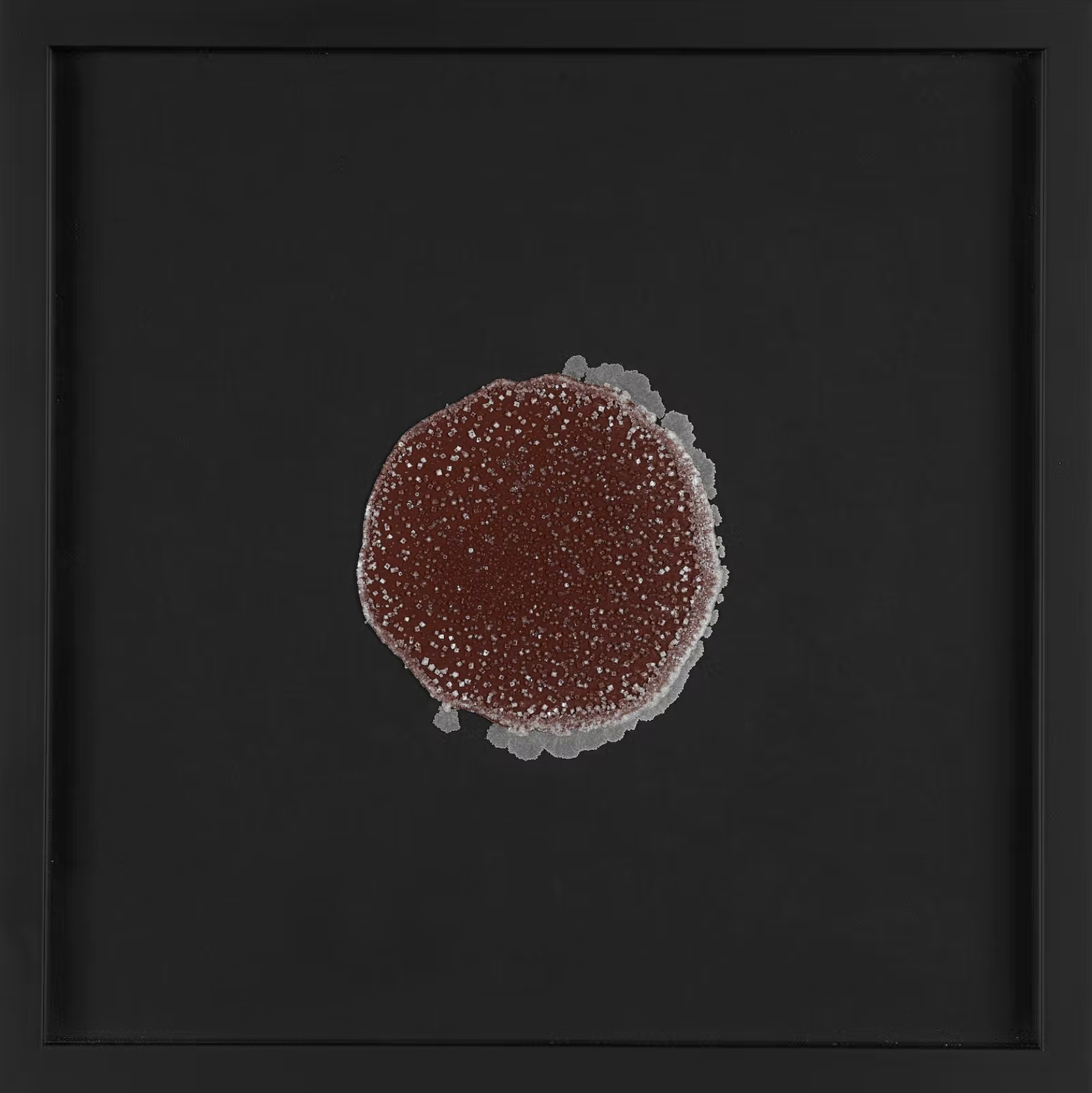
Ragna Robertsdottir, Saltscape 23rd April 2020, 2020, 30x30cm, Sea salt and hot spring mud
These works are made of either sea salt or black lava salt mixed with water and poured on panes of glass; as the water evaporates, the salt adheres to the glass in a process that is part meticulous plan and part chance.

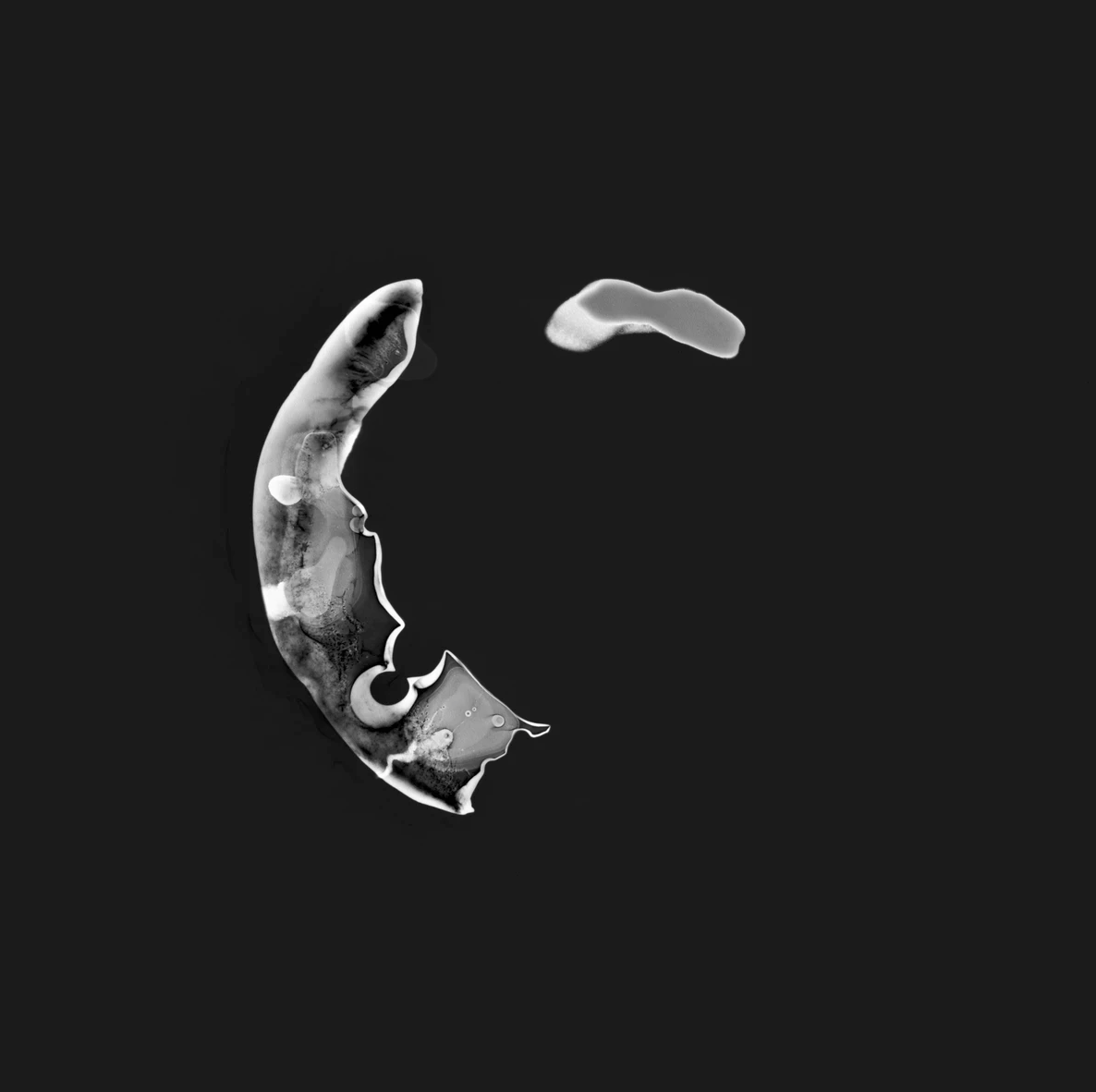



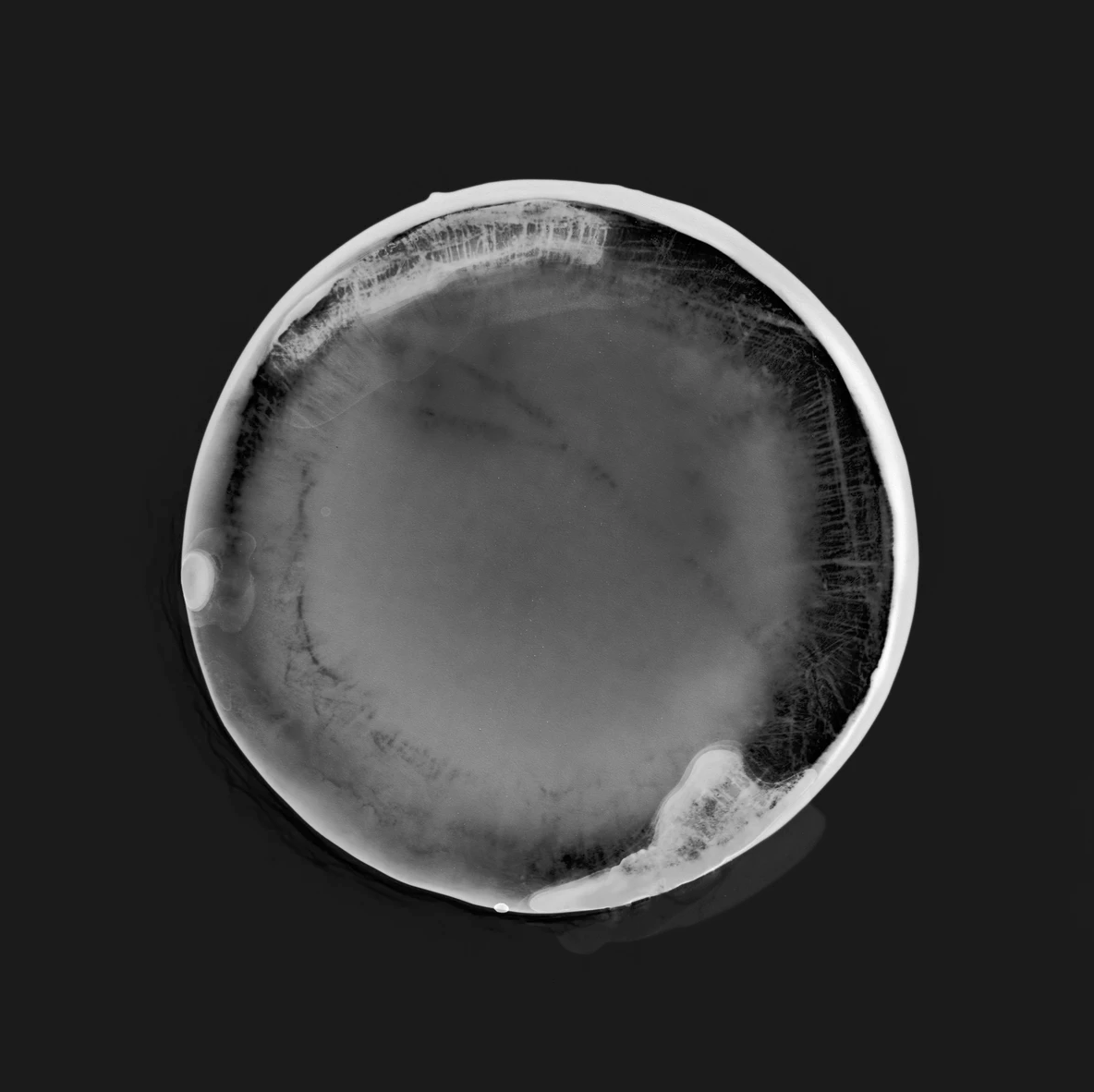

Charlotte Greenwood, Warming, 2020
A series of ice photograms that offer viewers a closer look at a geographically distant effect of climate change: the melting polar ice caps.
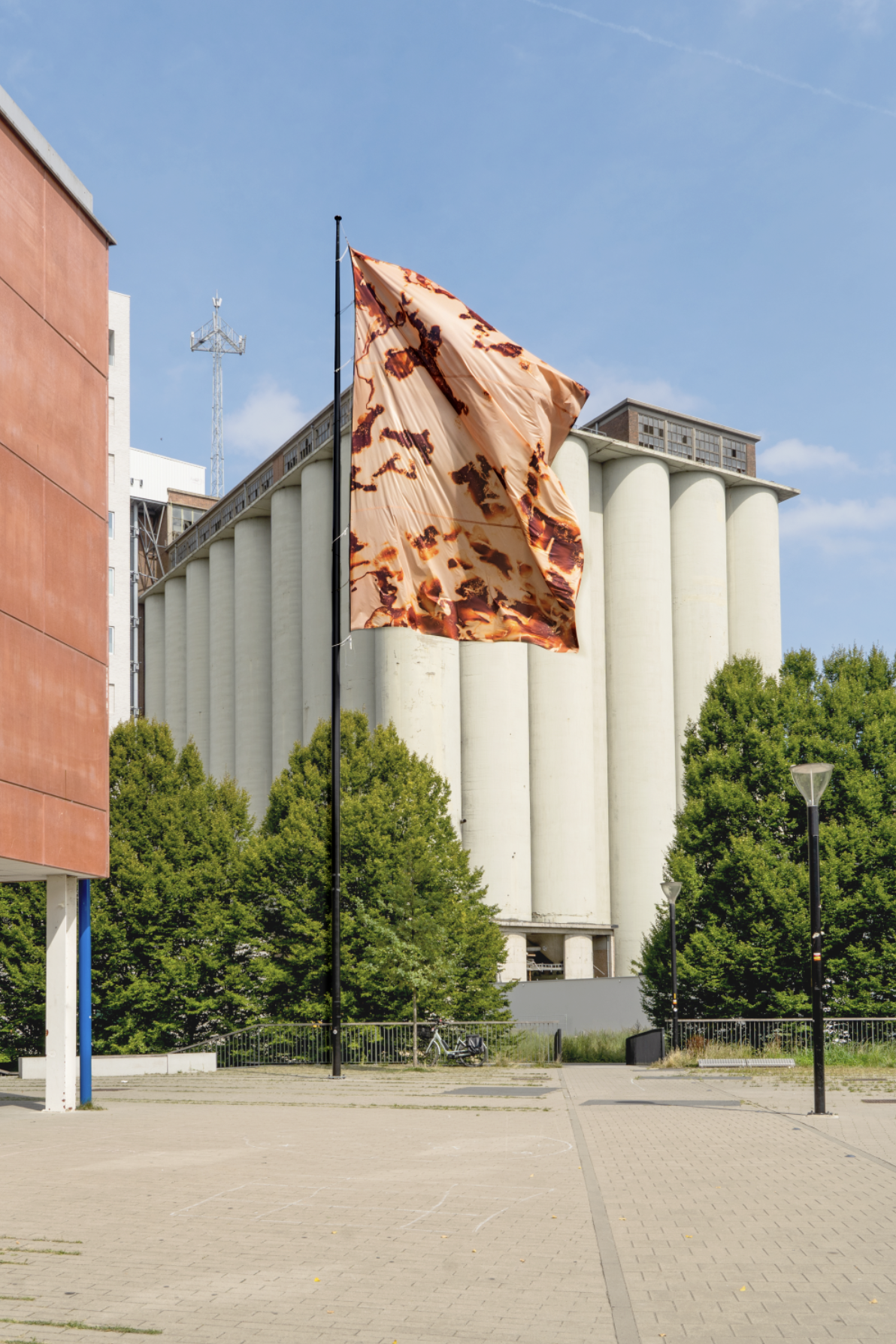
S&D#025: Dries Segers, Mudgram (51.343429, 3.807765), 2025, 795x566cm.
Here shown near Vaartkom, Leuven, which contains the highest PFAS levels in the city of Leuven.
WORLDS WORLD WORLDS
ALMANAC
In order to change ourselves, to take on different ways of thinking about the world, we need new ways of seeing it. We are accustomed, largely by scientific practice, to taking things apart, separating them into their component attributes, fixing them for study, piece by piece reducing their collective agency until they have none at all. But this is the opposite of ecology, which seeks to find connections between all things and resolve them into greater, inter connected systems. The lens required now is not a microscope, but a macroscope; a device for seeing at a fas vaster scale - both in space and time - than we are used to.
- James Bridle, Ways of Being: Beyond Human Intellegence, 2022, Penguin Books, p 125
![]()
New Materialism means giving matter is due. It engenders fascination with strange, brute, magnificent materials whose properties guide work that relies on scant formal or intellectual preconceptions but remains open to the provocations of emergent materialities and their innate qualities in a journey of shared participation that is active/passive: a reciprocal, irreducible process of becoming, where bodies and other materials are conjoined in a shared artistry.
- Diane Coole, Realism Materialsm Art, eds. C. Cox, J. Jaskey, S. Malik, 2015, Sternberg Press, ISBN 978-3-95679-126-0
![]()
Tomás Saraceno, Hybrid Webs, seen in Palais de Tokyo, 2017
O slow fish
show me the way
O Green weed
grow me the way
The way yo go
the way you grow
is the way indeed
O bright Sun
light me the way
the right way
the one
no one can say
If one can choose it
it is wrong
Sing me the way
O song:
No one can lose it
for long
Ursula K. Le Guin, Tao Song, poem from Three Poems from Wild Angels
Narrated by Ursula K. Le Giun herself
![]()
ALMANAC
In order to change ourselves, to take on different ways of thinking about the world, we need new ways of seeing it. We are accustomed, largely by scientific practice, to taking things apart, separating them into their component attributes, fixing them for study, piece by piece reducing their collective agency until they have none at all. But this is the opposite of ecology, which seeks to find connections between all things and resolve them into greater, inter connected systems. The lens required now is not a microscope, but a macroscope; a device for seeing at a fas vaster scale - both in space and time - than we are used to.
- James Bridle, Ways of Being: Beyond Human Intellegence, 2022, Penguin Books, p 125
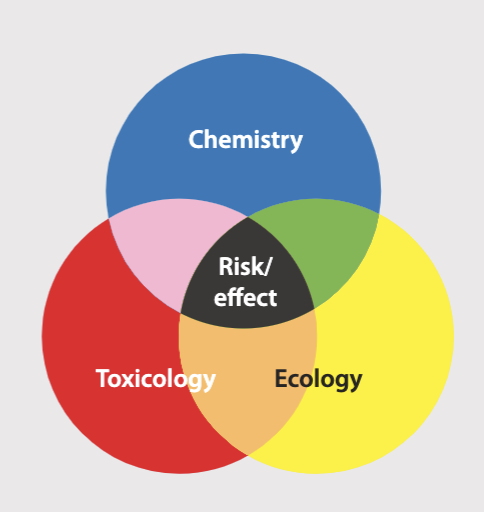
New Materialism means giving matter is due. It engenders fascination with strange, brute, magnificent materials whose properties guide work that relies on scant formal or intellectual preconceptions but remains open to the provocations of emergent materialities and their innate qualities in a journey of shared participation that is active/passive: a reciprocal, irreducible process of becoming, where bodies and other materials are conjoined in a shared artistry.
- Diane Coole, Realism Materialsm Art, eds. C. Cox, J. Jaskey, S. Malik, 2015, Sternberg Press, ISBN 978-3-95679-126-0

Tomás Saraceno, Hybrid Webs, seen in Palais de Tokyo, 2017
O slow fish
show me the way
O Green weed
grow me the way
The way yo go
the way you grow
is the way indeed
O bright Sun
light me the way
the right way
the one
no one can say
If one can choose it
it is wrong
Sing me the way
O song:
No one can lose it
for long
Ursula K. Le Guin, Tao Song, poem from Three Poems from Wild Angels
Narrated by Ursula K. Le Giun herself

 Spending the War Without You,
Spending the War Without You, Norton Lecture series with Laurie Anderson, 2021, Harvard University Department of Music
The River
The Forest
The Rocks
The Road
The City
The Birds
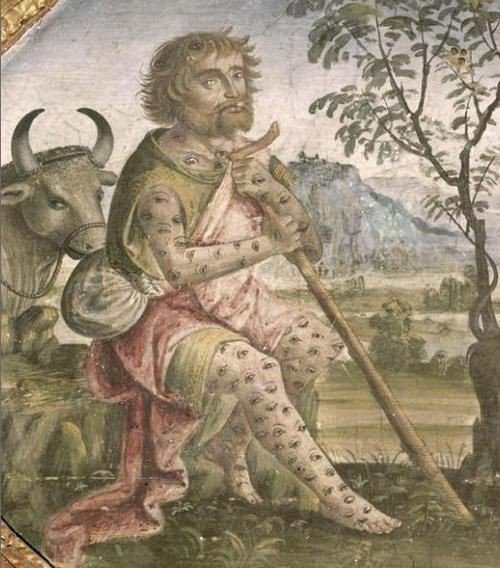 Argus Panoptes (All-seeing;
Ancient Greek: Ἄργος Πανόπτης)
Argus Panoptes (All-seeing;
Ancient Greek: Ἄργος Πανόπτης)“Imagine a world alive with incomprehensible objects, and shimmering with an endless variety of movement and innumerable gradations of colour. Imagine a world before the 'beginning was the word.”
- Stan Brakhage
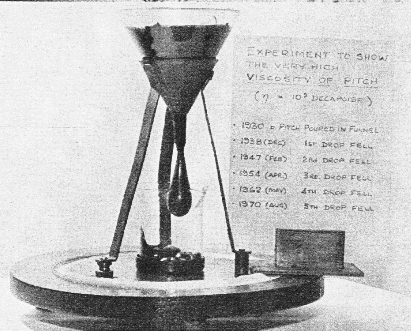 The Pitch Drop Experiment
The Pitch Drop Experimenthttps://livestream.com/uq/events/5369913/videos/129913304
This experiment was using asphalt, also a component in photographic practices in early 20th century.
︎︎︎Vinciane Despret in conversation with Tomás Saraceno
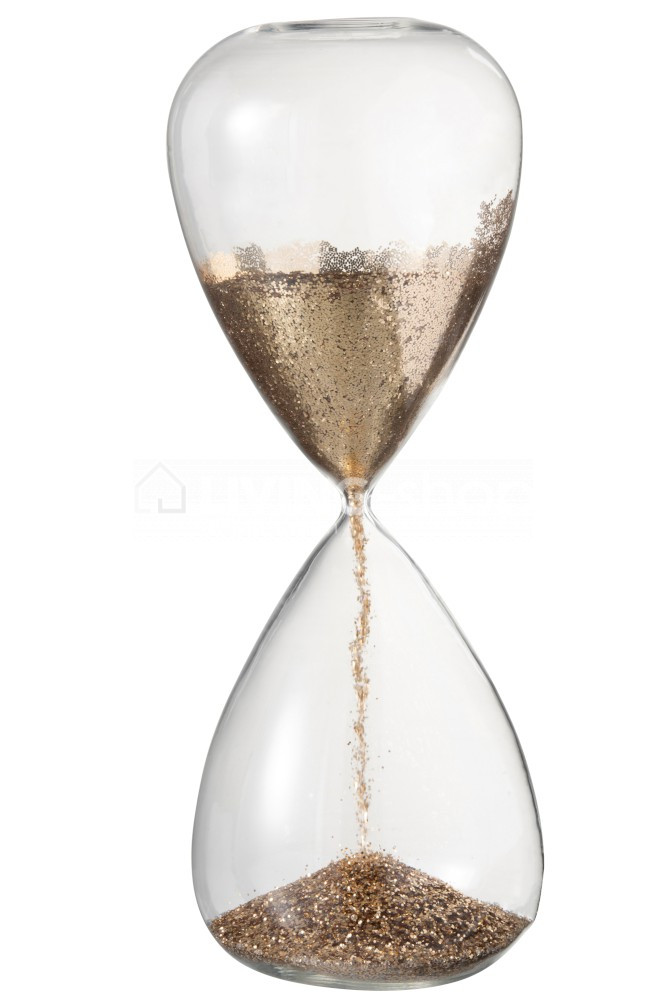
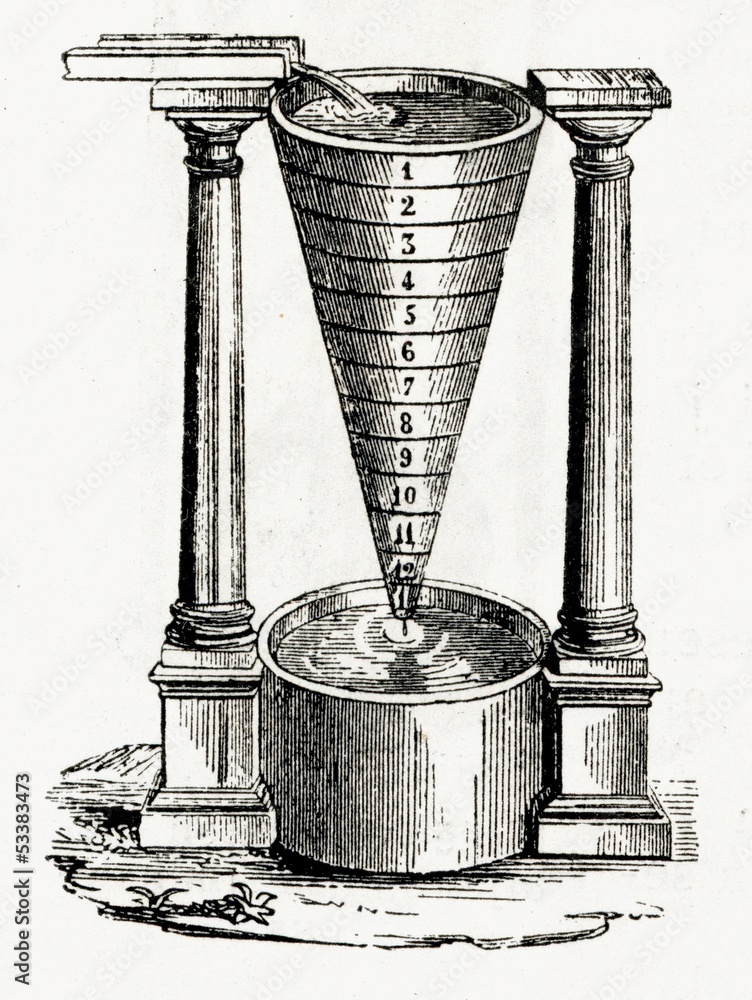
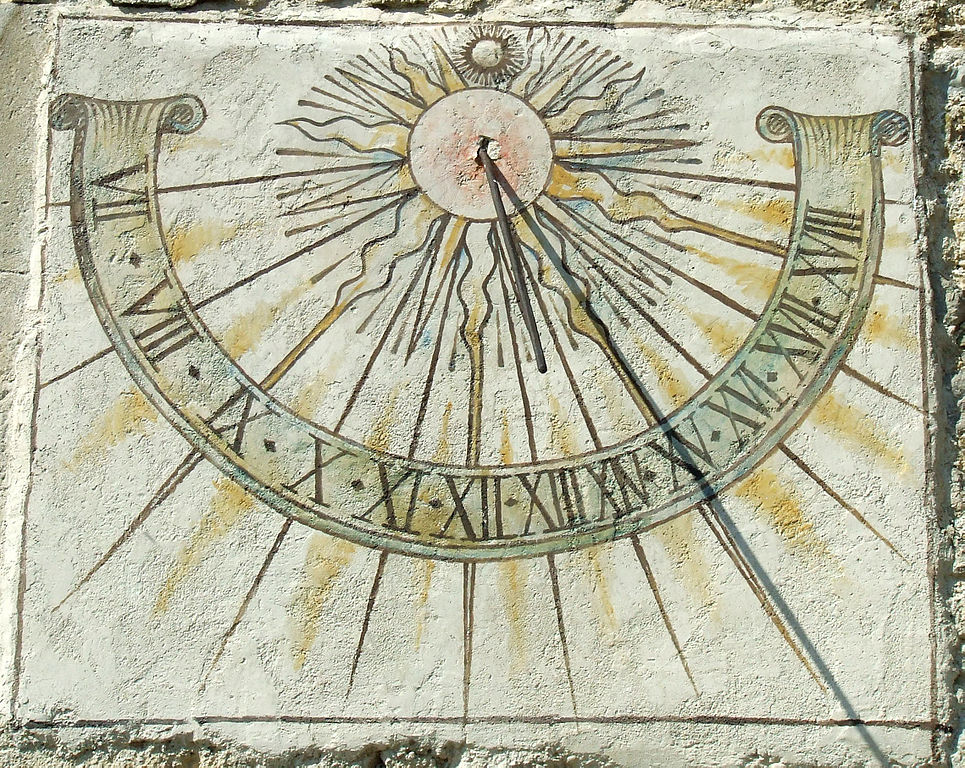

Waterclock, Sand timer, Sun clock or Sundial, Candle Clock
“If material emerges from our apparatus, they would be closely paired in one-to-one relations: our apparatus, our material. We leave aside the material reacting across it’s varied components; we leave aside nonhuman relational apparatuses. Some of this problem is addressed in the scholarly turn to multiplicity, which shows us multiple knowledge apparatuses acting simultaneously. Yet as long as human knowledge apparatuses continue to make up the frame through which we know multiplicity, nonhuman makings never enter.”
Anne L. Tsing. When the Things We Study Respond to Each Other. Tools for Unpacking “the Material”, p. 016. In: André Jacque, Otero Verzier, Pietroiusti. More than Human. 2020.
https://phytogram.blog/
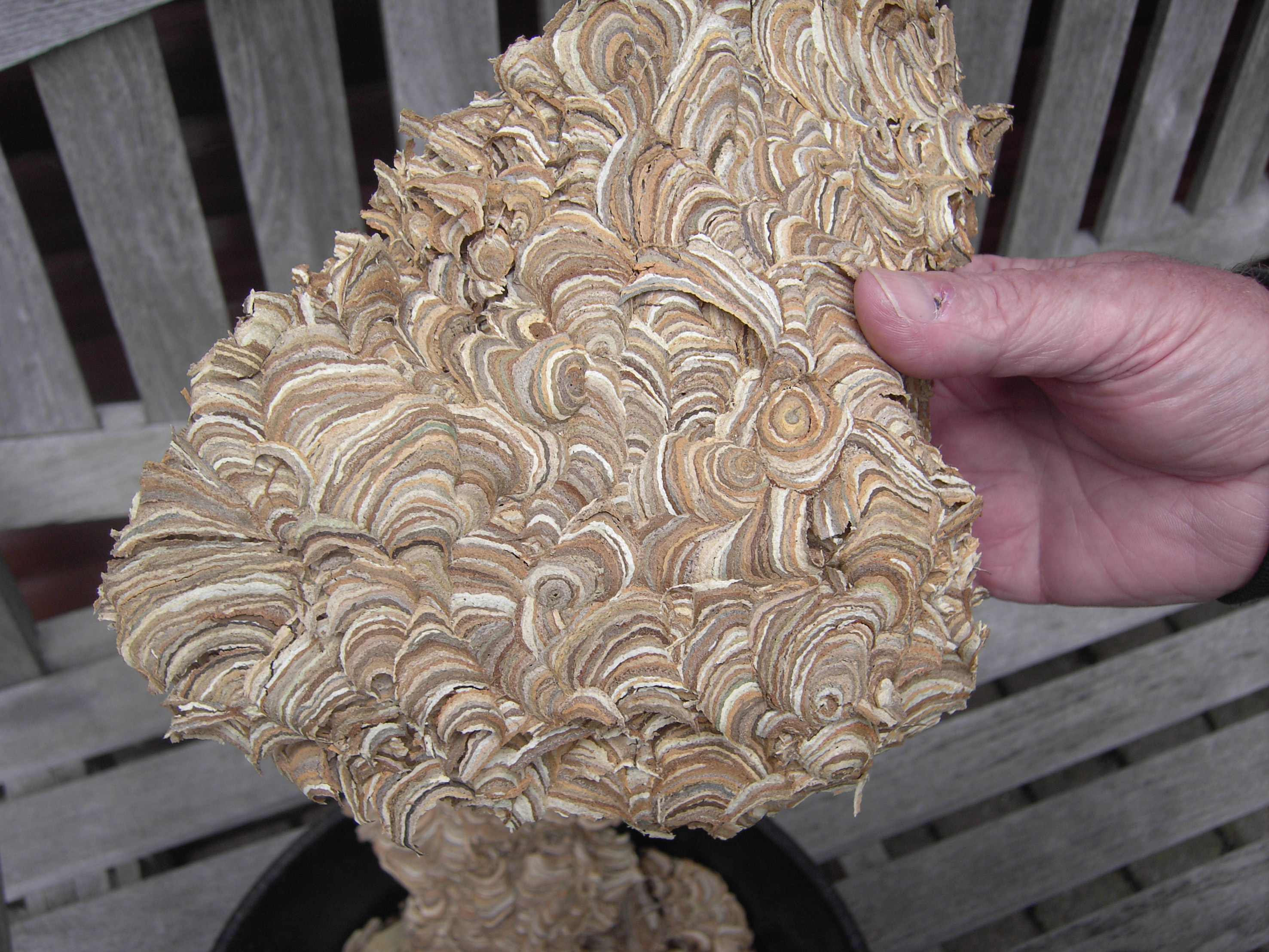
‘Agencies of observation’ are not liberal opinion-bearers, but situated entities made up of humans and non-humans in specific relationships. Reality is not independent of our explorations of it; and reality is not a matter of opinion, but of the material consequences of some cuts and not others made in the fabric of the world.
- Karan Barad
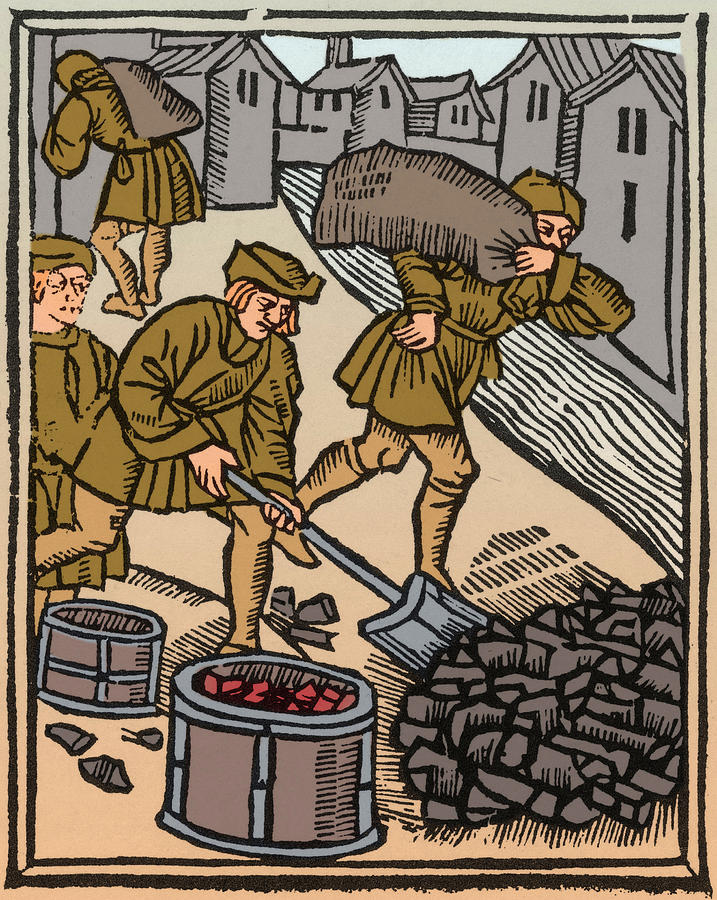
Scenes of a trade charcoal burners. Woodcut, 1500/01. From Les Ordonnances de Paris. A charcoal burner's job was a humble one, but one that in pre industrial society was extremely important. For centuries many trades depended on charcoal as their main source of fuel. Iron working, blacksmithing, brick making, glass making, foundry work such as casting bells and cannons, gold and silversmithing, all used huge quantities of charcoal.

Specimens of Phleum arenarium in the John Henslow Herbarium, Cambridge University.
John Stevens Henslow is perhaps best known today as Charles Darwin’s botany teacher at Cambridge University.

Cd, Cadmonium, atomic number 48
This soft, silvery-white metal is chemically similar to the two other stable metals in group 12, zinc and mercury.
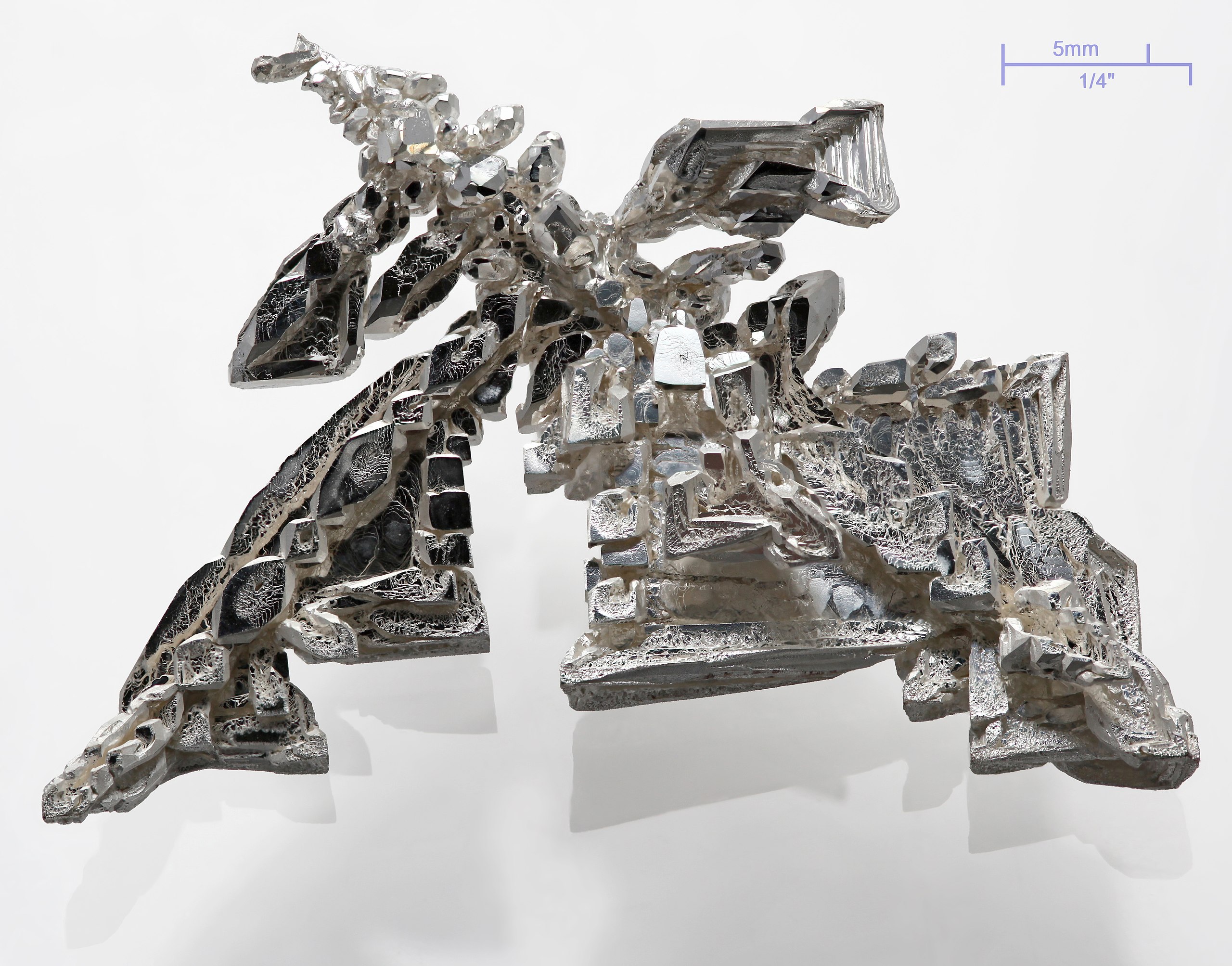
Ag, Silver, atomic number 47
A soft, white, lustrous transition metal, it exhibits the highest electrical conductivity, thermal conductivity, and reflectivity of any metal.
Material makes more than one language possible.
- Cildo Meireles



Eva-Fiore Kovacovsky, Variation as Nature, 2018

Ketuta Alexi-Meskhishvili, Danama, 2021 Inkjet print on organic cotton 138x110 cm
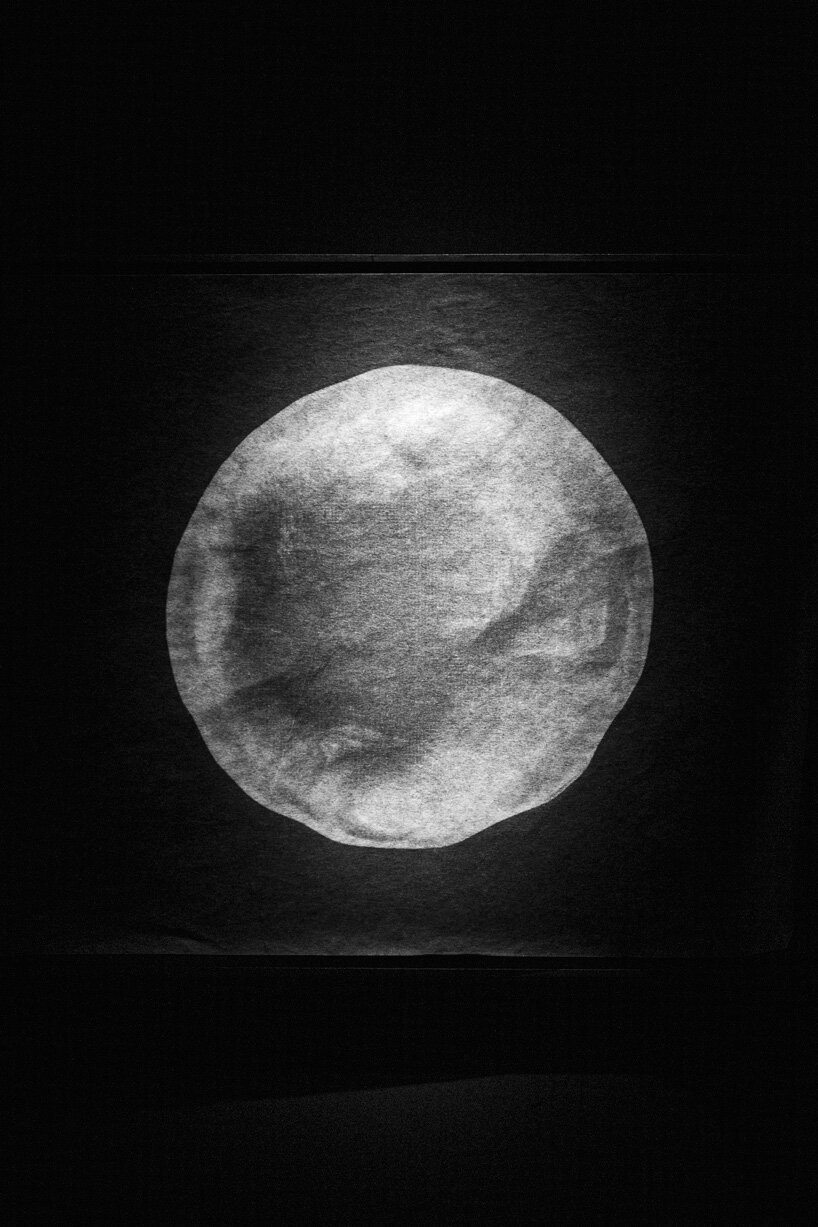
Tomás Saraceno, Printed Matter(s), 2018
Printed Matter(s) is a series of photo giclée prints made with an ink of black carbon PM2.5 pollution sequestered from the air in Mumbai, printed on eight-gram handmade paper. These prints reproduce images of cosmic dust from a 1982 special issue of the NASA Cosmic Dust Catalog, entangling the celestial and the terrestrial, the cosmic and the atmospheric. An approximated 40,000 tons of interplanetary dust falls to the surface of Earth every year; a speck of cosmic material touches every person every day everywhere around the world. In these prints, the material with which the air has been poisoned becomes a tool for the air to communicate, reminding us of its ever-present agency even in the face of efforts to destroy it.

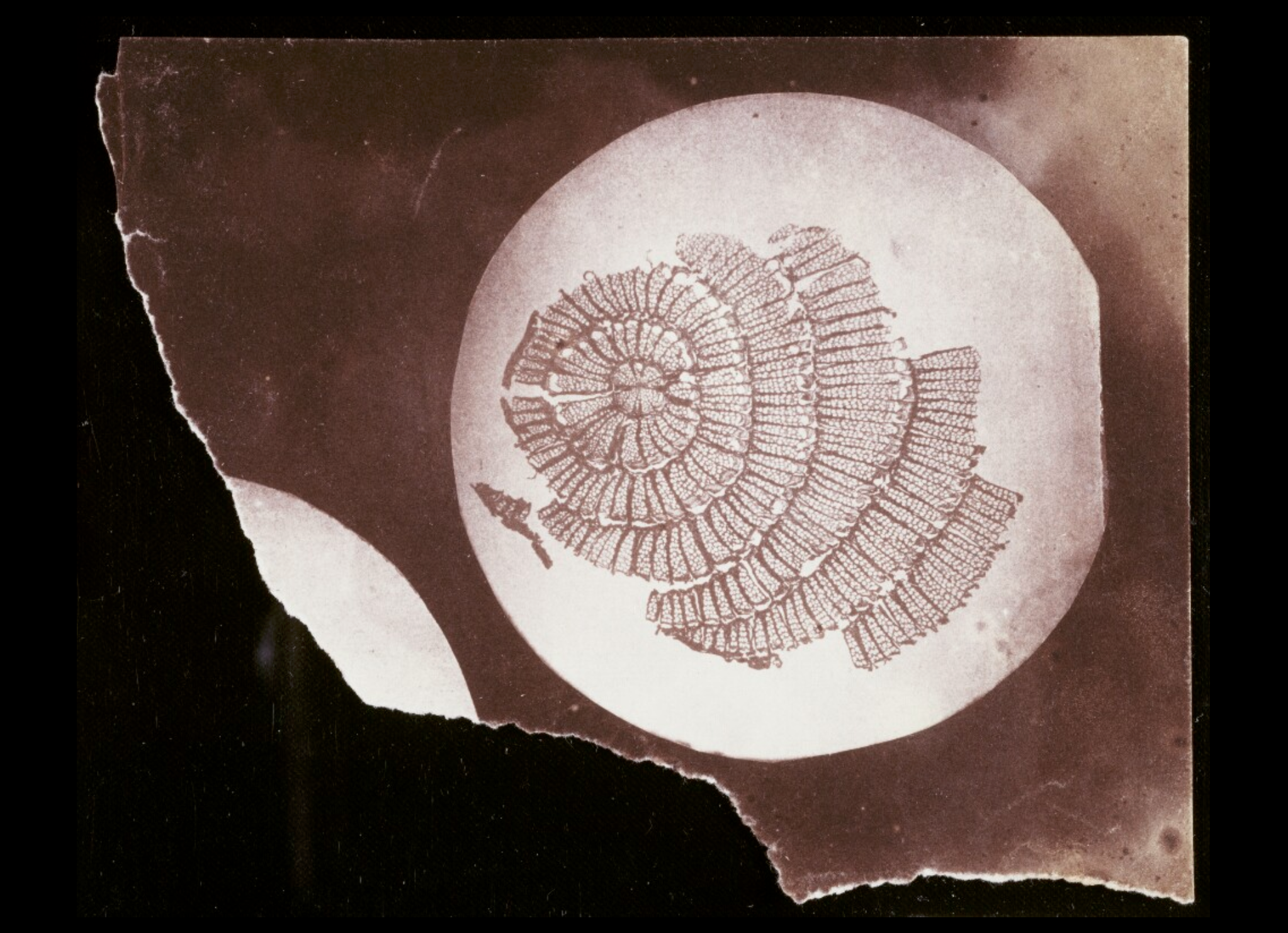 Henry Fox Talbot, Photomicrograph of a section of a plant stem as viewed in a solar microscope, Salted Paper Print, 12.0cm x w 18.9cm, collection National Science and Media Museum
Henry Fox Talbot, Photomicrograph of a section of a plant stem as viewed in a solar microscope, Salted Paper Print, 12.0cm x w 18.9cm, collection National Science and Media Museum
herman de vries, From earth: worldwide, 2018, Earth rubbings on paper, 103 x 144cm
WORLDS WORLD WORLDS
ALMANAC
Karen Barad intra-acts with the thematics of Manuela Infante’s latest piece Horizon. <3 This is highly recommended.
ALMANAC
Karen Barad intra-acts with the thematics of Manuela Infante’s latest piece Horizon. <3 This is highly recommended.
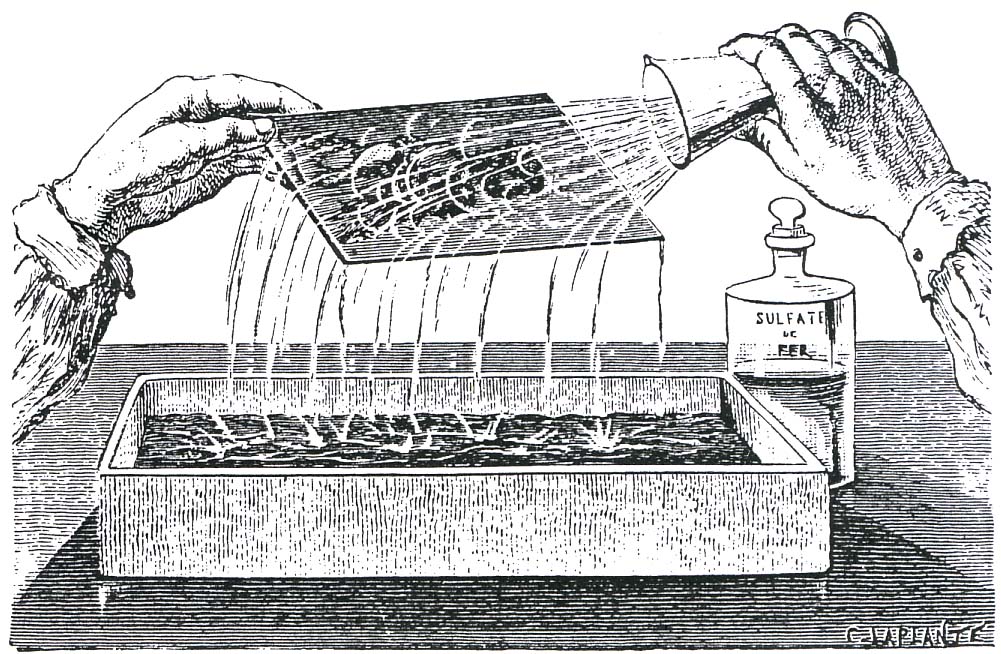
Critical Zones, exibition at ZKM Karlsruhe, Germany, Online discussion on the Film »Storytelling for Earthly Survival« with Donna Haraway (biologist, philosopher, feminist), Bruno Latour and Peter Weibel
Light changes the nature of many chemical substances.
- Cildo Meireles
For the past year, located around the buildings and on the balcony of East Street Arts in Leeds, has been home to our Photographic Garden. This small collection of planters, plants, compost bins, water butts and structures has been a site for research and experimentation. It is a site for trial and error, and a place to develop and grow.
“Science describes accurately from the outside; poetry describes accurately from the inside. Science explicates; poetry implicates. Both celebrate what they describe. We need the languages of both science and poetry to save us from merely stockpiling endless ‘informaBon’ that fails to inform on our ignorance or our irresponsibility.”
(Ursula K. Le Guin, Deep in Admiration, 2017)
[Chorus 1]
We are the earth intruders
We are the earth intruders
Muddy with twigs and branches
[Pre-Chorus 1]
Turmoil
Carnage
[Chorus 2]
Here come the earth intruders
We are the paratroopers
Stampede of sharp shooters
Come straight from voodoo
[Verse 1]
With our feet thumping
With our feet marching
Grinding skeptics
Into the soil
[Pre-Chorus 2]
Shower of goodness coming to end
The doubt pouring over
Shower of goodness coming to end
[Chorus 3]
We are the earth intruders
We are the sharp shooters
Flock of parachuters
Necessary voodoo
[Bridge]
I have guided my bones through some voltage
And love them still
And love them too
[Pre-Chorus 3]
Metallic
Carnage
Furiocity
Feel the speed
[Chorus 3]
We are the earth intruders
We are the sharp shooters
Flock of parachuters
Necessary voodoo
[Verse 2]
There is turmoil out there
Carnage, rambling
What is to do but dig
Dig bones out of earth
[Pre-Chorus 4]
Mud graves
Timber
Morbid trenches
[Chorus 4]
Here come the earth intruders
There'll be no resistance
We are the canoneerers
Necessary voodoo
[Chorus 1]
We are the earth intruders
We are the earth intruders
Muddy with twigs and branches
- Björk
We are the earth intruders
We are the earth intruders
Muddy with twigs and branches
[Pre-Chorus 1]
Turmoil
Carnage
[Chorus 2]
Here come the earth intruders
We are the paratroopers
Stampede of sharp shooters
Come straight from voodoo
[Verse 1]
With our feet thumping
With our feet marching
Grinding skeptics
Into the soil
[Pre-Chorus 2]
Shower of goodness coming to end
The doubt pouring over
Shower of goodness coming to end
[Chorus 3]
We are the earth intruders
We are the sharp shooters
Flock of parachuters
Necessary voodoo
[Bridge]
I have guided my bones through some voltage
And love them still
And love them too
[Pre-Chorus 3]
Metallic
Carnage
Furiocity
Feel the speed
[Chorus 3]
We are the earth intruders
We are the sharp shooters
Flock of parachuters
Necessary voodoo
[Verse 2]
There is turmoil out there
Carnage, rambling
What is to do but dig
Dig bones out of earth
[Pre-Chorus 4]
Mud graves
Timber
Morbid trenches
[Chorus 4]
Here come the earth intruders
There'll be no resistance
We are the canoneerers
Necessary voodoo
[Chorus 1]
We are the earth intruders
We are the earth intruders
Muddy with twigs and branches
- Björk
“Many attempted images cannot survive because they are merely formal play, not truly adapted to the matter they should adorn.”
- Bachelard, Gaston. Earth and Reveries of Will: An Essay on the Imagination of Matter, Texas: Dallas Institute of Humanities and Culture Publications, 2002.
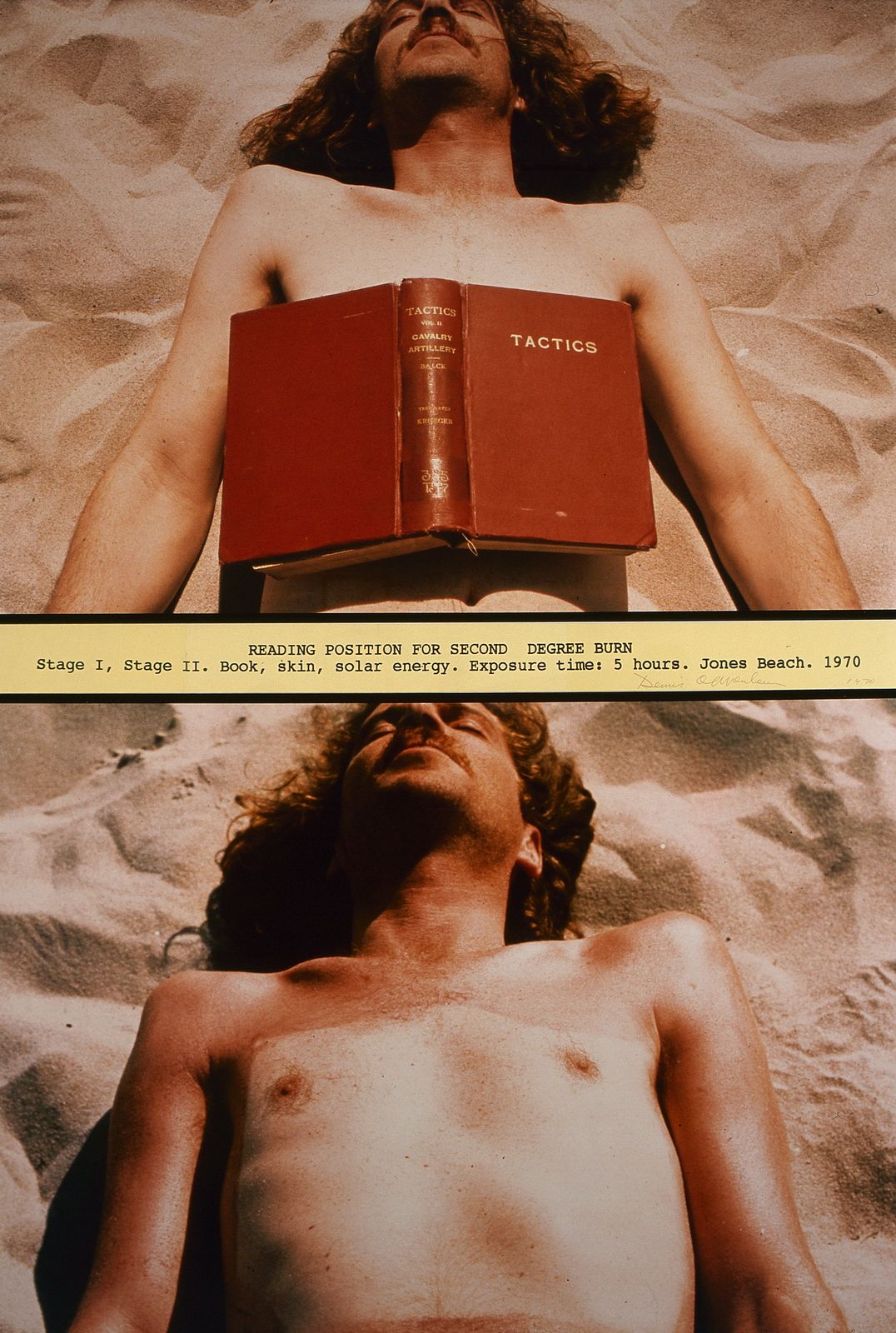
Dennis Oppenheim, Reading Position for Second Degree Burn, 1970, 216 x 152 cm, Colour photography and collage text, IMMA Collection, 2001

The bacterium Rhodococcus ruber eats and actually digests plastic. This has been shown in laboratory experiments by PhD student Maaike Goudriaan at Royal Netherlands Institute for Sea Research (NIOZ). Based on a model study with plastic in artificial seawater in the lab, Goudriaan calculated that bacteria can break down about one percent of the fed plastic per year into CO2 and other harmless substances. "But," Goudriaan emphasizes, "this is certainly not a solution to the problem of the plastic soup in our oceans. It is, however, another part of the answer to the question of where all the 'missing plastic' in the oceans has gone."

Pieter van den Heyden (after Pieter Bruegel de Oude), The Big Fish eat The Little Fish, 1557, gravure, collection Boijmans van Beuningen
Document number: 3458
Date: 21 Feb 1837
Recipient: HENSLOW John Stevens
Author: TALBOT William Henry Fox
Collection: PRIVATE
Lacock Abbey, Chippenham
Feb. 21st. 1837
Dear Sir
I enclose some seeds of the yellow pink rose which you saw at the Bristol meeting last year. Owing to the very unfavourable season the seeds did not ripen so well as I could have wished, but I think they will grow–
Believe me Yours very truly
H.F. Talbot
“It matters what matters we use to think other matters with; it matters what stories we tell to tell other stories with; it matters what knots knot knots, what thoughts think thoughts, what descriptions describe descriptions, what ties tie ties. It matters what stories make worlds, what worlds make stories.”
― Donna J. Haraway, Staying with the Trouble: Making Kin in the Chthulucene
![]()
![]() Anna Atkins, Furcellaria fastigiata,
Anna Atkins, Furcellaria fastigiata,
“Photographs of British Algae,” 1846 or later, The New York Public Library, Astor, Lenox and Tilden Foundations
![]()
Towards the end of Etienne-Jules Marey’s life, he returned to studying the movement of quite abstract forms. His last great work was the observation and photography of smoke trails. (This research was partially funded by Samuel Pierpont Langley under the auspices of the Smithsonian Institution, after the two met in Paris at the Exposition Universelle, 1900.) In 1901 he was able to build a smoke machine with 58 smoke trails. It became one of the first aerodynamic wind tunnels.
![]()
The Royal Prisoner, Sir John Herschel, Anthotype made from red doubler stock (Hibiscus rosa-sinensis), 1839, Harry Ransom Humanities Research Center, The University of Texas at Austin.
![]() Henry Fox Talbot, Photogenic Drawing, 1840
Henry Fox Talbot, Photogenic Drawing, 1840
![]()
Laure Albin Guillot, Microphotographie, 1931, photogravure, MOMA collection
![]()
Thomas Paquet, Et pendant ce temps le soleil tourne, 2020, 92x112cm
![]()
![]()
Pierre-Jules-César Janssen l'atlas de photographies solaires, 1904
― Donna J. Haraway, Staying with the Trouble: Making Kin in the Chthulucene

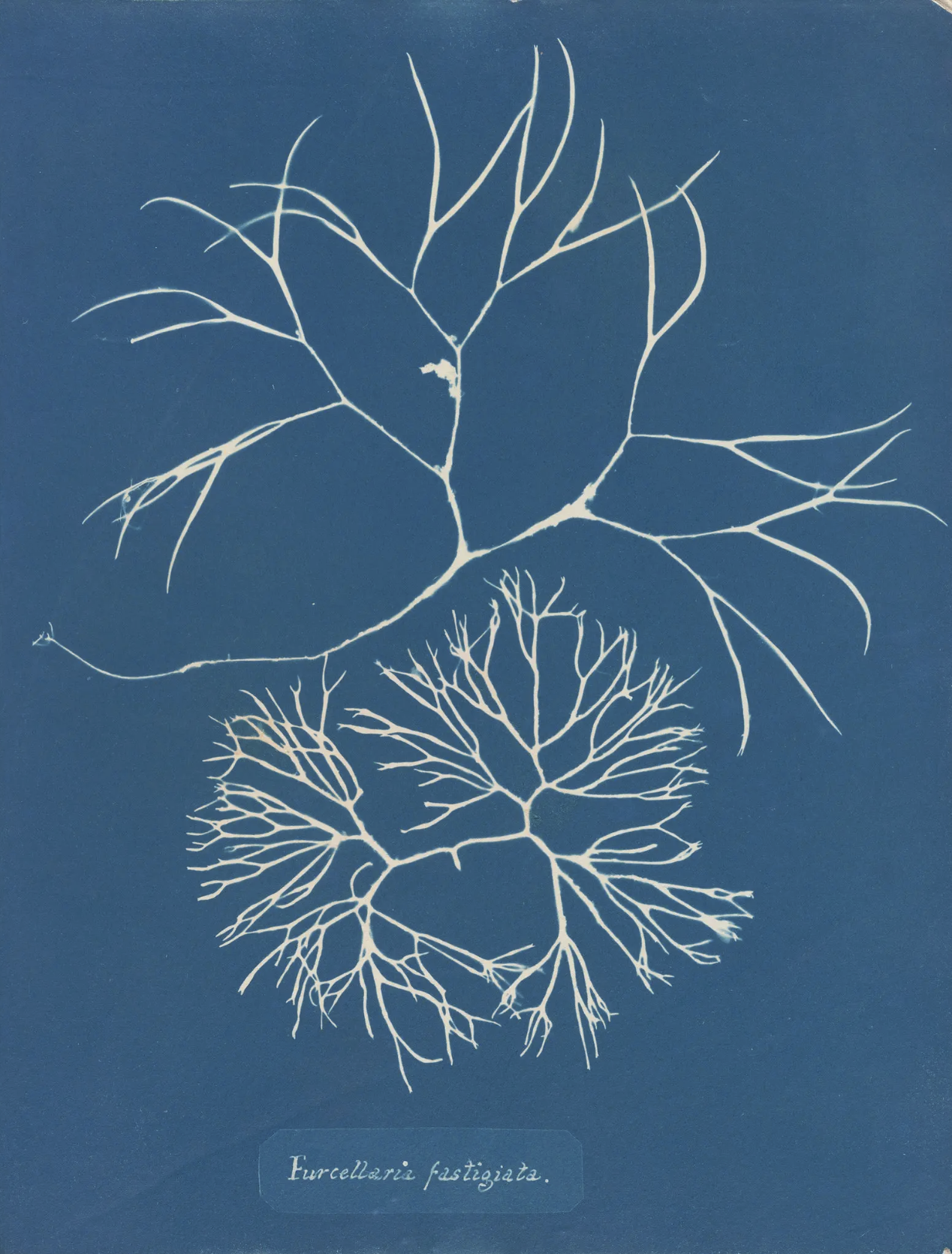 Anna Atkins, Furcellaria fastigiata,
Anna Atkins, Furcellaria fastigiata, “Photographs of British Algae,” 1846 or later, The New York Public Library, Astor, Lenox and Tilden Foundations

Towards the end of Etienne-Jules Marey’s life, he returned to studying the movement of quite abstract forms. His last great work was the observation and photography of smoke trails. (This research was partially funded by Samuel Pierpont Langley under the auspices of the Smithsonian Institution, after the two met in Paris at the Exposition Universelle, 1900.) In 1901 he was able to build a smoke machine with 58 smoke trails. It became one of the first aerodynamic wind tunnels.

The Royal Prisoner, Sir John Herschel, Anthotype made from red doubler stock (Hibiscus rosa-sinensis), 1839, Harry Ransom Humanities Research Center, The University of Texas at Austin.
 Henry Fox Talbot, Photogenic Drawing, 1840
Henry Fox Talbot, Photogenic Drawing, 1840
Laure Albin Guillot, Microphotographie, 1931, photogravure, MOMA collection

Thomas Paquet, Et pendant ce temps le soleil tourne, 2020, 92x112cm
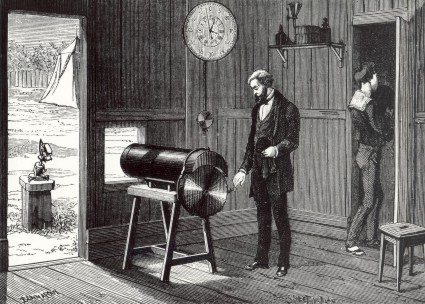

Pierre-Jules-César Janssen l'atlas de photographies solaires, 1904
